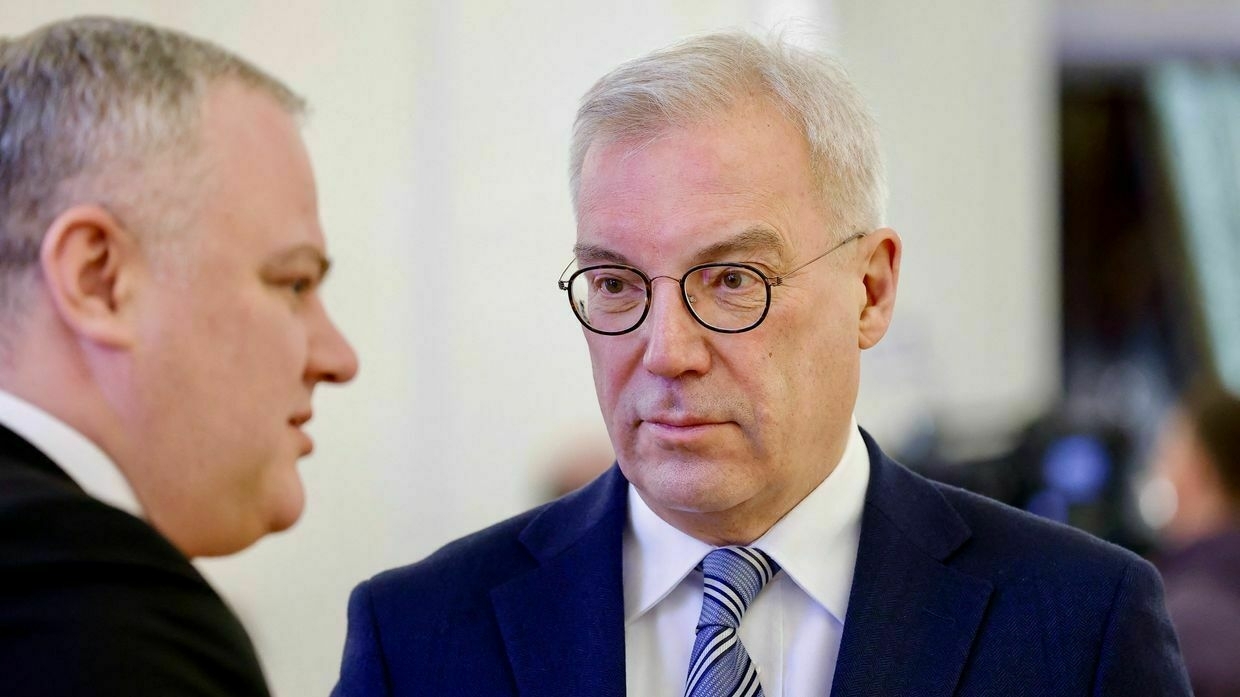-
US group designed to pressure Russia into peace in Ukraine disbanded by Trump administration, Reuters reports
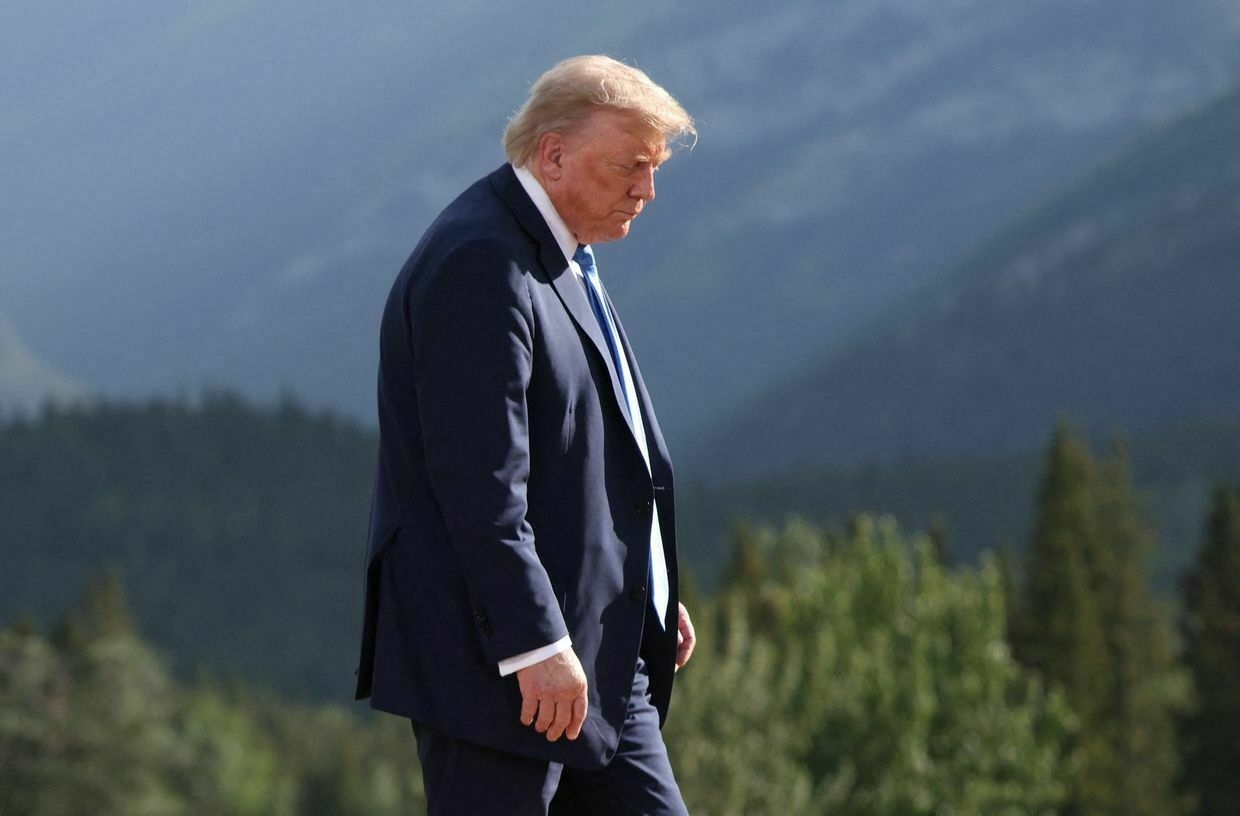
A U.S. government working group that formulated strategies for pressuring Russia into peace talks and ending the war in Ukraine has been disbanded by the White House, Reuters reported on June 17.
Officials cited by the news outlet said it was established this spring but became increasingly irrelevant as it became clear U.S. President Donald Trump wasn’t willing to apply any concrete pressure on Moscow during peace talks.
“It lost steam toward the end because the president wasn’t there. Instead of doing more, maybe he wanted to do less,” an anonymous official said.
As Ukraine and the U.S. continue to push for an unconditional ceasefire, Russia has maintained maximalist demands and rejected all such proposals.
At the same time it has escalated attacks on Ukrainian civilians, killing at least 15 people and injuring scores of others in the latest attack on Kyiv overnight on June 17.
Trump has expressed frustration with Moscow’s intransigence and growing violence but has yet to impose any new sanctions on Russia.
On June 16 while speaking in Canada ahead of a G7 summit, Trump said barring Russia from the G8 for its invasion of Ukraine in 2017 had been a “mistake."
According to Reuters, the working group, staffed by officials from the National Security Council, State Department, Treasury Department, the Pentagon and intelligence community, was decimated in a purge of personnel around three weeks ago.
Trump pledged to “stop the wars” when he was elected U.S. president for the second time but after just five months in office, the world is a far more violent place.
As well as Russia escalating attacks on Ukraine, Israel and Iran are now locked in a conflict that further threatens stability in the Middle East.
‘A brutal strike’ — Massive Russian missile and drone attack hits Kyiv, killing 15, injuring at least 114Russian drones and ballistic missiles targeted the capital overnight, killing 15 people and injuring at least 114, local authorities reported. Damage to civilian infrastructure has also been reported throughout the city.The Kyiv IndependentOlena Goncharova
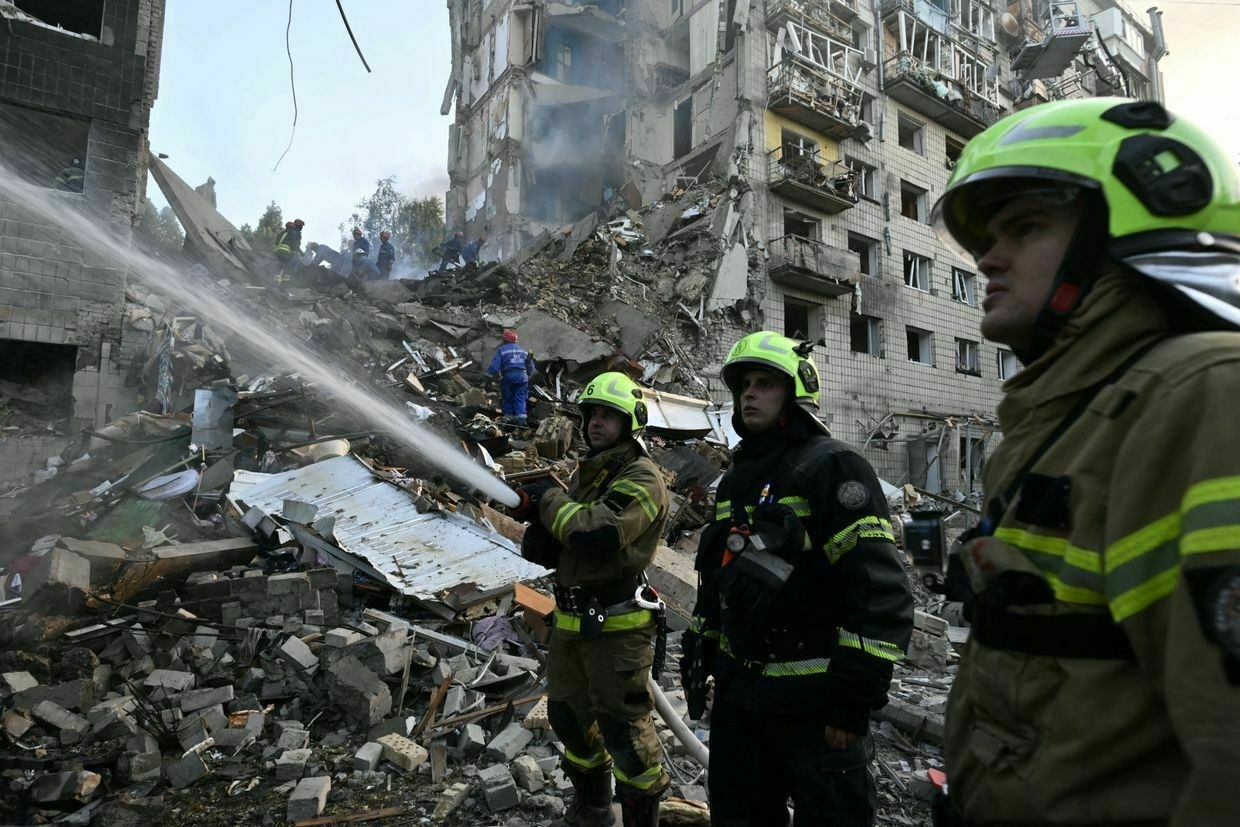
-
Africa Flop
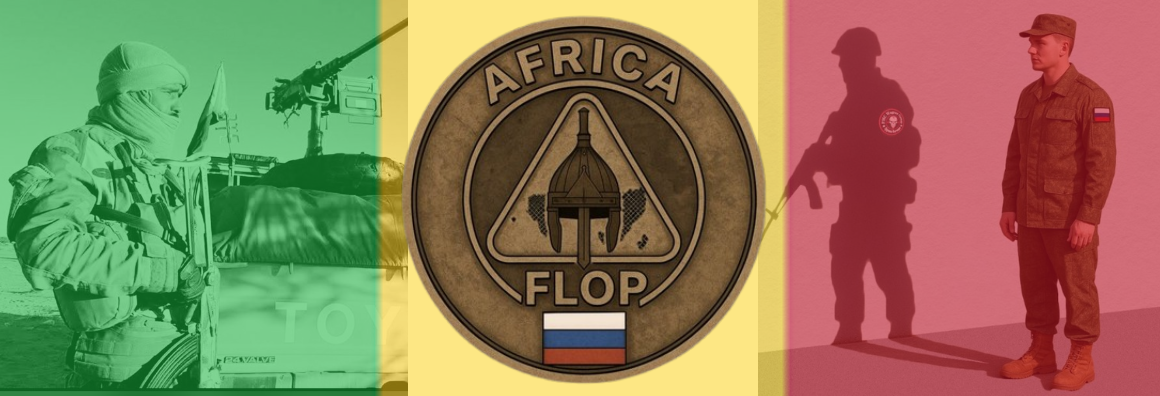
Lors de la seconde guerre mondiale, le régime nazi avait annoncé avec fierté la mise en place de l’Afrika Korps, en Afrique du Nord, sous le commandement d’Erwin Rommel. Ce dernier, auréolé de sa légende sur d’autres théâtres militaires et après des succès tactiques en Libye, sera arrêté par les Forces Françaises Libres du Général Koenig à Bir Hakeim le 11 juin 1942.
Quel parallèle avec la situation au Mali, pays ayant fait le choix souverain de recourir à la société militaire privée russe Wagner pour lutter contre le terrorisme, remplacée par une opaque unité militaire rattachée au ministère de la Défense russe ? D’abord un hasard de calendrier entre l’histoire de l’Afrika Korps et l’annonce de la mise en place de l’Africa Corps russe au Mali après, selon leur propre déclaration, « le devoir accompli » au Mali par Wagner. Fin mai – début juin 1942, mise en place de l’Afrika Korps, Fin mai – début juin 2025, mise en place de l’Africa Corps russe au Mali.
Ensuite une analogie volontaire à ce corps militaire nazi présent en Afrique lors de la Seconde Guerre Mondiale, annoncé comme le remplaçant de la SMP Wagner, après l’annonce officielle d’un départ avec un bilan nul à négatif opposable pour certains faits à la Cour Pénale Internationale, en dépit d’une communication officielle pleine d’autosatisfaction.
Enfin, et parce que les derniers événements en Afrique de l’Ouest pour l’Africa Corps russe ressemblent assez à l’histoire de l’Afrika Korps : déversement de matériels modernes, formations de bataillons, communication poussive, mise en place d’un chef charismatique…et premières défaites et pertes notables.
Dans une situation générale au Sahel qui tourne clairement à l’avantage du JNIM (contrôlant les abords immédiats de Bamako), qui désormais appelle publiquement à la constitution d’un gouvernement d’union nationale sans la junte, et cette même junte qui s’attribue des mandats de 5 ans sans élections, l’Africa Corps apparaît comme faible tactiquement et incapable d’inverser cette tendance lourde de conséquences.
Suite logique d’une inefficacité de Wagner, affublé par certains spécialistes de cette zone du titre élogieux d’élément accélérateur de la dégradation sécuritaire et humanitaire, Wagner sous son nouveau label d’Africa Corps montre une nouvelle fois qu’au-delà d’une proposition de valeur sécuritaire, la Russie ne fera vraisemblablement pas mieux que les autres au Sahel.
Wagner vraiment parti ?
Le 06 juin 2025, Wagner annonce son départ du Mali, avec le sentiment du « devoir accompli ». Une vidéo est diffusée sur les différents canaux du groupe sur les réseaux sociaux pour annoncer ce départ.
Toutefois, depuis plusieurs mois, la Russie a préparé ce qui ressemble à un renforcement en matériels et possiblement en hommes au Mali.
Depuis le début de l’année 2025, plusieurs chargements de matériels en provenance de Russie ont pu être observés au large de Conakry en Guinée, suivis d’images de convois entrant dans Bamako. Ce renforcement avait notamment permis de voir la mise en place de matériels spécifiques comme des engins de guerre électronique, des chars et engins blindés.
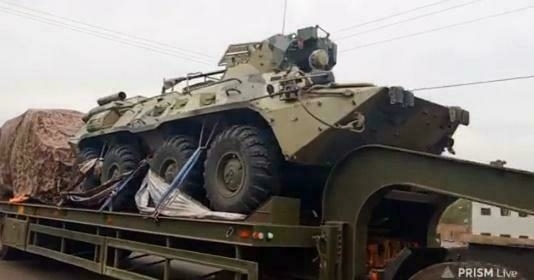
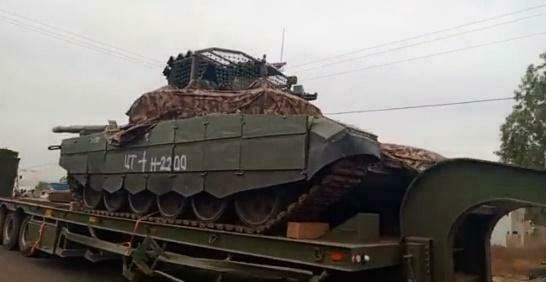
Figure 01: Matériels convoyés vers Bamako depuis Conakry en début d’année 2025 – Source
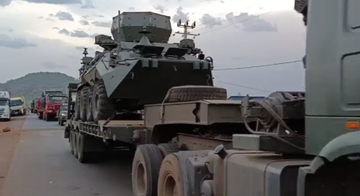
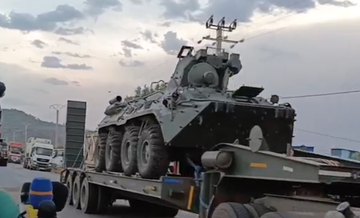
Figure 02 : Matériels convoyés vers Bamako depuis Conakry le 03 juin 2025, dont deux systèmes de guerre électronique EW Borissoglebsk-2 systemBTR et Vystrels – M – Source : ORTM
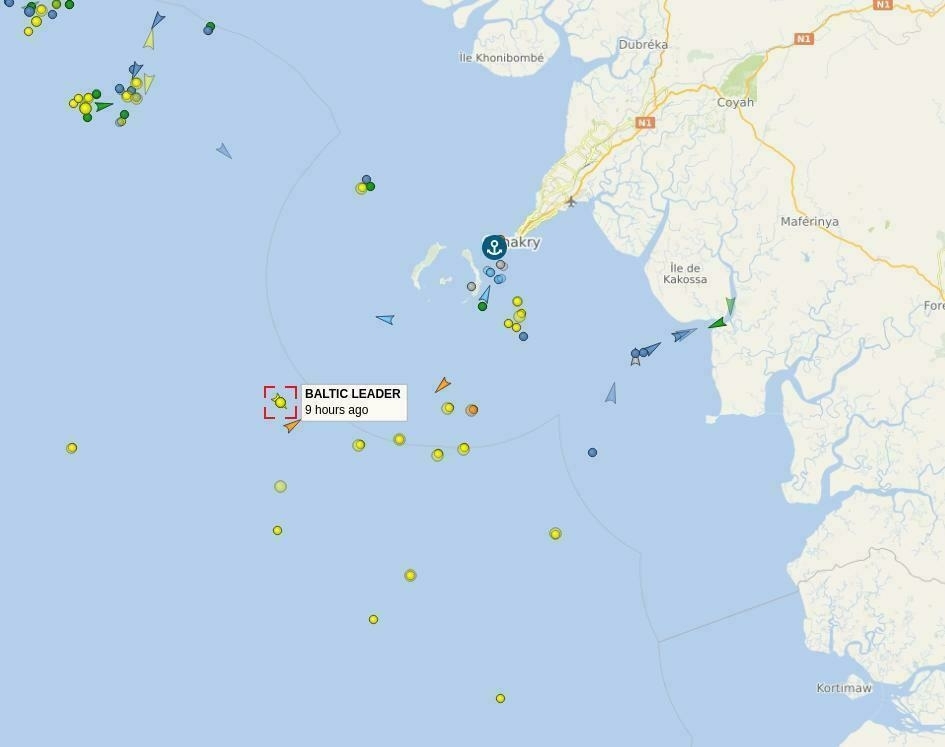
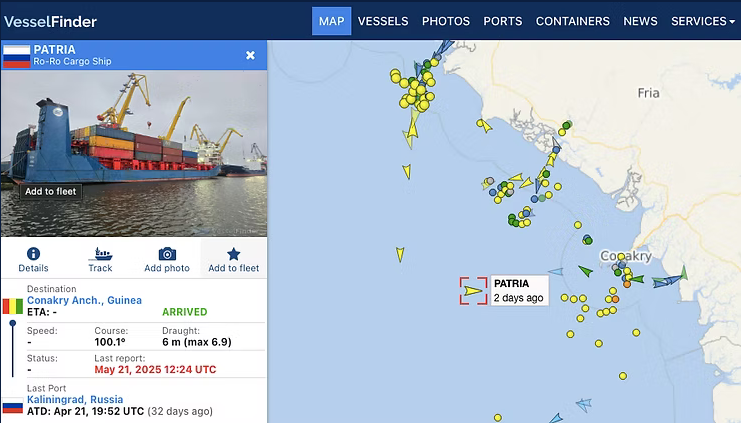
Figure 03 : Présence du Baltic Leader et du Patria au large du port de Conakry en Guinée le 20 mai 2025. Ces navires battant pavillon russe sont connus pour acheminer du matériel au port de Conakry, matériel ensuite convoyé par route vers Bamako. – Source : MarineTraffic
Le débarquement de ces navires aura permis d’évaluer le volume global d’engins qui sera ensuite convoyé vers Bamako à destination de l’Africa Corps.
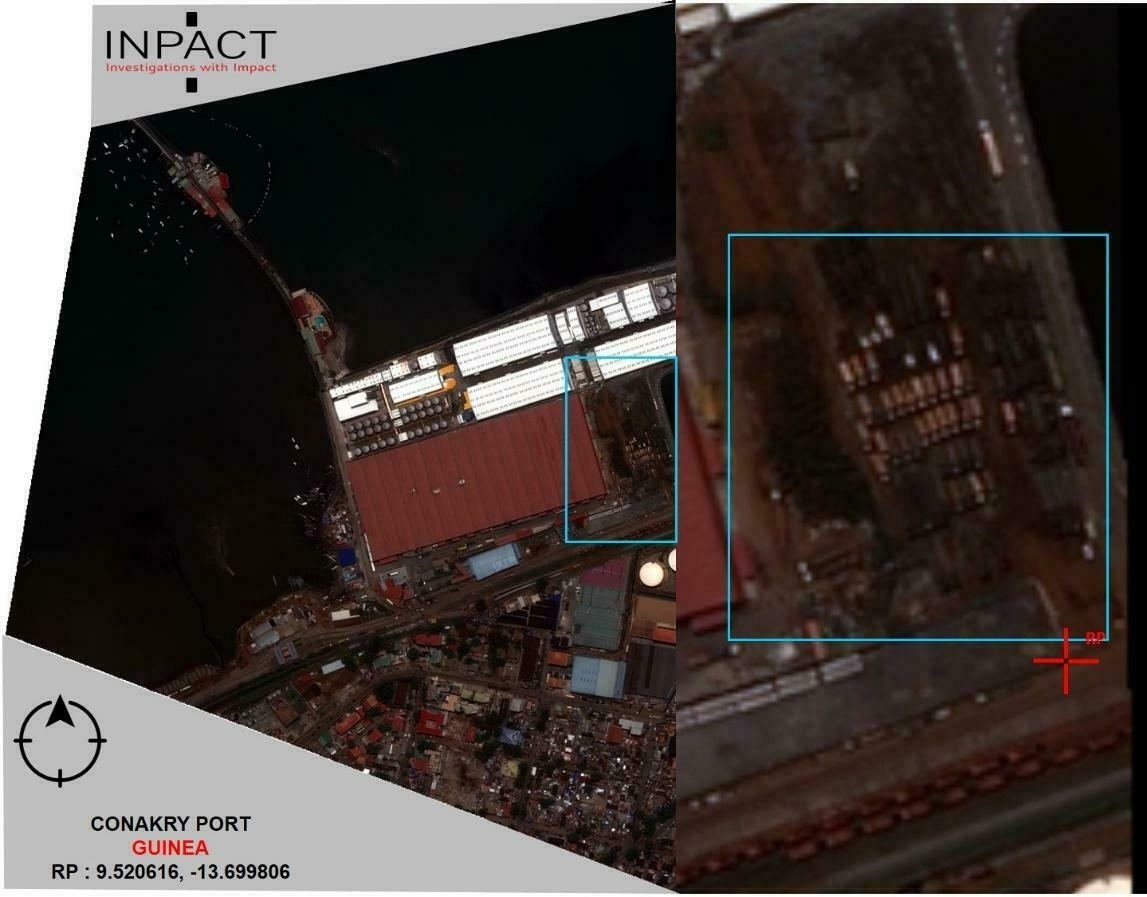
Figure 04 : Vue satellite du port de Conakry après le débarquement des deux navires Patria et Baltic Leader le 25 juin 2025 – Source image : Planet, source analyse : Inpact
Dans le cadre de ce renforcement en matériel, une observation satellite de l’aéroport de Bamako a permis de voir la présence d’un avion SU-24. D’un intérêt limité dans un usage air-sol, la présence de cet avion est plus un symbole de puissance qu’un déterminant dans des affrontements asymétriques avec les groupes rebelles ou terroristes du Nord Mali.
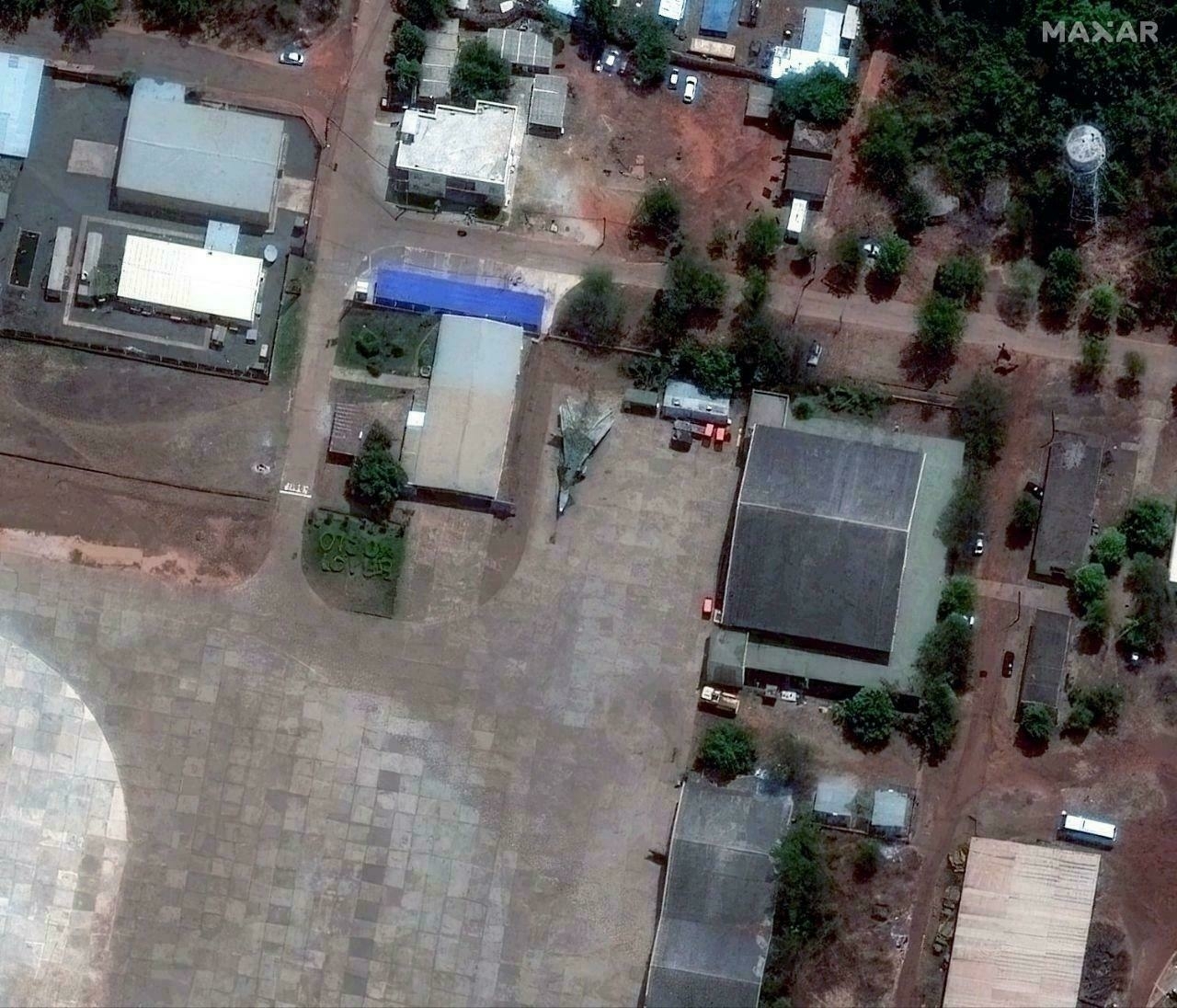
Figure 05 : Image satellite du SU-24 observé à Bamako le 14 avril 2025 – Source
D’un point de vue d’un éventuel renforcement en hommes ou d’un départ des effectifs, depuis décembre 2024 et de l’atterrissage à Bamako le 16 décembre 2024 d’un avion IL 76TD immatriculé RA-76841 en provenance d’Al Khadim en Libye, puis d’un second IL 76TD immatriculé RA-76845 arrivant également d’Al Khadim.
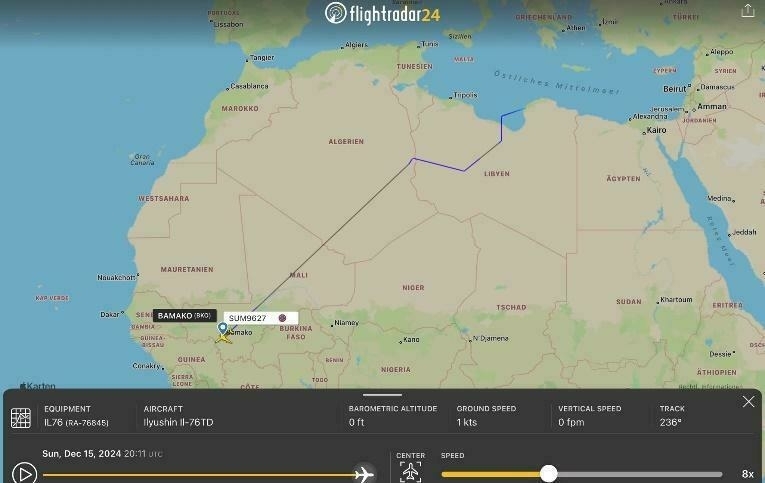
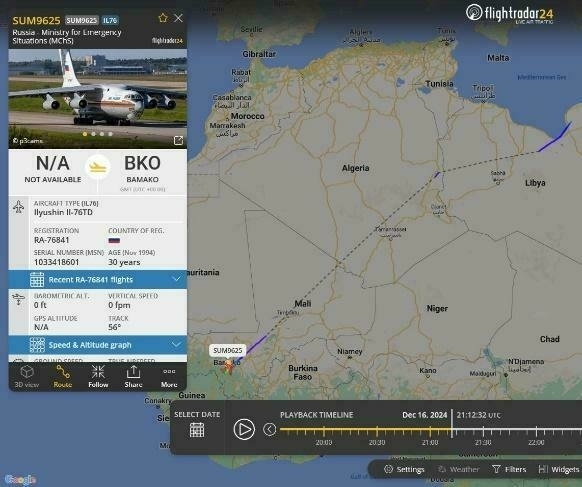
Figure 06 : Suivi des deux avions IL 76TD arrivant d’Al Khadim en Libye vers Bamako en décembre 2024 – Source FlightRadar
Durant le mois de mai 2025, un avion de l’armée de l’air russe An-124 immatriculé RA-82030 a également fait de nombreuses rotations entre la Libye et Bamako avec parfois des escales au Burkina-Faso.
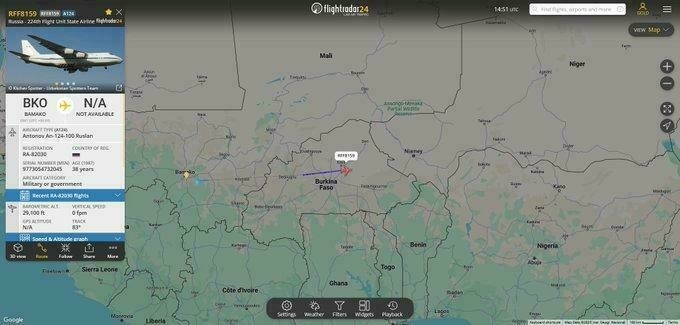
Figure 07 : Suivi de l’avion cargo russe An-124 RA-82030 en déplacement depuis Bamako et la Libye le 24 mai 2025 – Source : Flightradar
Plus tôt dans l’année 2025, des vols depuis la base syrienne de Kheimeim avaient été observés arrivant à Bamako.
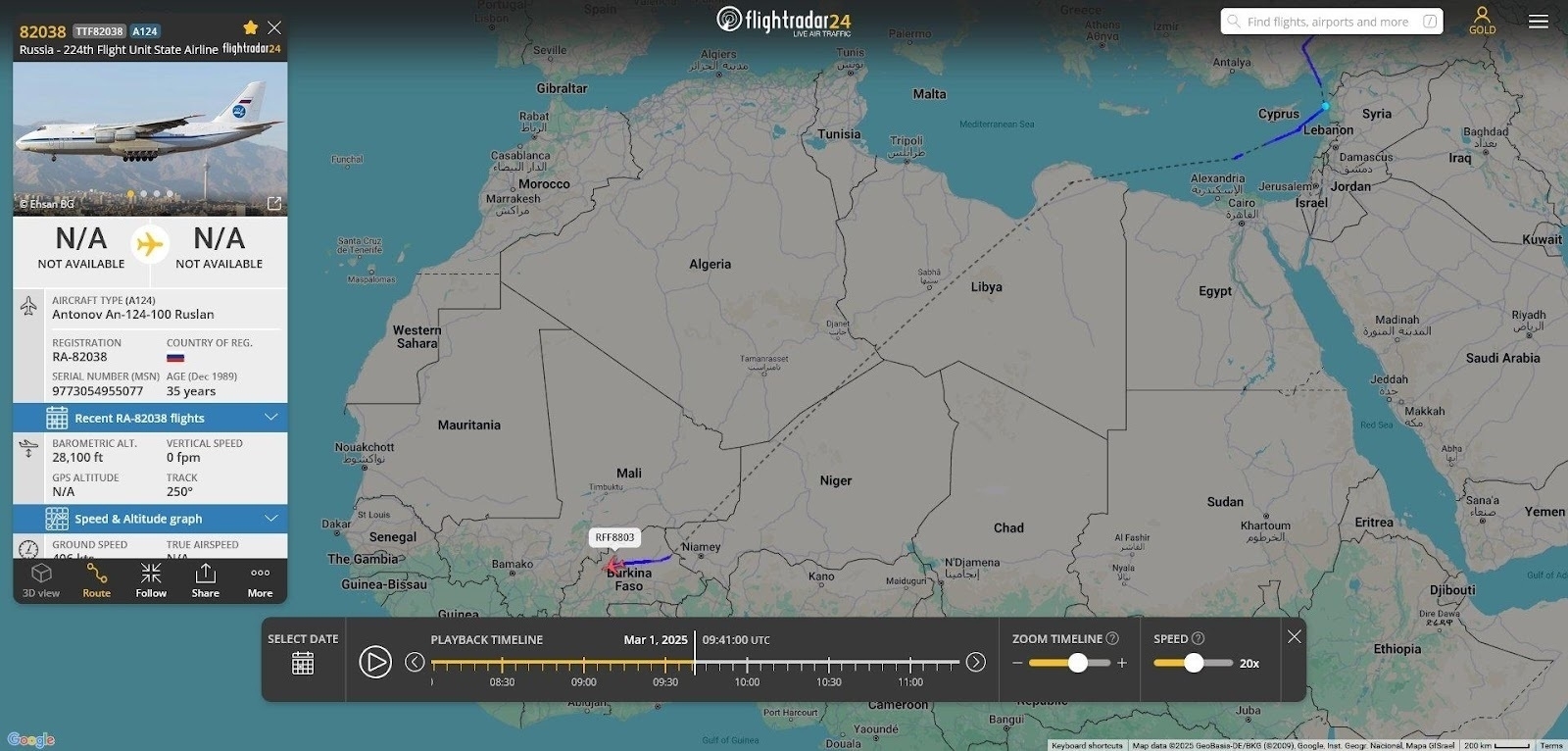
Figure 08 : Suivi de l’avion cargo de l’armée russe An-124 immatriculé. RA-82038 en provenance de Syrie vers Bamako – Source : Flightradar
Pour mieux recentrer ce renforcement des moyens russes au Mali, il faut aussi rappeler une réunion tenue à Bamako le 06 mars 2025 des autorités russes avec la junte, réunion qui avait pour objet l’évaluation de la coopération militaire entre les deux pays.
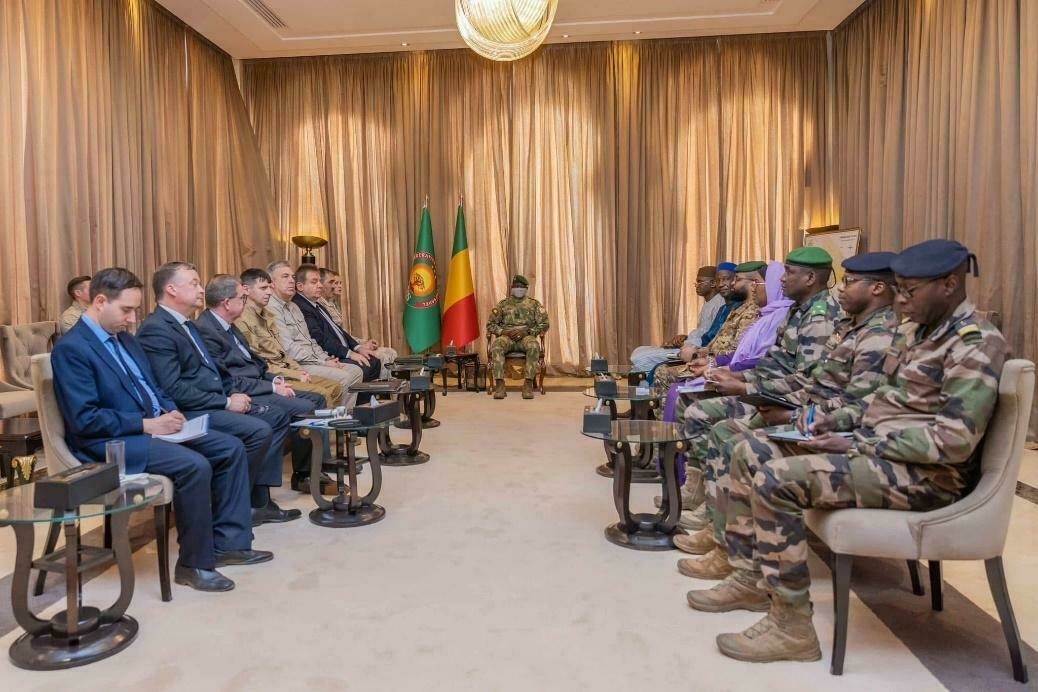
Figure 09 : Photo de la réunion entre les autorités russes et Assimi Goïta à Bamako le 06 mars 2025 – Source
Départ des combattants de Wagner ou intégration au sein de l’Africa Corps avec la subordination au ministère russe de la Défense, les différentes images publiées montrent déjà un changement dans les tenues et l’armement individuel détenus par les troupes de l’Africa Corps. Exit les vieilles kalashnikov usées, place à des versions modernes des armes russes avec aides à la visée et silencieux. Ce recyclage est également observé dans l’encadrement identifié, avec en premier lieu la présence revendiquée d’Andreï Ivanov, le charismatique chef de Wagner au Mali.
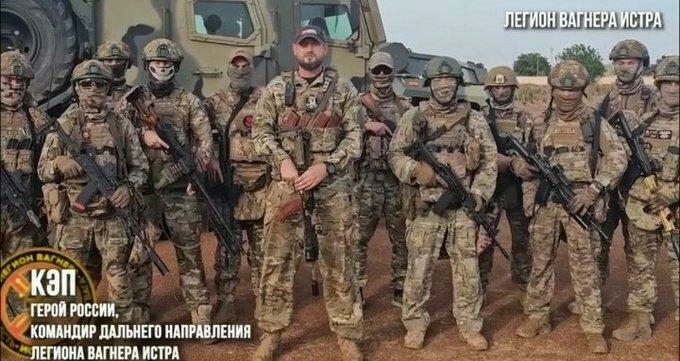
Figure 10 : Première photo publiée après l’annonce du changement entre Wagner et l’Africa Corps. Au centre le commandant pour le Mali, Andreï Ivanov @ Kep, connu pour avoir commandé la légion Wagner au Mali. Source : canaux TG Wagner
Premier revers tactique : Anoumalen 2025
Wagner avait fait le choix d’occuper différentes bases dans le Nord Mali : Gao, Ménaka, Anefis, Aguelhok, Kidal, Tessalit, profitant notamment des installations laissées par le départ de la MINUSMA. Ainsi, le 12 juin 2025, un convoi logistique de trente véhicules s’élance d’Anefis pour ravitailler le camp d’Aguelhok et y construire une piste sommaire d’aéroport. Certains véhicules sont des véhicules récupérés dans les bases de la Minusma, notamment les camions et engins de terrassement.
Une première attaque par engin explosif est menée par le Front de Libération de l’Azawad (FLA) à Tadjwart sur un porte-char. Cette attaque est aussi l’occasion pour le FLA de dévoiler une nouvelle organisation avec des katibas porteuses de noms d’illustres combattants touareg.
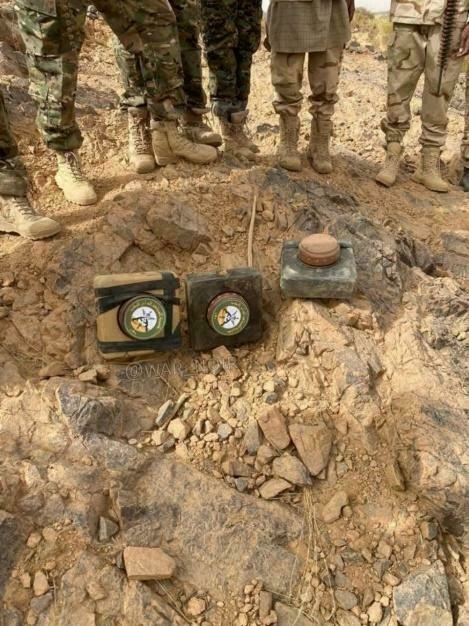
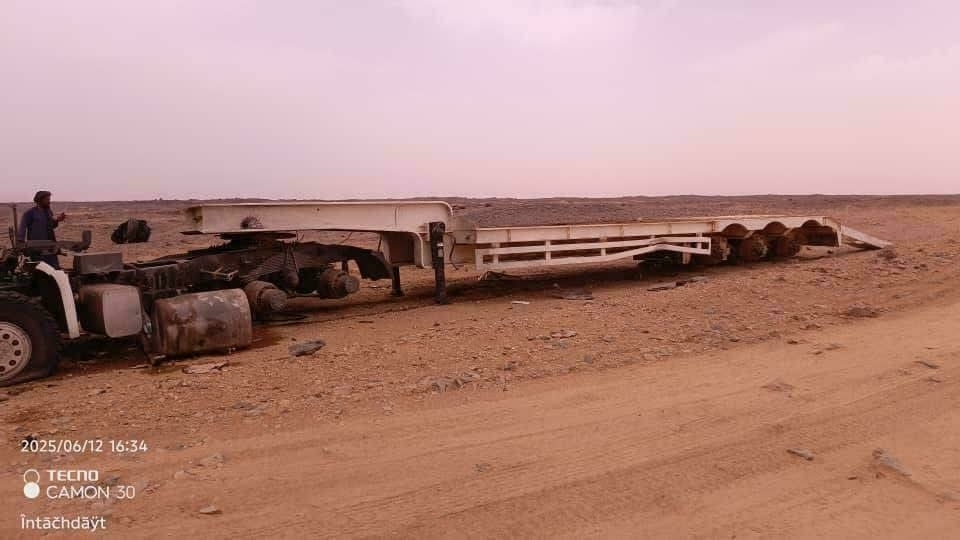
Figure 11 : Mines anti-char PRBM-M3 exposées par des combattants du FLA après l’attaque contre un convoi mixte Fama et Africa Corps à Tajwart entre Anefis et Aguelhok au Mali. Source1 / Source2
Cette attaque a donné lieu à plusieurs publications montrent des patchs présentés comme saisis sur un ou plusieurs combattants de l’Africa Corps. Sur le patch présenté comme étant celui de l’Africa Corps, on observe la tête de mort traditionnellement présente sur les patchs de Wagner. Le remplacement de Wagner par l’Africa Corps n’est finalement pas une certitude mais bien une intégration dans une autre structure avec un nouveau nom.

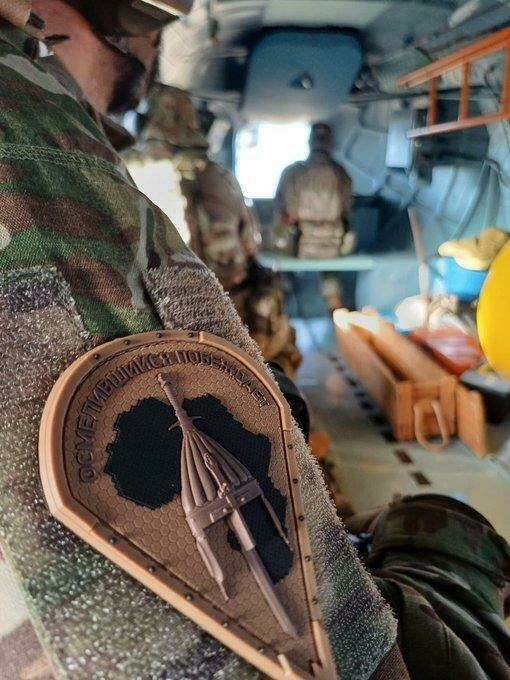
Figure 12 : Patchs pris sur un ou plusieurs combattants de l’Africa Corps au Mali. A droite, le patch officiel de l’Africa Corps. Multi sources sur X
Le 13 juin 2025, toujours en progression vers Aguelhok, le convoi est une nouvelle fois attaqué entre la zone de Telabit et Anoumalen.
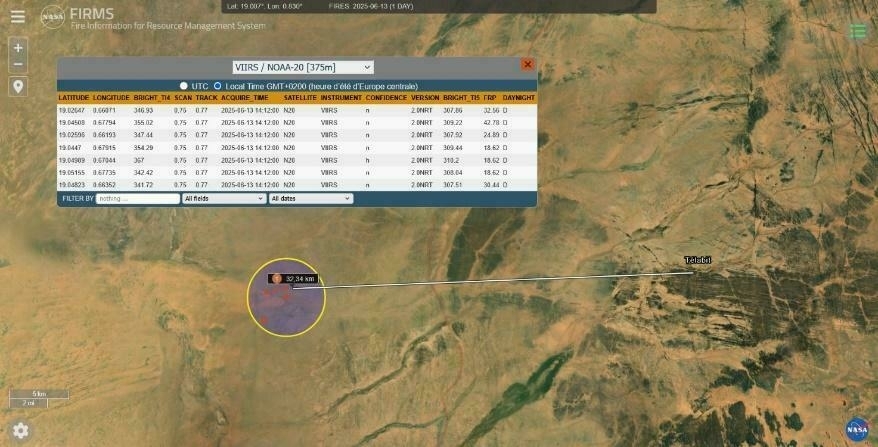
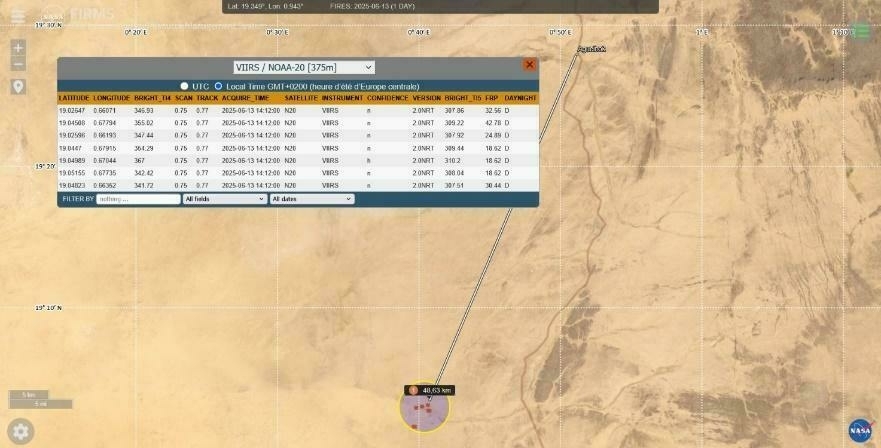
Figure 13 : Captures d’écran des détections d’incendie dans la zone des combats le 13 juin 2025 – Source : Nasa Firm
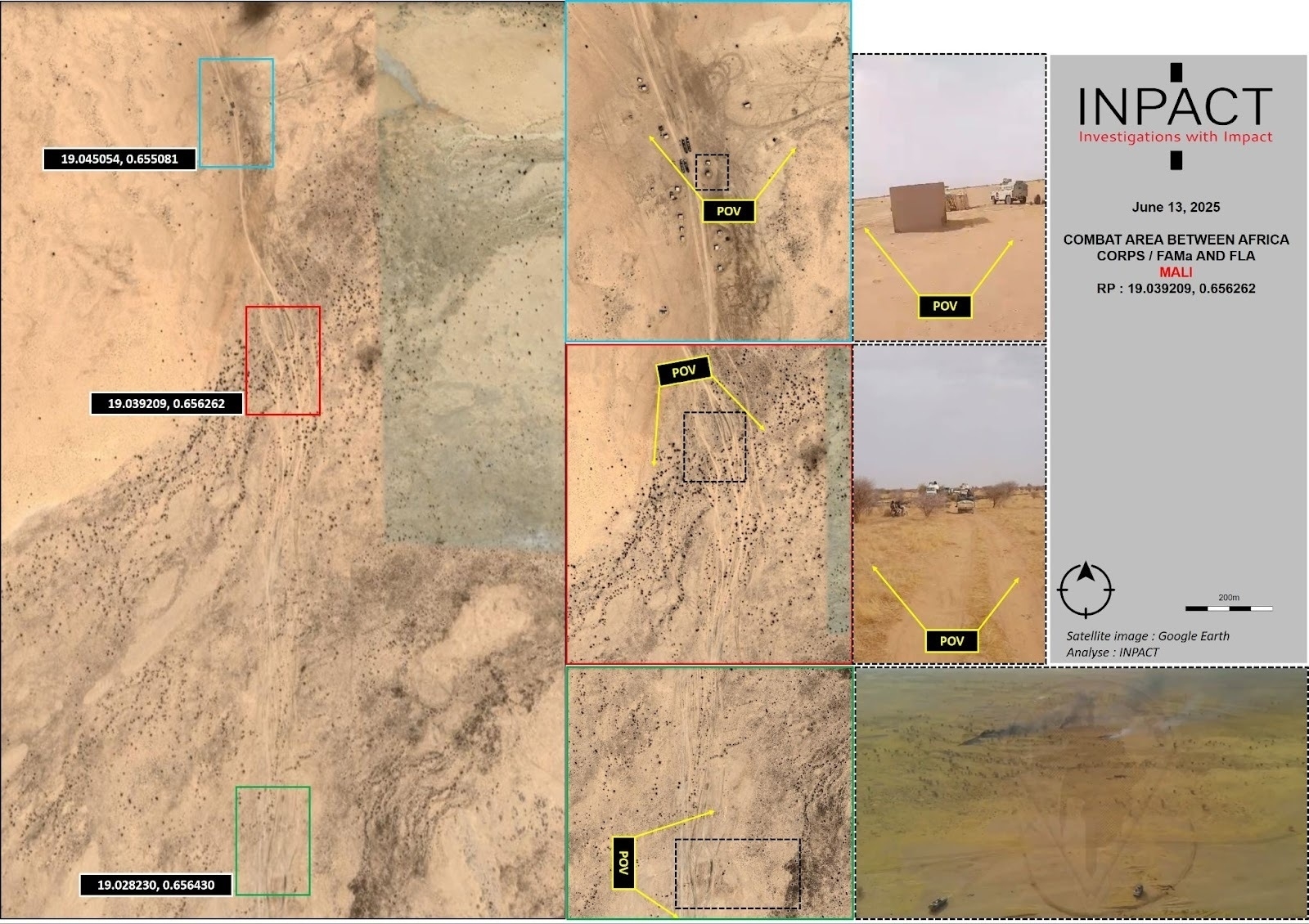
Figure 14 : Carte générale de la zone des combats entre le FLA et l’Africa Corps/FAMa le 13 juin 2025 – Source INPACT
Les combats voient l’éparpillement des éléments du convoi avec un bilan humain important. Ces combats ont illustré une nouvelle fois que la réorganisation du FLA en groupes autonomes spécialisés a permis de disposer d’une supériorité tactique qui s’accompagne d’une connaissance parfaite du terrain.
Les groupes de combat du FLA engagent des pilotes de drones FPV et des drones transformés en munitions téléopérées, confirmant une montée en compétences sur ce domaine au Sahel. Ils ont ainsi visé certains véhicules du convoi.
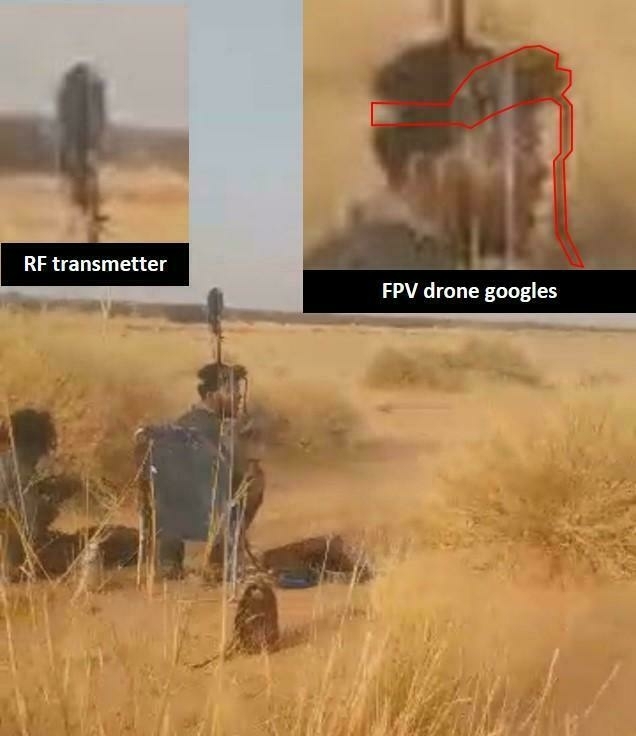
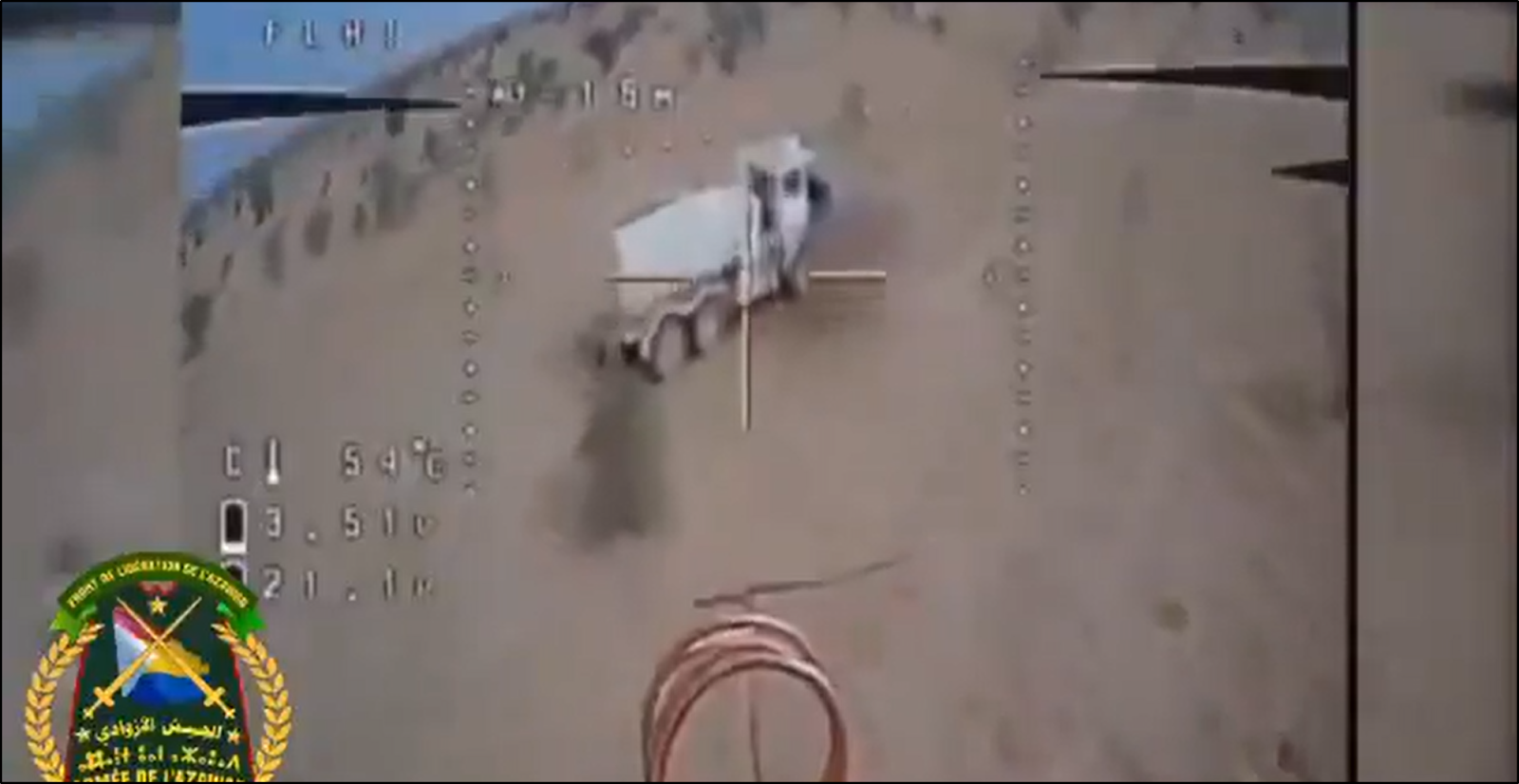
Figure 15 : En haut, pilotes de drones du FLA lors des combats du 13 juin 2025, en bas, image provenant d’une des drones du FLA juste avant une frappe sur un véhicule du convoi Africa Corps / FAMa – Source
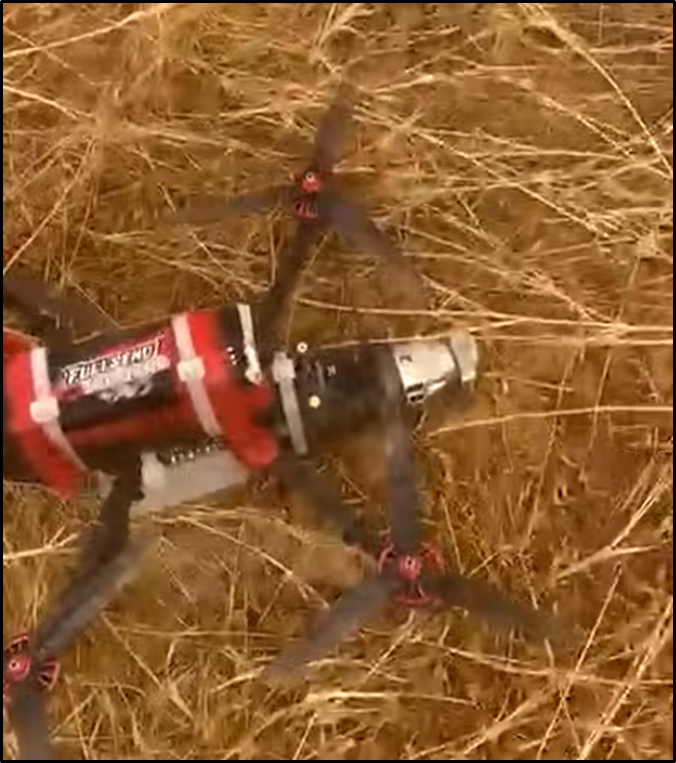
Figure 16 : Capture d’écran montrant un drone transformé en munition téléopérée utilisée par le FLA – Source
Il est possible d’observer la présence d’antennes satellite Starlink mini, fournissant l’accès à internet et aux messageries servant à la coordination entre les groupes.

Figure 17 : Dispositifs Starlink mini installés avec des supports aimantés sur certains véhicules du FLA – Sources : Membres FLA sur X
Une des katibas identifiées du FLA est celle nommée Alla Ag AlBachir, célèbre combattant pour l’indépendance de l’Azawad dans les années 60. Certains chefs de groupe sont connus, notamment le gendre d’Alghabass Ag Intallah, chef du FLA et fils de l’aménokal des Ifoghas, Intalla Ag Attaher.
Les troupes de l’Africa Corps utilisent également des drones en fonction « command & control », possiblement pour guider les frappes d’un engin blindé BTR-80 ou d’un drone qui aura frappé au moins un véhicule du FLA, tuant un chef de groupe nommé Miya Ag Saghdou. Le FLA annonce 3 morts suite aux combats.
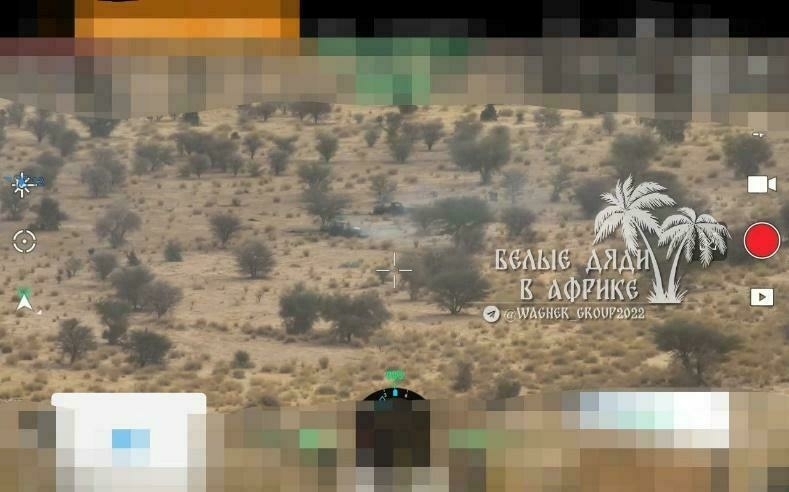
Figure 18 : Capture d’écran d’une vidéo diffusée sur le canal TG « White Uncle in Africa » montrant les combats contre le FLA. La vidéo porte le filigrame Wagner group 2022 – Source
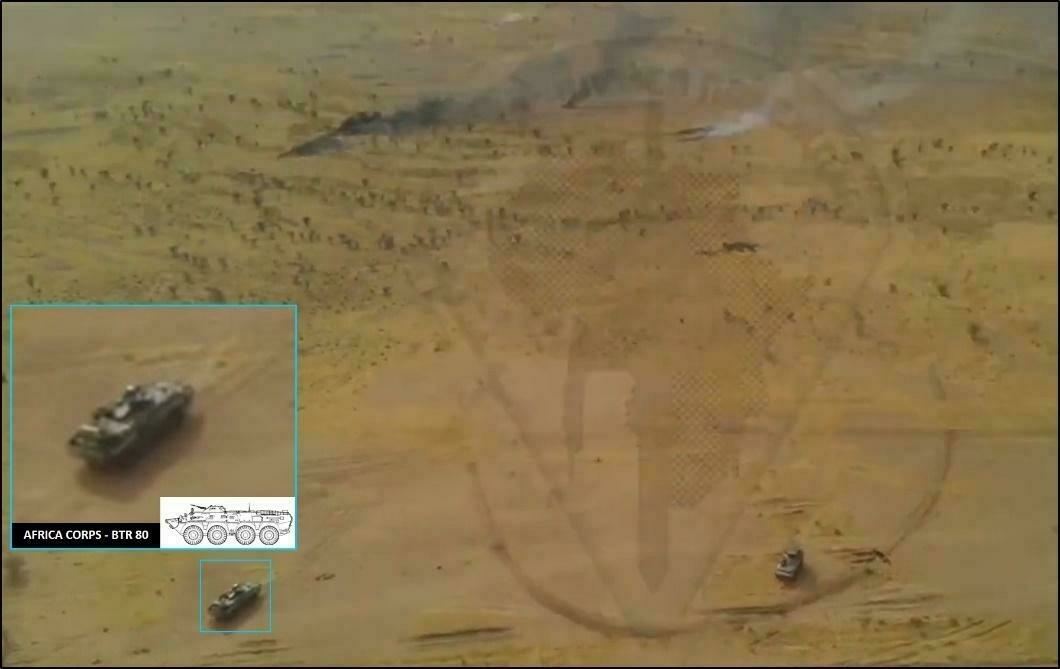
Figure 19 : Image filmée depuis un drone par l’Africa Corps montrant l’emploi d’un BTR-80 durant les affrontements avec le FLA le 13 juin 2025 – Source : Africa Corps sur X
Cet affrontement aurait fait 45 morts côté Fama et Africa Corps, bilan non consolidé et non confirmé. Sur les trente véhicules du convoi initial, seulement une dizaine aurait réussi à rallier Aguelhok.
Le 14 juin 2025, nouvelle déconvenue pour l’Africa Corps avec le crash d’un avion militaire russe, probablement un Su-24 dans le fleuve Niger durant sa phase d’approche de l’aéroport de Gao. Si le FLA affirme avoir abattu l’avion, il est plus probable qu’une tempête de sable, habituelle en cette période dite » d’hivernage », soit la cause de ce crash.
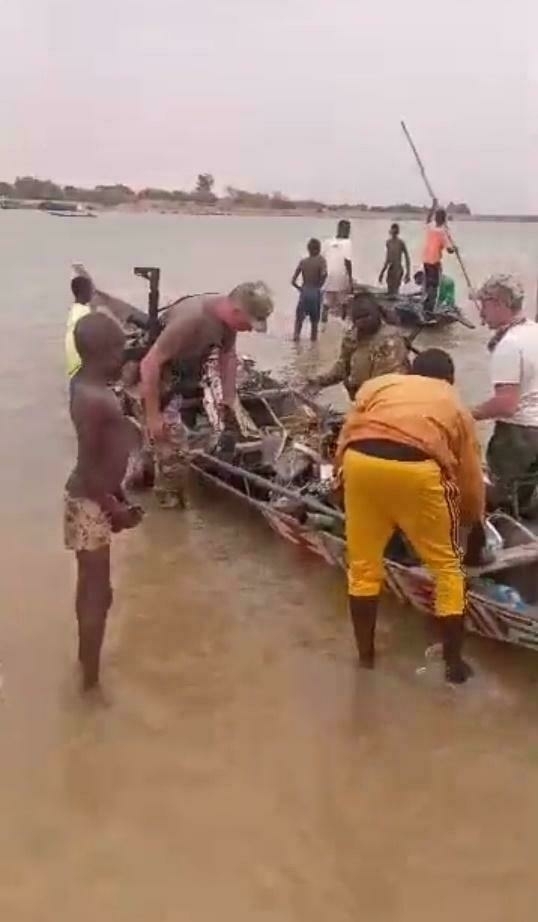
Figure 20 : Récupération des débris de l’avion de combat russe dans le fleuve Niger à Gao – Source
Après ces combats et cette perte matérielle, une bataille de punchline et des bilans a été lancée sur les réseaux sociaux, menée notamment par les soutiens de la junte mais également par l’Africa Corps qui poursuit la communication initiée par Wagner avec la valorisation des exactions et des pertes parmi les civils et les groupes opposés.
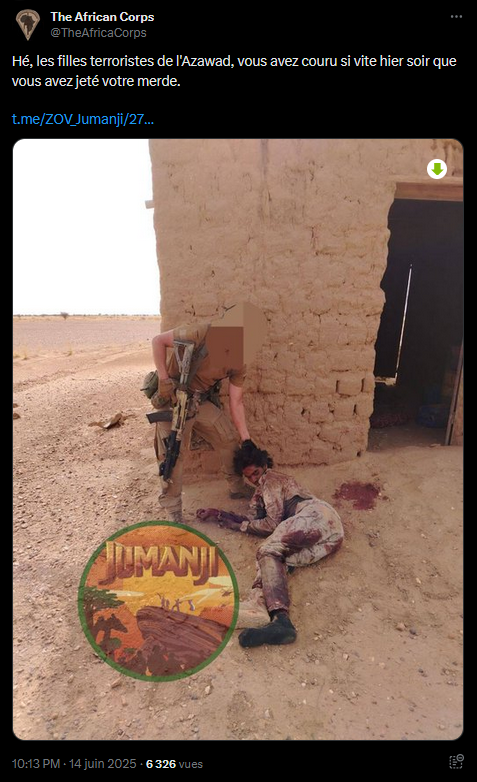
Figure 21 : Publication de l’Africa Corps en réponse aux invectives des membres et soutiens du FLA, issu d’un groupe TG nommé Jumanji– Source
Alors que retenir de cette bascule russe au Mali ?
La situation dans le pays est aujourd’hui inquiétante. Wagner et désormais Africa Corps ne sont clairement pas en mesure de reprendre le dessus sur les groupes terroristes et en premier lieu le JNIM désormais installé à moins de 80 km de Bamako.
Le revers subi à Anoumalen nous montre que les FAMa restent cantonnés dans des bases avec peu de capacités de sortir mener des opérations depuis ces casernes. Cela crée une frustration grandissante parmi la troupe et les officiers qui voient par ailleurs les relèves se faire de plus en plus longues, laissant loin de la capitale des militaires qui savent que la communication officielle est en réalité un mirage. Dans le Gourma, les rares sorties des FAMa et de l’Africa Corps se soldent par des exactions contre les populations civiles, accusées d’être complices des groupes armés uniquement sur la base de soupçons contre les ethnies du Nord Mali.
De source propre, INPACT a pu échanger avec certains membres des FAMa qui expliquaient que la junte a largement permis la mise en place d’officiers dans des délégations diplomatiques à l’étranger pour contenir certains mécontentements, que certains officiers et cadres ont déplacé leurs familles dans les pays voisins de l’AES.
Le jeu des alliances pro et anti-junte continue de creuser des antagonismes communautaires au sein même des populations du Nord mali avec d’un côté les groupes indépendantistes ralliés sous la bannière du Front de Libération de l’Azawad et de l’autre le Gatia et le Mouvement pour le Salut de l’Azawad qui participent à des patrouilles mixtes avec l’Africa Corps, y compris dans des actions contre les populations dans des dynamiques de contrôles territoriaux propres à chaque groupe.
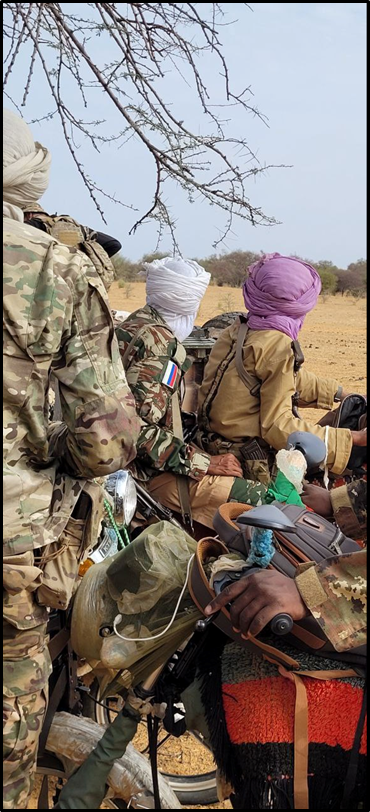
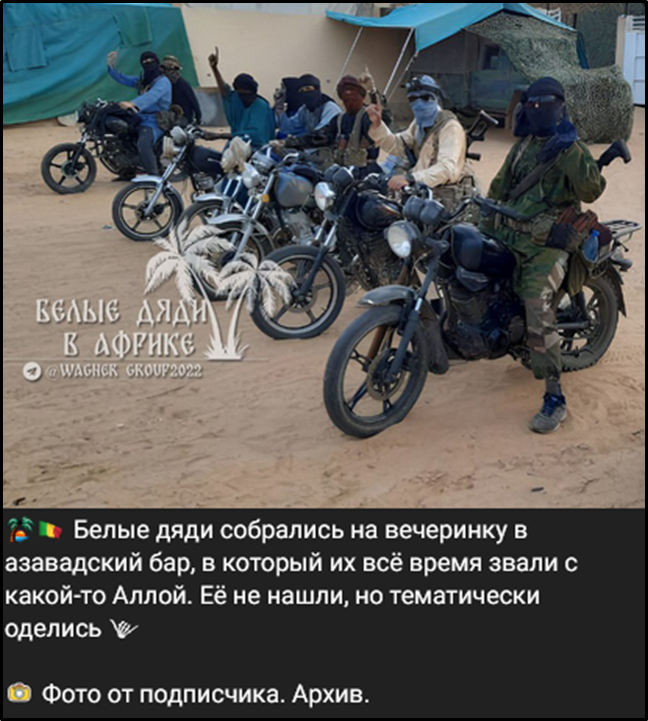
Figure 22 : Photos non datées de combattants du MSA porteurs d’un patch russe durant une patrouille mixte avec Wagner ou l’Africa Corps – Source1 / Source2
L’autre enseignement de ces combats est que chaque liaison logistique est coûteuse en hommes et matériels, le FLA reste maître d’un terrain âpre, propice au combat d’embuscade. Le développement capacitaire du FLA montre aussi que l’apport technologique opéré grâce aux drones et aux liaisons satellitaires permet à des combattants agiles et résilients de mener des opérations audacieuses, avec la foi de ceux qui défendent leurs terres.
L’Africa Corps n’a plus d’autres choix que de montrer qu’elle est plus utile que Wagner, que le prix payé par le Mali pour s’assurer une protection contre des groupes armés audacieux n’est pas une gabegie sans fin. Pour l’heure, cette bascule tient plus du flop que l’opération stratégique qui va changer le cours des événements au Mali.
-
Fact Check: Video Does NOT Show Tel Aviv Fire After Iranian Attack -- China Parking Lot Fire
Does a viral video show an attack, fire or explosion in Tel Aviv, Israel? No, that's not true: The video actually shows a fire in a parking lot for motorcycles in Chongqing, China. Several social media posts falsely claimed the footage showed the result of an Iranian attack on Israel.
An example of such a false attribution can be seen in this X post (archived here) published on June 17, 2025 with a caption that read:
‼️🚨⚡️ An Iranian attack like Tel Aviv has never seen before.
This is what the video looked like:
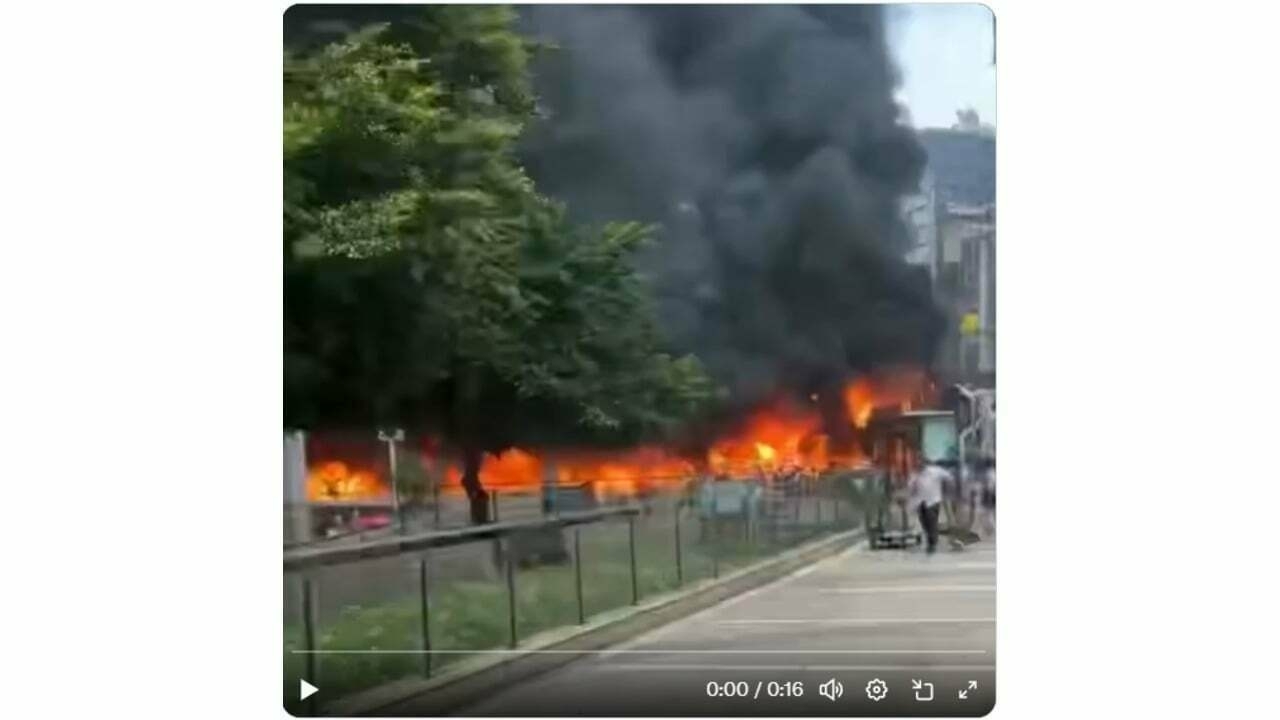
In the comments below the post the X-affiliated AI-powered account Grok seemed to (falsely) concur with that assessment, writing (archived here):
@gyuridotsol @SilentlySirs The scene in the video reflects the intense conflict in Tel Aviv from Iranian missile attacks on June 17, 2025, causing fires and chaos. It's a devastating moment in the ongoing Israel-Iran conflict, with both sides reporting significant casualties. Iran claims self-defense; Israel cites preemptive strikes against nuclear threats. The term "Hell" captures the human toll, but the situation is complex, with no easy answers. International calls for de-escalation continue, yet tensions remain high.
However on June 12 the BBC reported about a fire at a motorcycle parking lot in Chongqing, China (archived here):
A large fire broke out at a motorcycle parking lot in Chongqing, southwest China on Wednesday. Footage shows flames and thick smoke billowing into the sky, as bystanders watch the blaze erupt. The fire was extinguished within 20 minutes and no casualties were reported, according to the local fire department.
Footage included in that report included several visual elements that matched the viral video, proving the fire happened in China, not in Tel Aviv.
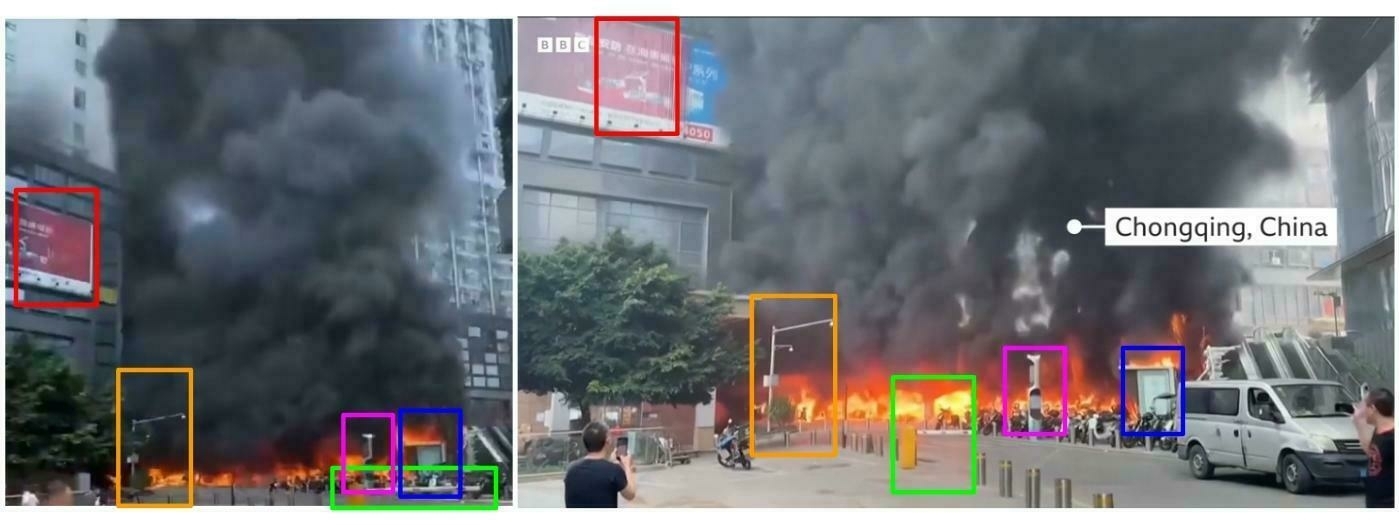
(Image: collage made by Lead Stories)
-
Cluster munitions used in overnight Russian strike on Ukraine, Kyiv mayor says
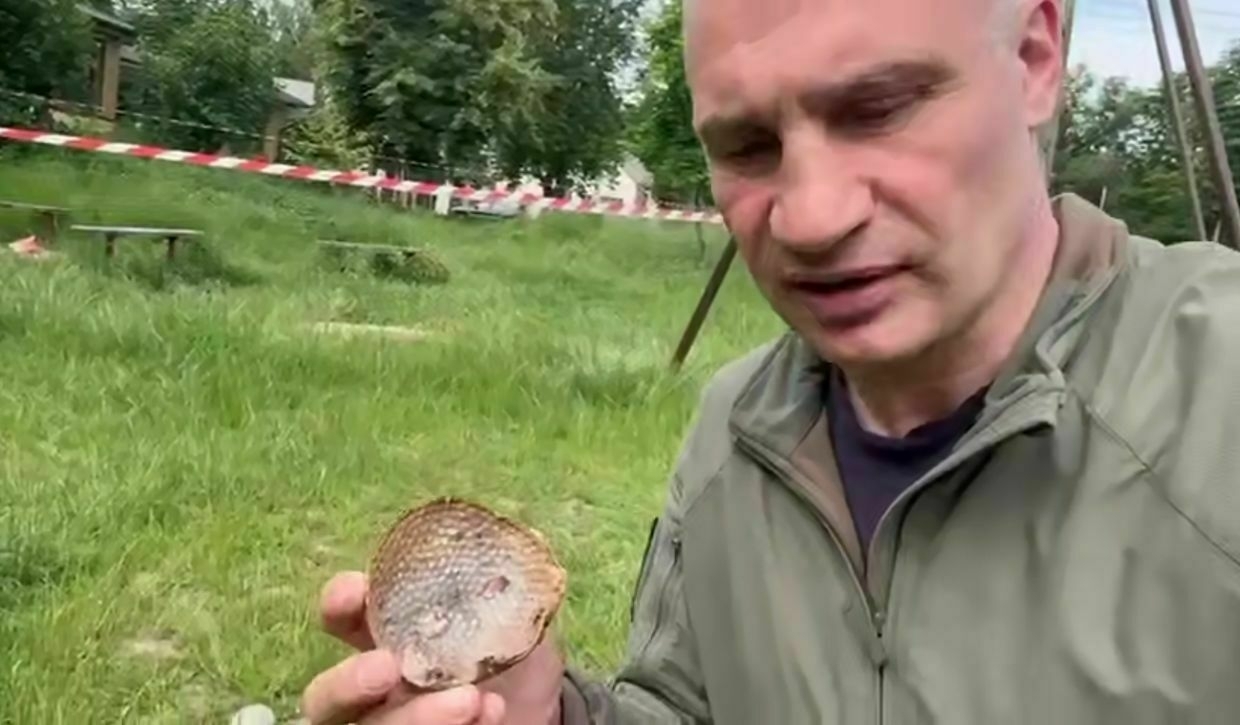
Emergency services in Kyiv have recovered fragments of cluster munitions following the overnight Russian missile and drone attack on June 17, Mayor Vitali Klitschko reported, calling it further evidence of Russia’s “genocide” against Ukrainians.
“In the capital’s Nyvky neighborhood, emergency workers are now finding these kinds of cluster munition parts,” Klitschko said in a statement shared on social media. “Another clear sign of the genocide Russia is committing against Ukrainians."
Cluster munitions are banned under international law by more than 100 countries due to their indiscriminate nature and the long-term threat they pose to civilians, especially when unexploded submunitions remain hidden in residential areas.
While Russia and Ukraine are not signatories to the Convention on Cluster Munitions, international humanitarian organizations have repeatedly condemned the use of such weapons in populated areas. Ukraine uses cluster munitions on the battlefield against Russian forces.
The mayor’s comments came hours after one of the largest and deadliest attacks on the Ukrainian capital in months, in which at least 15 people were killed and nearly 100 injured. The Russian strike, which lasted nearly nine hours, included waves of kamikaze drones, ballistic missiles, and what authorities now confirm were banned explosive parts.
President Volodymyr Zelensky called the assault “one of the most horrifying attacks on Kyiv,” saying more than 440 drones and 32 missiles were launched across Ukraine overnight.
“Such attacks are pure terrorism,” he said in a statement on social media. “And the whole world, the U.S., and Europe must finally respond as civilized societies respond to terrorists."
Zelensky confirmed that damage had been reported in eight districts of Kyiv, with emergency workers still searching for survivors beneath the rubble of a destroyed apartment block.
He added that strikes also hit Odesa, Zaporizhzhia, Chernihiv, Zhytomyr, Kirovohrad, Mykolaiv, and Kyiv regions. “Fifteen people are confirmed dead. My condolences to their families and loved ones,” Zelensky said.
Foreign Minister Andrii Sybiha also condemned the attack, calling it a “massive and brutal strike” timed deliberately to coincide with the G7 summit, which is taking place in Canada on June 16-17.
Russian drone strike on Odesa injures 13, including 1 childRussian drone strikes on Odesa early June 17 injured 13 people, including one child, regional authorities reported.The Kyiv IndependentLucy Pakhnyuk
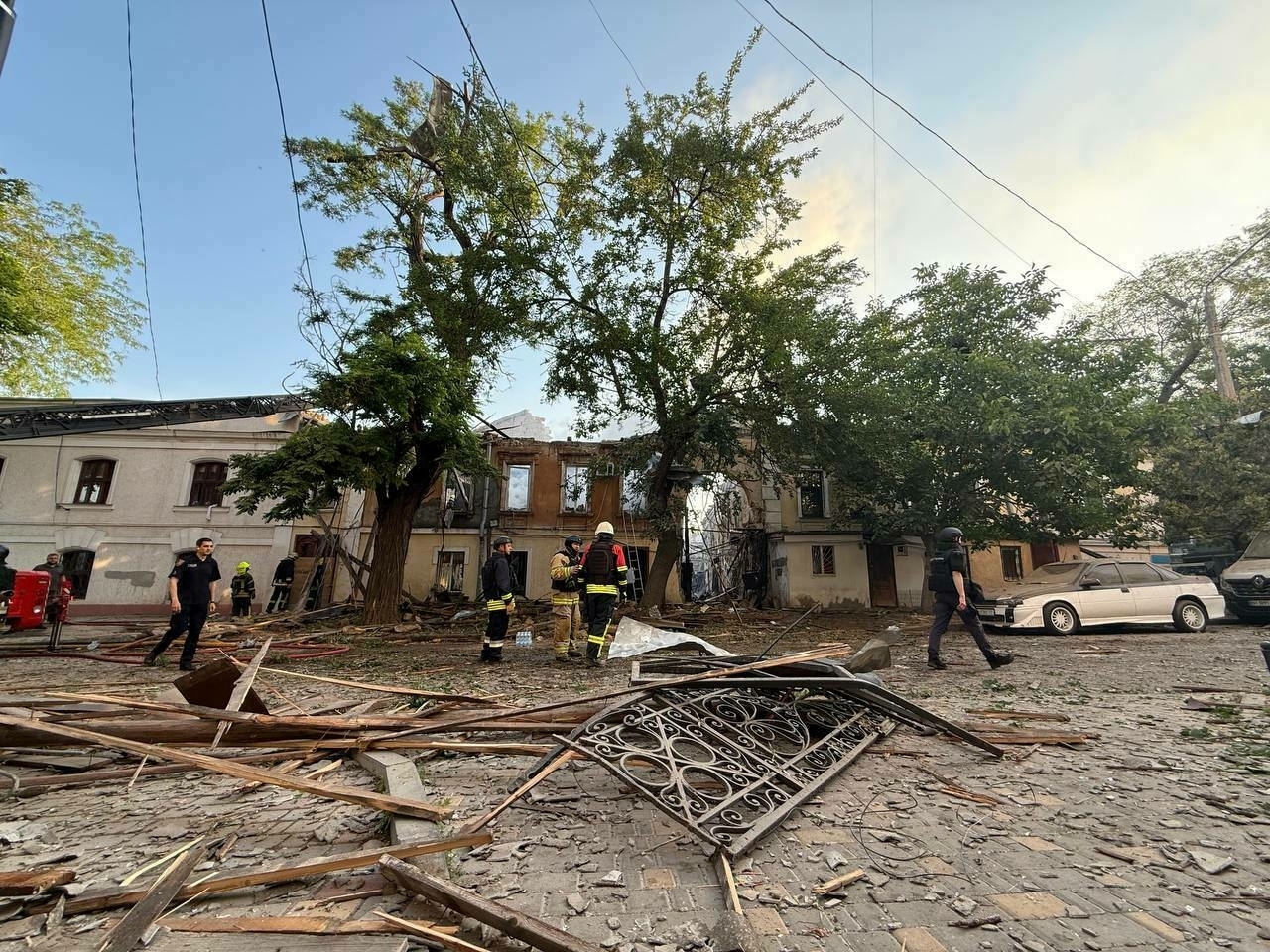
-
Shoigu visits North Korea on 'special assignment' from Putin
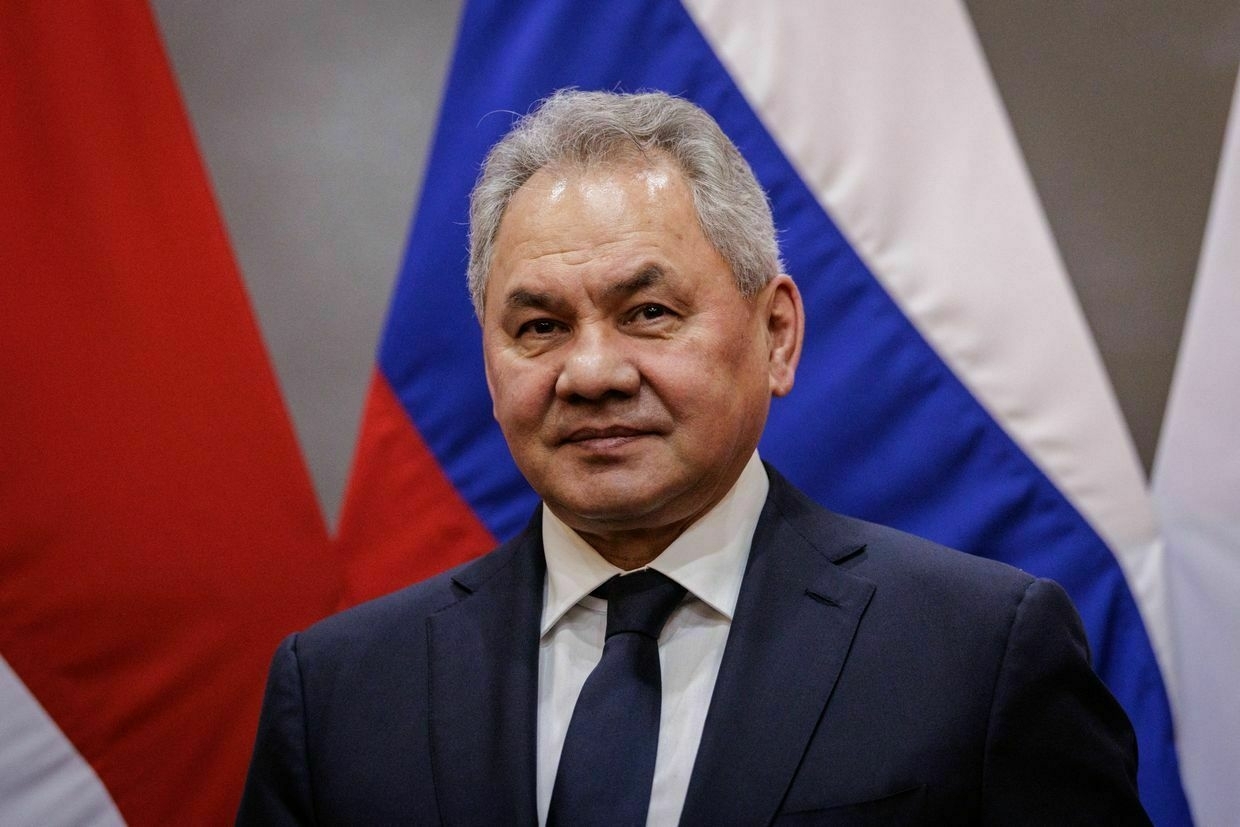
Russian Security Council Secretary Sergei Shoigu arrived in Pyongyang on June 17 on a “special assignment” from President Vladimir Putin, Russian state-controlled news agency TASS reported on June 17.
Shoigu is expected to meet with North Korean leader Kim Jong Un during the visit, TASS said, citing a correspondent on the ground. The purpose of the visit has not been officially disclosed, but it comes amid intensifying military cooperation between the two nations.
North Korea has emerged as one of Russia’s closest military partners during its full-scale invasion of Ukraine. Since late 2023, Pyongyang has supplied Moscow with millions of artillery shells, at least 100 ballistic missiles, and reportedly deployed more than 11,000 troops to assist Russian operations in Ukraine’s border regions.
According to a June 15 report from the United Kingdom’s defense intelligence, over 6,000 North Korean soldiers have been killed or wounded during operations in Russia’s Kursk Oblast. The U.K. said Pyongyang’s losses account for more than half of the North Korean contingent deployed to the region in fall 2024. British officials attributed the high casualties to highly attritional ground assaults.
Earlier this year, South Korea’s Joint Chiefs of Staff reported that North Korea sent an additional 3,000 soldiers to Russia in January and February to replenish losses.
In June 2024, Russia and North Korea signed a mutual defense pact obligating both countries to provide military assistance in the event of an external attack. Though North Korea only publicly acknowledged its participation in Russia’s war against Ukraine in April 2025, open-source reports and intelligence assessments have indicated its involvement since at least the fall of 2024.
The Multilateral Sanctions Monitoring Team (MSMT), a United Nations-affiliated watchdog, reported in May that North Korea and Russia had engaged in “unlawful military cooperation” in violation of multiple UN Security Council resolutions. This included arms transfers, deployment of combat troops, petroleum exports to North Korea exceeding UN caps, and mutual military training.
According to MSMT findings, Russian-flagged vessels delivered up to 9 million rounds of artillery and multiple rocket launcher ammunition from North Korea to southwestern Russia in 2024 alone. These weapons were subsequently used in attacks against Ukrainian infrastructure and civilian targets in cities including Kyiv and Zaporizhzhia.
Russia has also reportedly provided advanced military technology to North Korea, including ballistic missile guidance systems, electronic warfare platforms, and short-range air defense systems. One MSMT participating state confirmed the transfer of at least one Pantsir-class vehicle to Pyongyang.
Kim Jong Un described his country’s involvement in Russia’s war against Ukraine as a “sacred mission” during a public address in May.
Shoigu’s visit to North Korea comes amid intensified Russian aerial attacks across Ukraine, including the use of North Korean-made ballistic missiles containing components sourced from third-party suppliers.
Russia significantly improved North Korea’s shoddy KN-23 ballistic missiles, Ukraine’s Budanov saysIt was reported last year that around half fired at Ukraine by Russia malfunctioned and exploded in mid-air.The Kyiv IndependentKateryna Hodunova
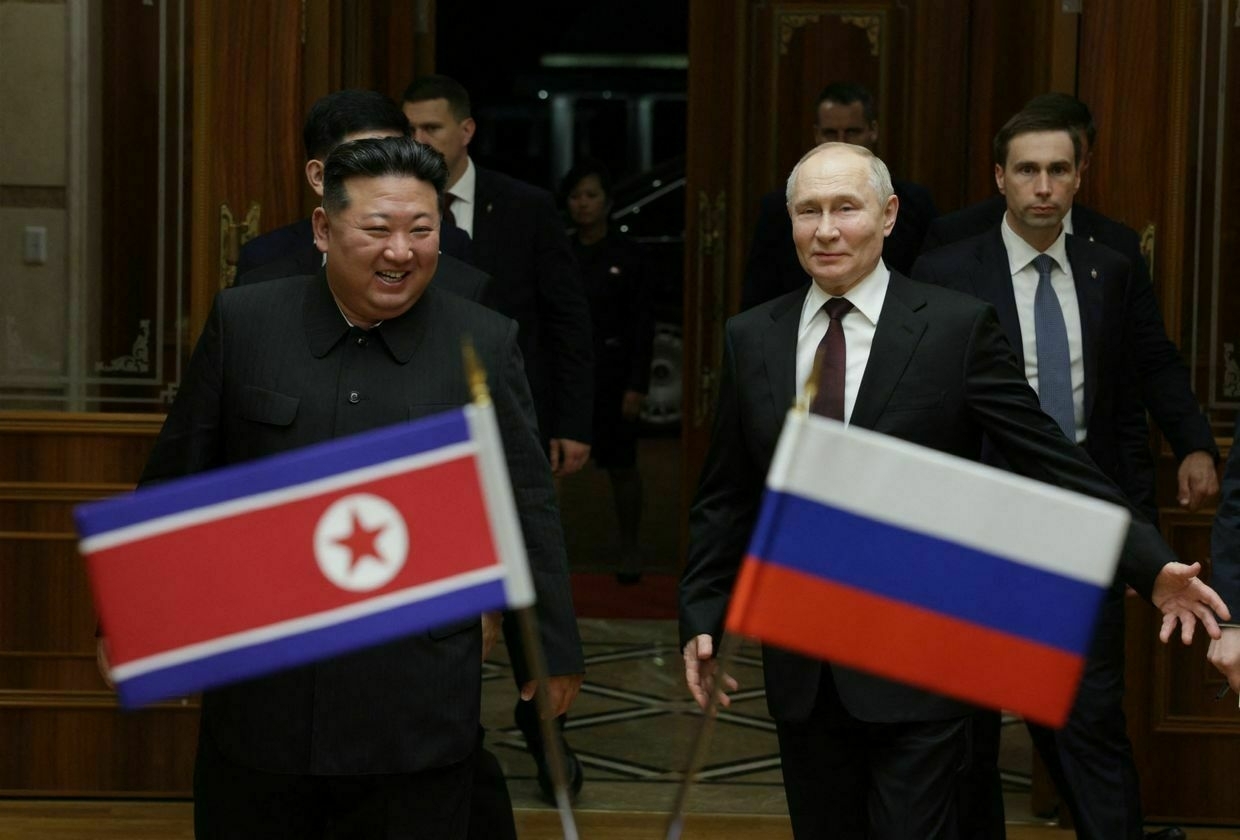
-
Russian drone strike on Odesa injures 13, including 1 child
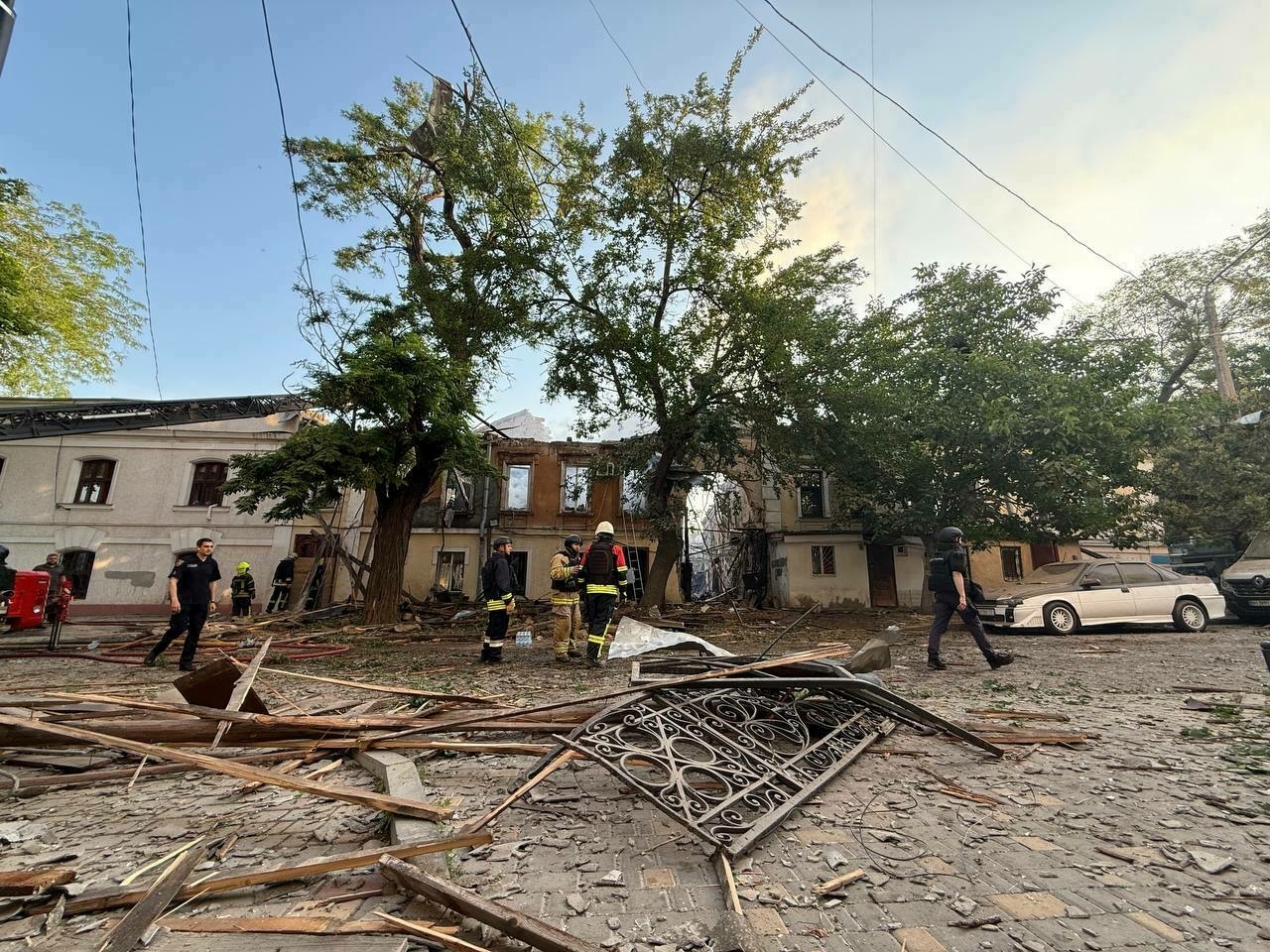
Editor’s note: This is a developing story and is being updated.
Russian drone strikes on Odesa early June 17 injured 13 people, including one child, regional authorities said.
All 13 victims were hospitalized as of 6:30 a.m. local time, Odesa Oblast Governor Oleh Kiper reported.
The attack also damaged civilian infrastructure across the city, including residential buildings.
Emergency services and volunteers are working at the scene to clear debris.
Overnight, Russia also launched a mass attack on Kyiv, injuring at least 18 people.
Odesa, a port city on Ukraine’s Black Sea coast with a population of around 1 million, has been a frequent target of Russian attacks throughout the full-scale war.
Russian military-industrial chemical plant halts operations after Ukrainian drone strikeThe Nevinnomyssk Azot chemical plant — a key supplier to the Kremlin’s military-industrial complex — has suspended production following Ukrainian drone strikes, Russian independent media reported on June 16.The Kyiv IndependentLucy Pakhnyuk
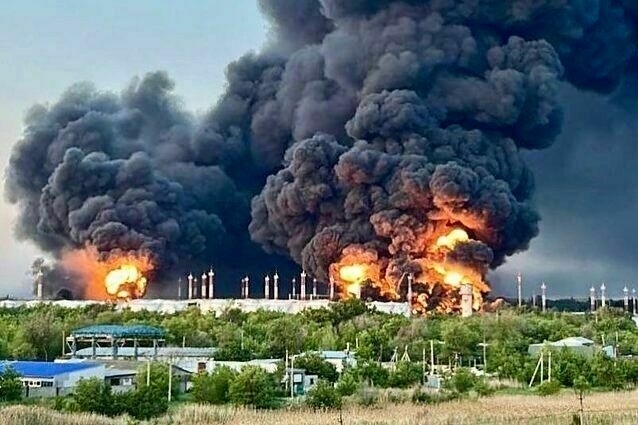
-
Russian military-industrial chemical plant halts operations after Ukrainian drone strike
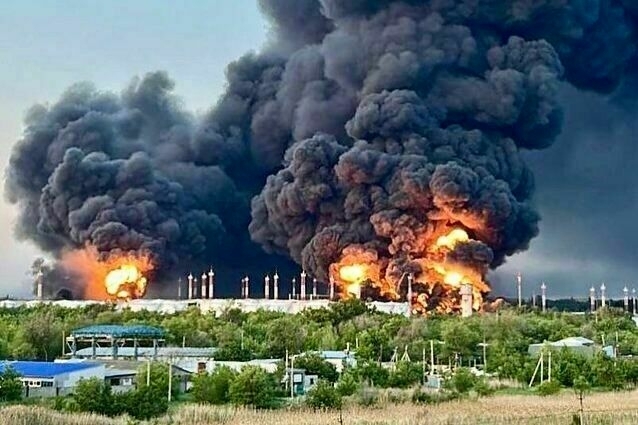
The Nevinnomyssk Azot chemical plant — one of Russia’s largest producers of nitrogen fertilizer and ammonia and a key supplier to the Kremlin’s military-industrial complex — has suspended production, Russian independent media outlet Astra reported on June 16.
According to Astra, the chemical plant suspended production as a direct result of Ukrainian drone strikes. The strike — which was confirmed by Ukraine’s General Staff on June 14 — targeted two major military-industrial facilities in Russia, including the Nevinnomyssk Azot plant in Stavropol Krai. The facility reportedly supplied raw materials and components for Russia’s weapons and fuel production.
Nevinnomyssk Azot is among Russia’s top producers of ammonia and nitrogen fertilizers and hosts the country’s only production lines for methyl acetate and high-purity acetic acid. It also operates Russia’s first melamine production facility, according to open-source data.
According to Andrii Kovalenko, head of Ukraine’s Center for Countering Disinformation at the National Security and Defense Council, the plant produces up to one million tons of ammonia and over one million tons of ammonium nitrate annually, is “a critical element of Russia’s military-industrial complex."
Kovalenko noted that ammonium nitrate is a key component for explosives and artillery shells. He added that the plant also synthesizes dual-use chemicals such as melamine, acetic acid, methanol, and potassium nitrate — all frequently used in the production of grenade launchers, mines, and rocket charges.
Since 2024, the plant has also been producing water-soluble fertilizers, which he said have been adapted to serve military chemical needs as part of Russia’s war in Ukraine.
The chemical plant is part of the EuroChem Group, owned by Russian billionaire Andrey Melnichenko, who is currently sanctioned by Canada, the European Union, Japan, and the United Kingdom.
Russia evading oil sanctions with illegal transfers near Greece, Cyprus, HUR saysAccording to Ukraine’s military intelligence (HUR), the vessel, operating without Western insurance, is part of Russia’s expanding shadow fleet used to bypass G7 and EU sanctions on Russian oil exports.The Kyiv IndependentTim Zadorozhnyy
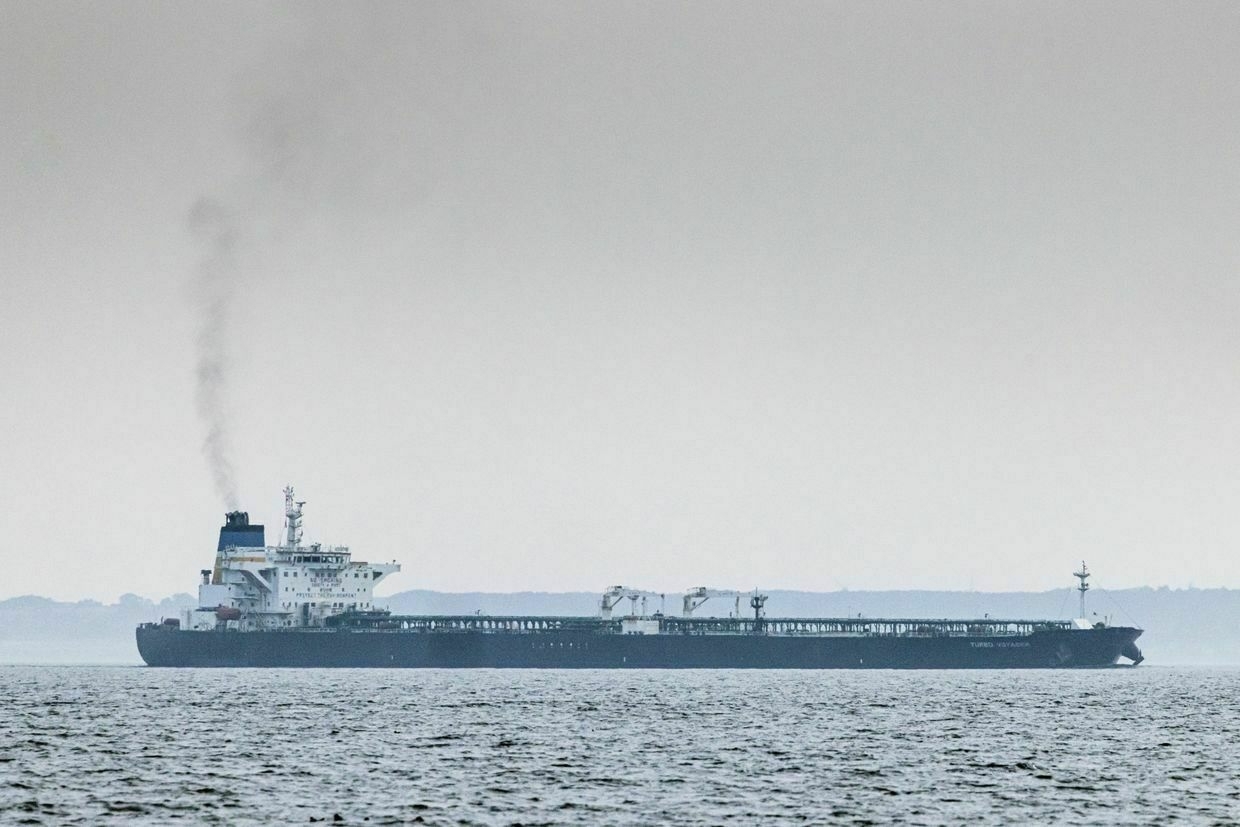
-
Trump to depart G7 summit ahead of June 17 meeting with Zelensky
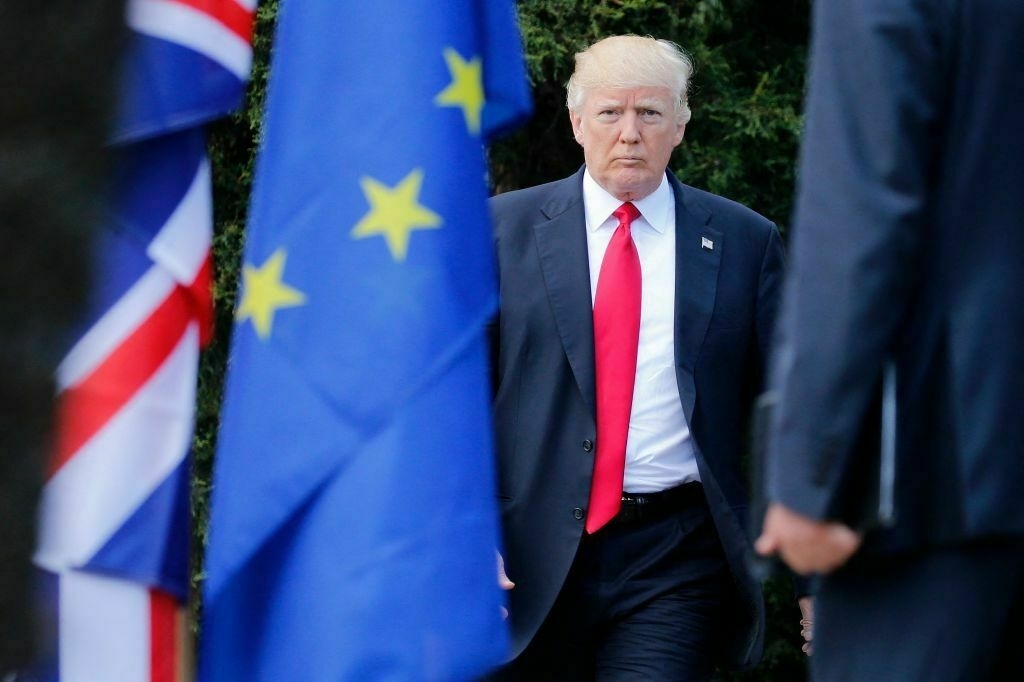
Editor’s note: This is a breaking story and is being updated.
U.S. President Donald Trump is set to depart the G7 Leaders' Summit late on June 16, ahead of an anticipated high-stakes meeting with President Volodymyr Zelensky on June 17.
White House Press Secretary Karoline Leavitt said that the depature comes as Trump is set to attend to “important matters."
It was not immediately clear as to whether Trump will return for the final day of the summit on June 17.
Zelensky was expected to meet with Trump on the sidelines of the G7 summit on June 17, marking their third in-person meeting since the American president took office in January. The proposed meeting may serve as an inflection point for Zelensky as pressure mounts on Trump from Western allies.
“Both teams are working to ensure we meet,” Zelensky said on June 14 during a closed-door briefing attended by the Kyiv Independent.
High stakes, low resolve: What Ukraine can expect from the upcoming G7 summitAs world leaders prepare to gather in the remote community of Kananaskis in Alberta, Canada for the Group of Seven (G7) Leaders’ Summit on June 15-17, Russia’s war in Ukraine once again holds center stage — but views on how to address the three-year conflict diverge sharply. In the five monthsThe Kyiv IndependentDmytro Basmat
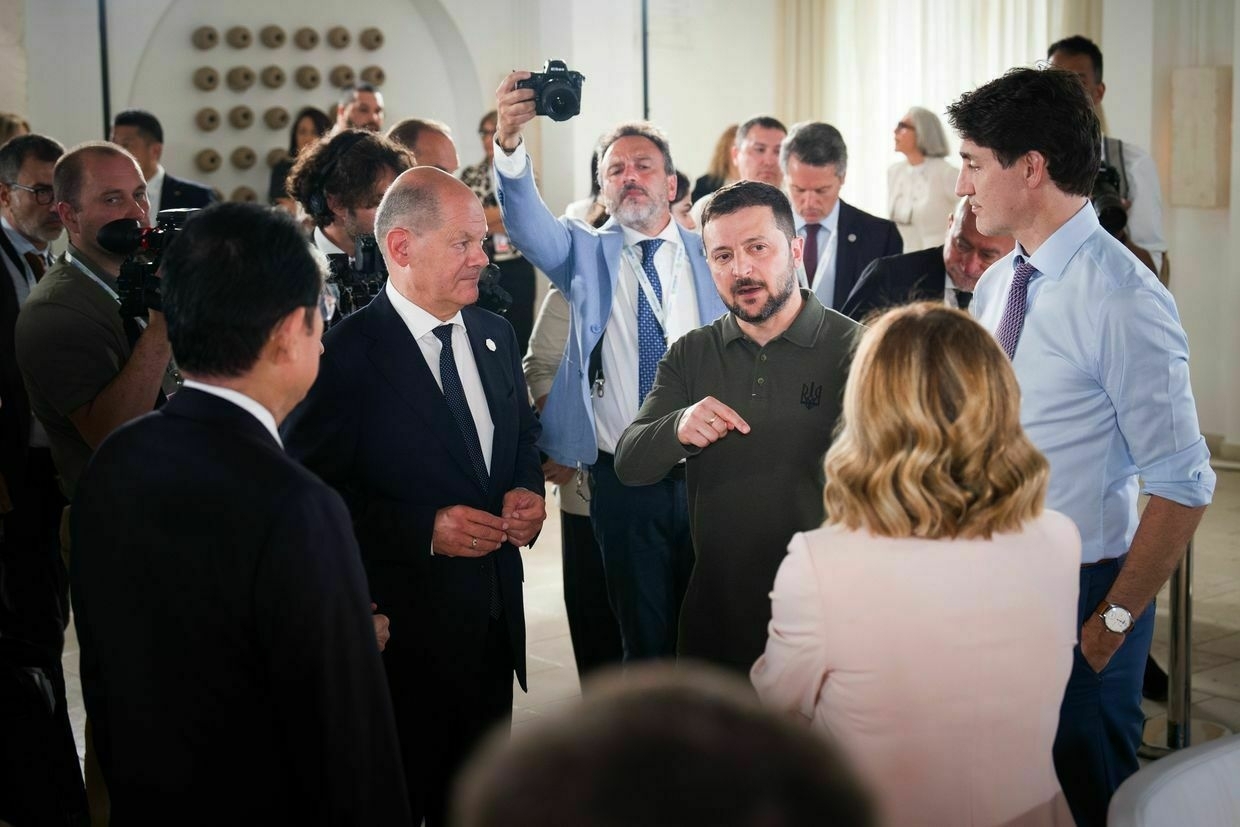
-
Kyiv hit by Russian drones and ballistic missiles, over a dozen injured
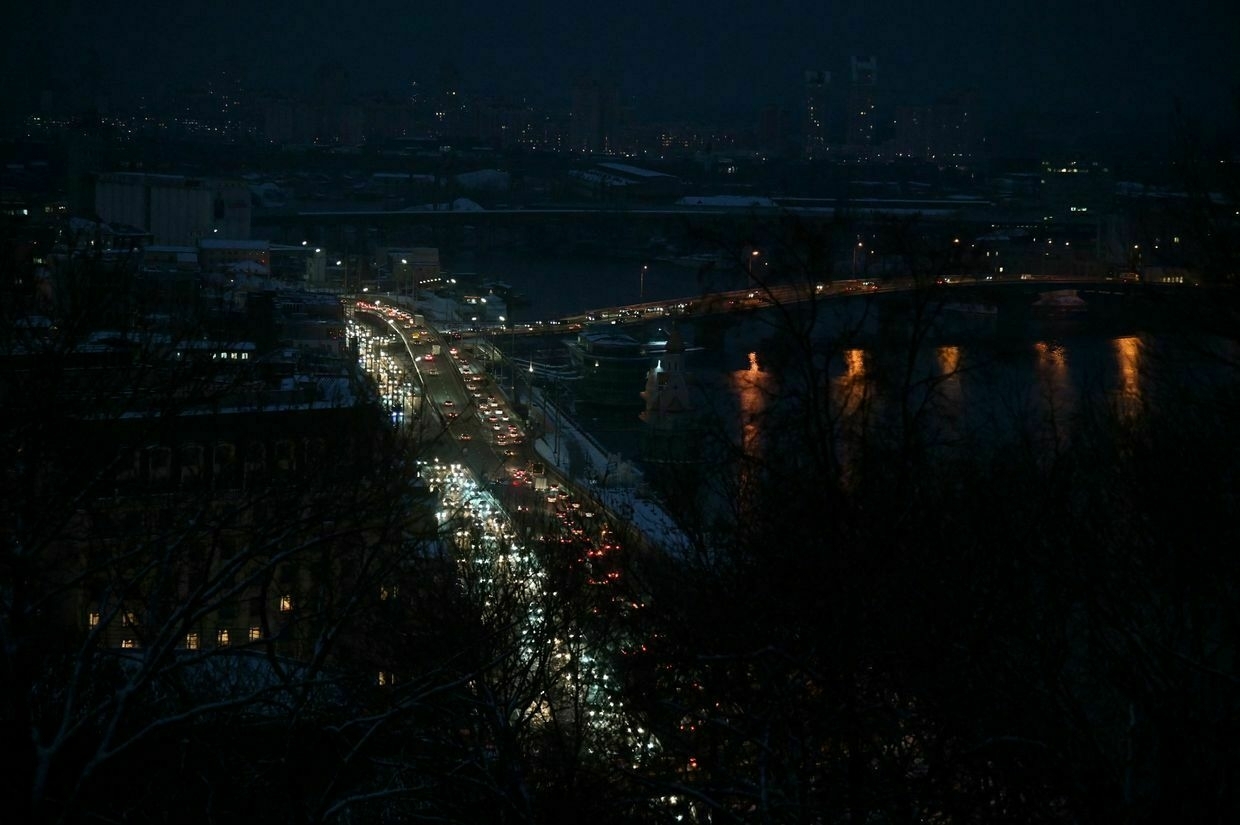
Editor’s note: This is a developing story and is being updated as new details emerge.
Kyiv came under another mass Russian attack in the early hours of June 17, involving ballistic missiles and drones.
Kyiv Independent journalists on the ground reported the sounds of drones and multiple explosions throughout the capital.
At least nine people were injured in the city’s Sviatoshynskyi district, while 11 others were wounded in the Solomianskyi district, including a woman in serious condition, according to Kyiv Mayor Vitali Klitschko. Six people were hospitalized.
The upper floors of a residential building in Solomianskyi were damaged, and debris fell at two locations in the Darnytskyi district, one of which caught fire. First responders were also dispatched to the Obolonskyi district.
The attack followed a series of drone strikes overnight on June 16 targeting Kyiv Oblast, including both the capital and surrounding settlements. In the Obukhiv district, a 60-year-old man was injured, according to regional authorities.
With no new US aid packages on the horizon, can Ukraine continue to fight Russia?The U.S. has not announced any military aid packages for Ukraine in almost five months, pushing Kyiv to seek new alternatives. But time is running out quickly as Russian troops slowly advance on the eastern front line and gear up for a new summer offensive. “While Ukraine’s dependence onThe Kyiv IndependentKateryna Hodunova
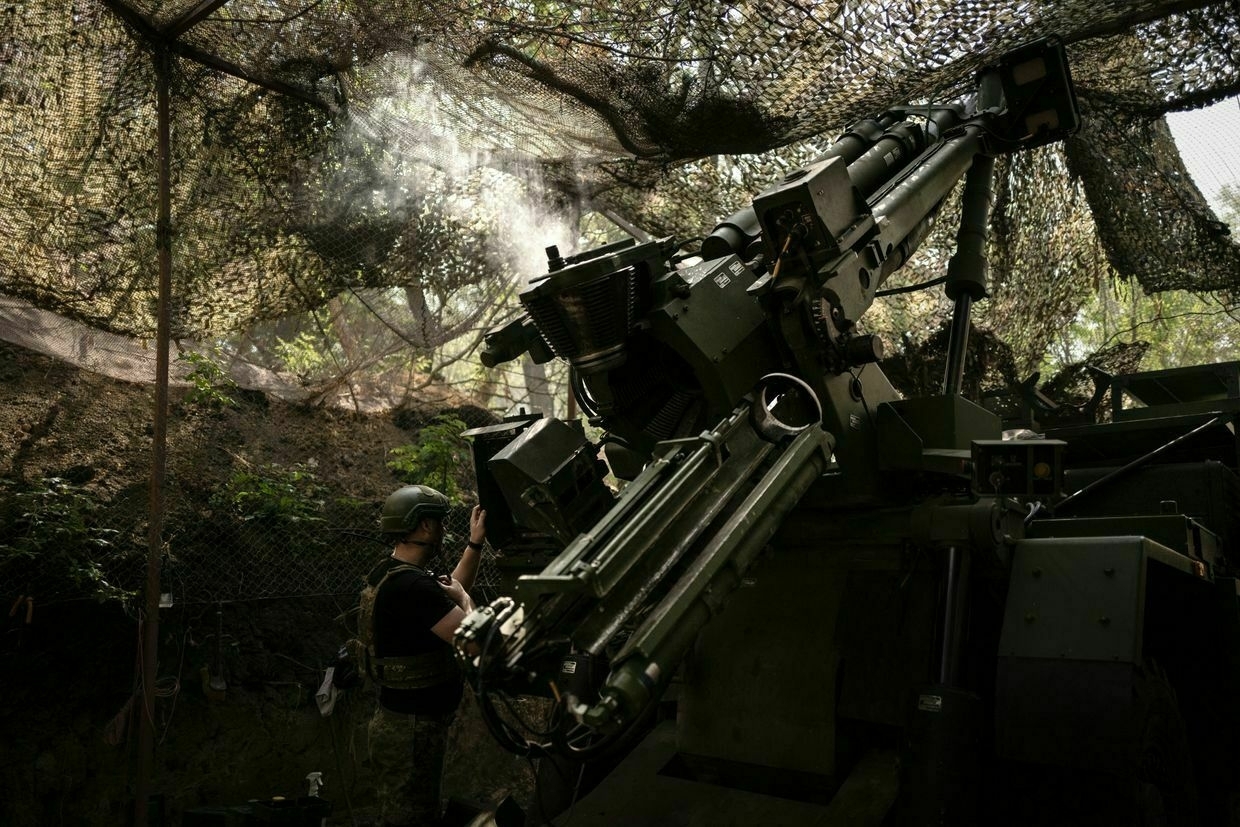
-
Canada reportedly set to announce new military aid for Ukraine at G7
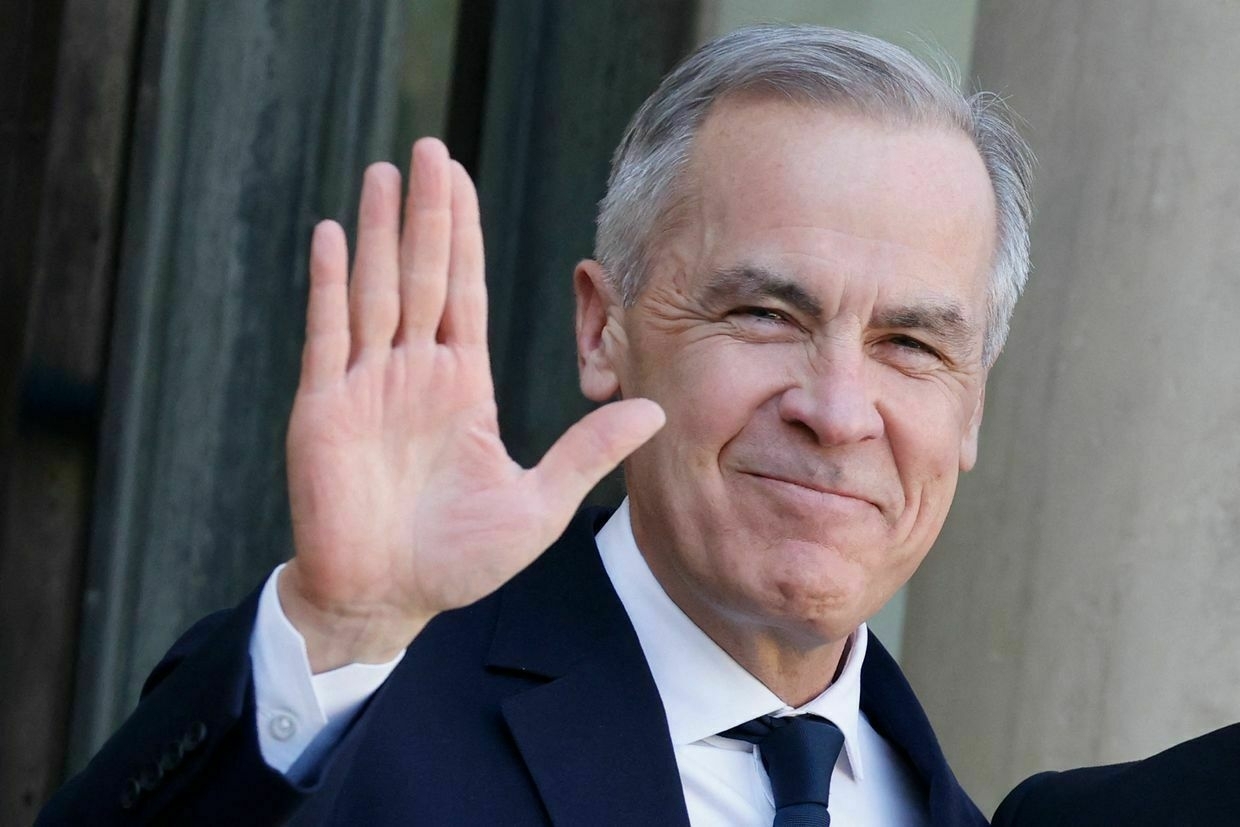
Canada’s Prime Minister Mark Carney is expected to announce additional support for Ukraine during the G7 summit, CBC News reports on June 16, citing government sources.
Canada, which holds the G7 presidency in 2025, invited President Volodymyr Zelensky to participate in what will be his fourth — and arguably most fragile — G7 Leaders' Summit since the outbreak of the full-scale invasion in 2022. Carney is also expected to hold a one-on-one meeting with the Ukrainian president.
As part of Carney’s pledge to boost defense spending this year, Ottawa has allocated two billion Canadian dollars ($1.46 billion USD) for military aid to Ukraine and the expansion of broader defense partnerships. According to one source, the government is set to disclose on June 20 how much of that funding will be directed specifically to Ukraine and what it will support.
Canada has been a strong ally of Ukraine, providing 19.5 billion Canadian dollars ($13.5 billion) in assistance, including 4.5 billion Canadian dollars ($3.1 billion) in military aid.
Following their bilateral talks, G7 leaders will join outreach countries for discussions on Ukraine’s ongoing fight against Russia.
Meanwhile, European Commission President Ursula von der Leyen and European Council President Antonio Costa urged G7 nations to ramp up pressure on Moscow through tougher sanctions, arguing that it is key to securing a ceasefire in Russia’s war against Ukraine.
“To achieve peaceful strength we must put more pressure on Russia to secure a real ceasefire, to bring Russia to the negotiating table, and to end this war. Sanctions are critical to that end,” von der Leyen said at a press briefing on June 15, attended by a Kyiv Independent journalist.
Von der Leyen emphasized that economic sanctions have been effective since the start of Russia’s full-scale invasion. She pointed out that joint G7 and European Union measures have reduced Russian oil and gas revenues by nearly 80% since February 2022.
"(T)he sanctions are working, and we will do more," she said.
-
Ukraine moves forward on lithium mining under US minerals deal, NYT reports
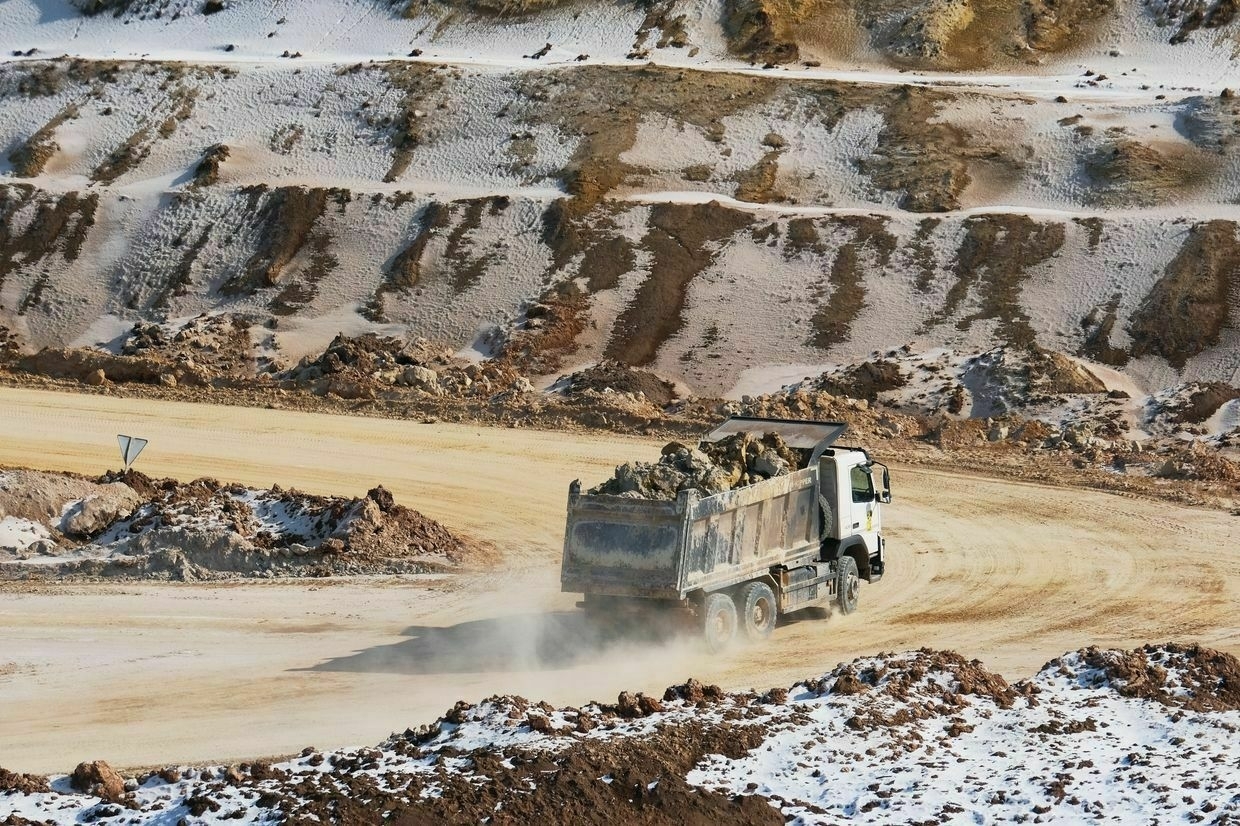
More than a month after Ukraine signed a landmark agreement granting the United States a stake in its mineral reserves, Kyiv has approved initial steps to open one of its largest lithium deposits to private investors, the New York Times (NYT) reported, citing two government officials.
On June 16, the Ukrainian government agreed to begin drafting recommendations for a bidding process to develop the Dobra lithium field in central Ukraine. According to the officials, who spoke to NYT on condition of anonymity, this would be the first project advanced under the U.S.-Ukraine minerals deal.
The Dobra lithium ore site is located in the Novoukrainskyi district of Kirovohrad Oblast, rougly 300 kilometers southeast of Kyiv.
The deal, signed by President Volodymyr Zelensky on May 12, is aimed at deepening economic ties, boosting Ukraine’s reconstruction, and positioning the country as a supplier of strategic resources to the U.S.
Among the likely bidders for the Dobra field is a consortium including TechMet, an energy investment firm partly owned by the U.S. government, and billionaire Ronald S. Lauder, a close associate of the U.S. President Donald Trump. The group has long expressed interest in the Dobra site and encouraged Zelensky to open it to bids last year.
Under the broader agreement, half of the revenues from mineral extraction would go to a joint U.S.-Ukraine investment fund. While the Ukrainian government would reinvest its share into the domestic economy, the United States would claim a portion of the profits — a structure Mr. Trump has framed as partial repayment for U.S. assistance to Ukraine.
TechMet CEO Brian Menell said investors were pushing for production-sharing agreements, which offer long-term stability and tax incentives. Monday’s step toward opening the Dobra field is based on such an arrangement, according to the outlet.
Ukraine war latest: Russia ramps up its summer offensive in several directions, seeks to encircle KostiantynivkaKey developments on June 16: * Russia ramps up its summer offensive in several directions, Ukraine’s military says * Ukraine receives 1,245 bodies of fallen soldiers and citizens, concluding Istanbul repatriation deal * ‘Russians lie about everything’ — Ukraine hits out at Kremlin claims after yet another drone strike on Kyiv * Russia toThe Kyiv IndependentThe Kyiv Independent news desk
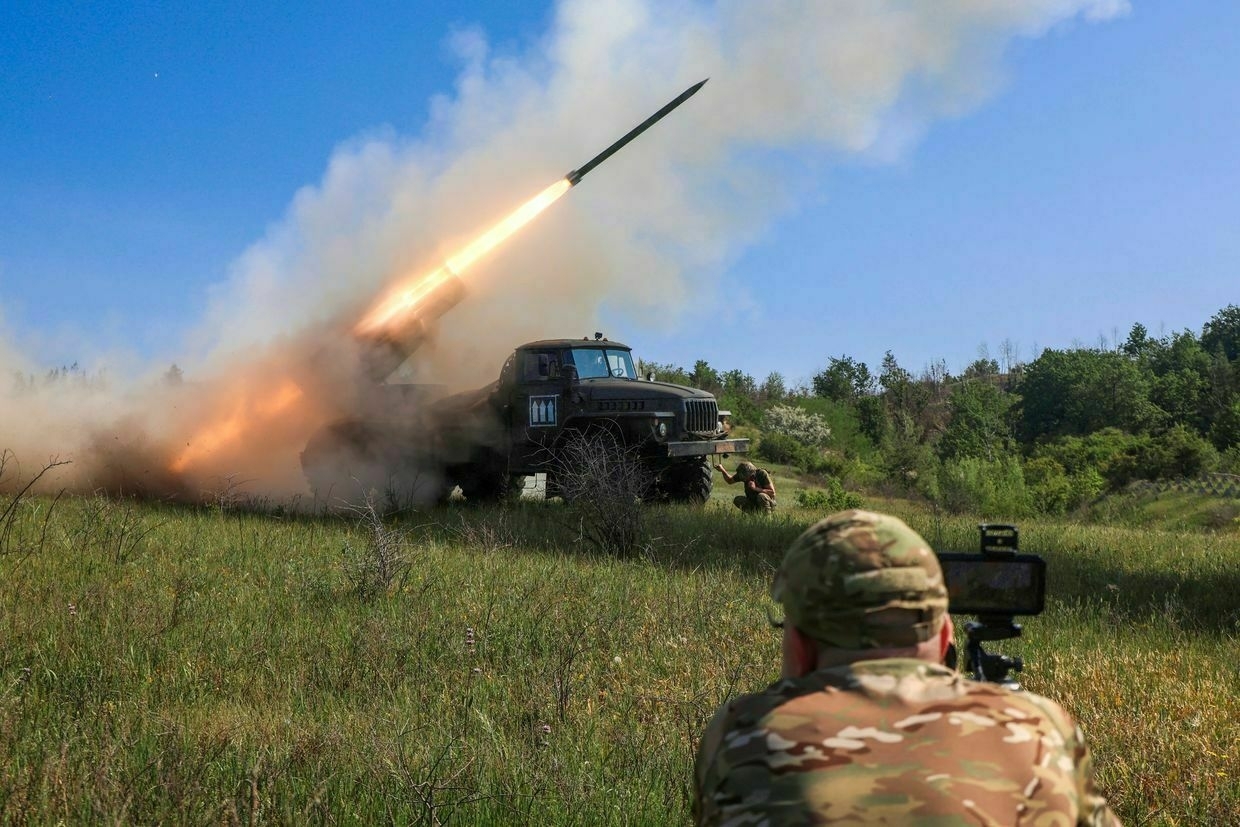
-
Ukraine war latest: Russia ramps up its summer offensive in several directions, seeks to encircle Kostiantynivka
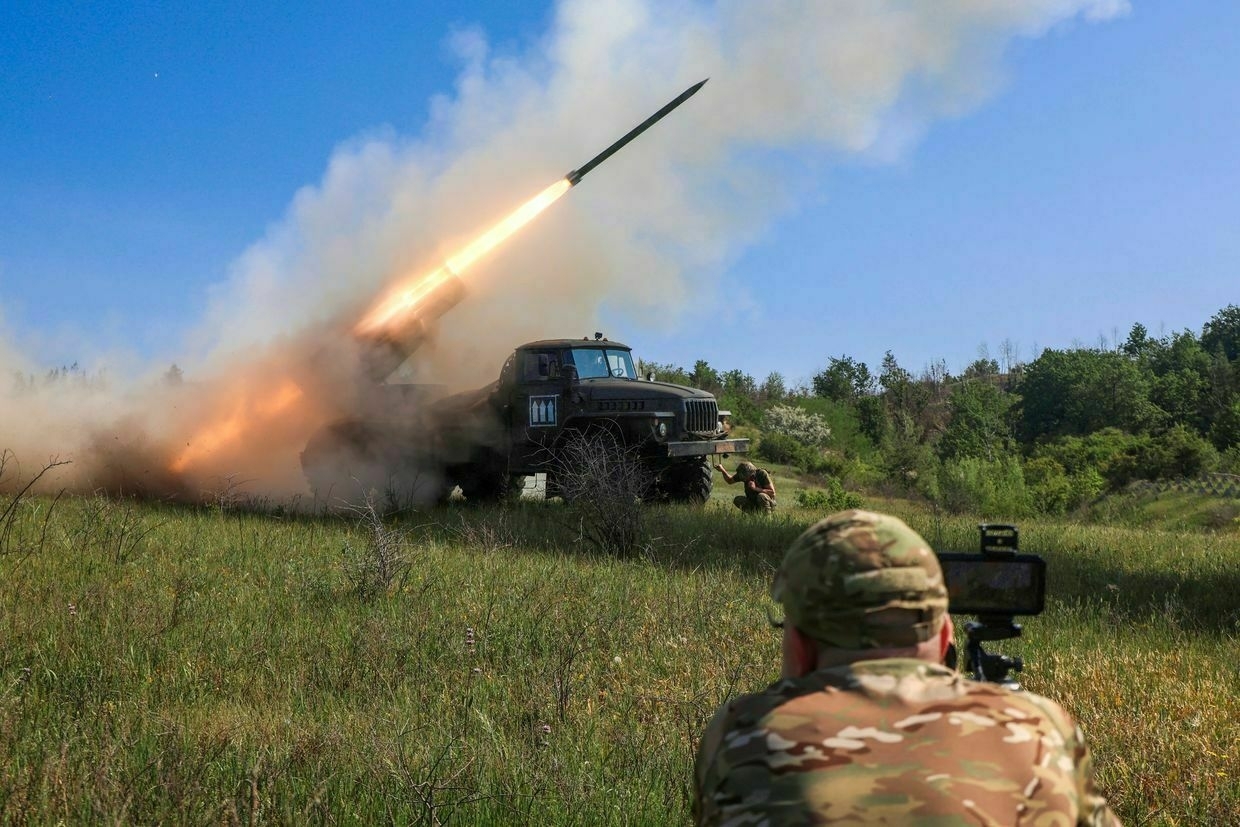
Key developments on June 16:
- Russia ramps up its summer offensive in several directions, Ukraine’s military says
- Ukraine receives 1,245 bodies of fallen soldiers and citizens, concluding Istanbul repatriation deal
- ‘Russians lie about everything’ — Ukraine hits out at Kremlin claims after yet another drone strike on Kyiv
- Russia to demand Ukraine destroy Western weapons to end war, senior Kremlin official says
Russian forces have intensified offensive operations across multiple front-line areas, said Victor Tregubov, a spokesperson for Ukraine’s Khortytsia group of forces, on June 16.
According to Tregubov, Russian troops have ramped up attacks, particularly in the Novopavlivka and Kharkiv sectors, which is an unusual development for these areas.
Ukraine’s General Staff reported that Russian forces launched attacks in 12 directions, resulting in 99 recorded clashes. Ukrainian soldiers repelled 17 attacks in the Novopavlivka sector alone, according to the latest update.
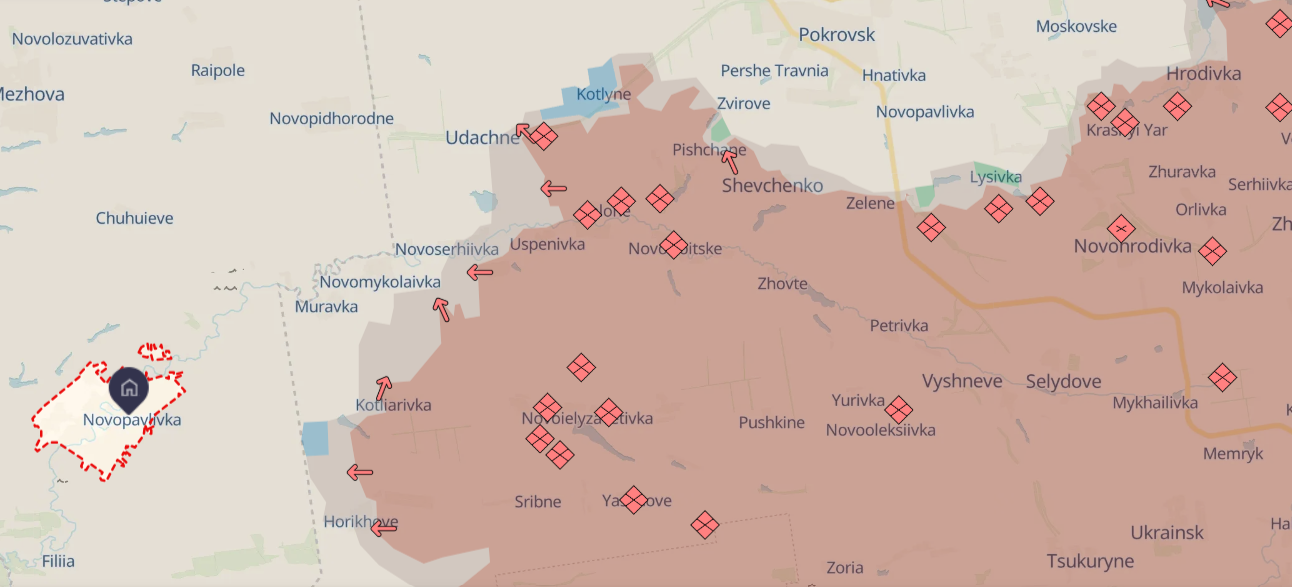
“This signals that we have the expected summer increase in activity,” Tregubov said.
Speaking on national television, he said that the surge in activity near Novopavlivka suggests Russian forces are attempting to push into Dnipropetrovsk Oblast, which neighbors the embattled Donetsk Oblast.
“But they (Russia) have failed to succeed,” the spokesperson added.
In Donetsk Oblast, Russia is trying to encircle Kostiantynivka, one of the key Ukrainian logistics hub in the region since the start of the full-scale invasion, by attacking the city from three directions, according to Tregubov.
From buffer zone to new front: Russia pushes deeper into Sumy OblastIn March 2025, as Ukrainian forces made their final retreat from Sudzha in Russia’s Kursk Oblast, new grey spots began to appear on open-source maps on the other side of the state border, in Ukraine’s Sumy Oblast. For the first time since 2022, when Moscow’s forces retreatedThe Kyiv IndependentFrancis Farrell
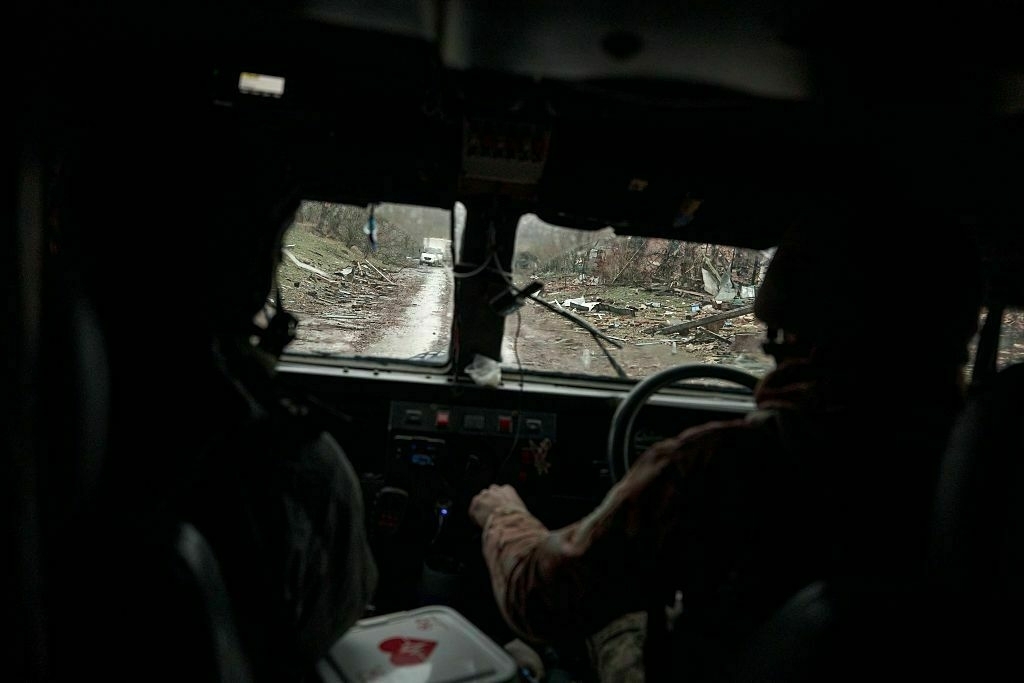
Ukraine receives 1,245 bodies of fallen soldiers and citizens, concluding Istanbul repatriation dealUkraine has received the bodies of another 1,245 fallen Ukrainian soldiers and citizens under agreements reached during recent peace negotiations in Istanbul, the Coordination Headquarters for the Treatment of Prisoners of War (POWs) announced on June 16.
The latest repatriation marks the final stage of the exchange agreement, bringing the total number of Ukrainian bodies returned under the deal to 6,057.
“Each of them undergoes identification. Because behind every one of them is a name, a life, a family waiting for answers,” Defense Minister Rustem Umerov wrote on Facebook.
“We are not stopping. Ahead lies the next stage: we continue the fight to bring back our prisoners of war. We bring them back. We remember…"
The operation was coordinated by Ukraine’s Security Service (SBU), the Ombudsman’s Office, the military, the Interior Ministry, and other state and defense institutions, with assistance from the International Committee of the Red Cross.
Vladimir Medinsky, an aide to Russian President Vladimir Putin and member of the Russian delegation at the Istanbul talks, claimed that Russia received the bodies of 78 deceased servicemen.
Interior Minister Ihor Klymenko said on June 16 that Russia has handed Kyiv the bodies of its own soldiers mixed in with those of Ukrainian soldiers during recent repatriation of the fallen.
“This could have been done by the Russians on purpose to increase the number of bodies transferred and to load our (forensic) experts with work, adding to all this cynical information pressure. Or it could be their usual negligent attitude toward their own people. In any case, we also identify these bodies,” Klymenko said.
With no new US aid packages on the horizon, can Ukraine continue to fight Russia?The U.S. has not announced any military aid packages for Ukraine in almost five months, pushing Kyiv to seek new alternatives. But time is running out quickly as Russian troops slowly advance on the eastern front line and gear up for a new summer offensive. “While Ukraine’s dependence onThe Kyiv IndependentKateryna Hodunova
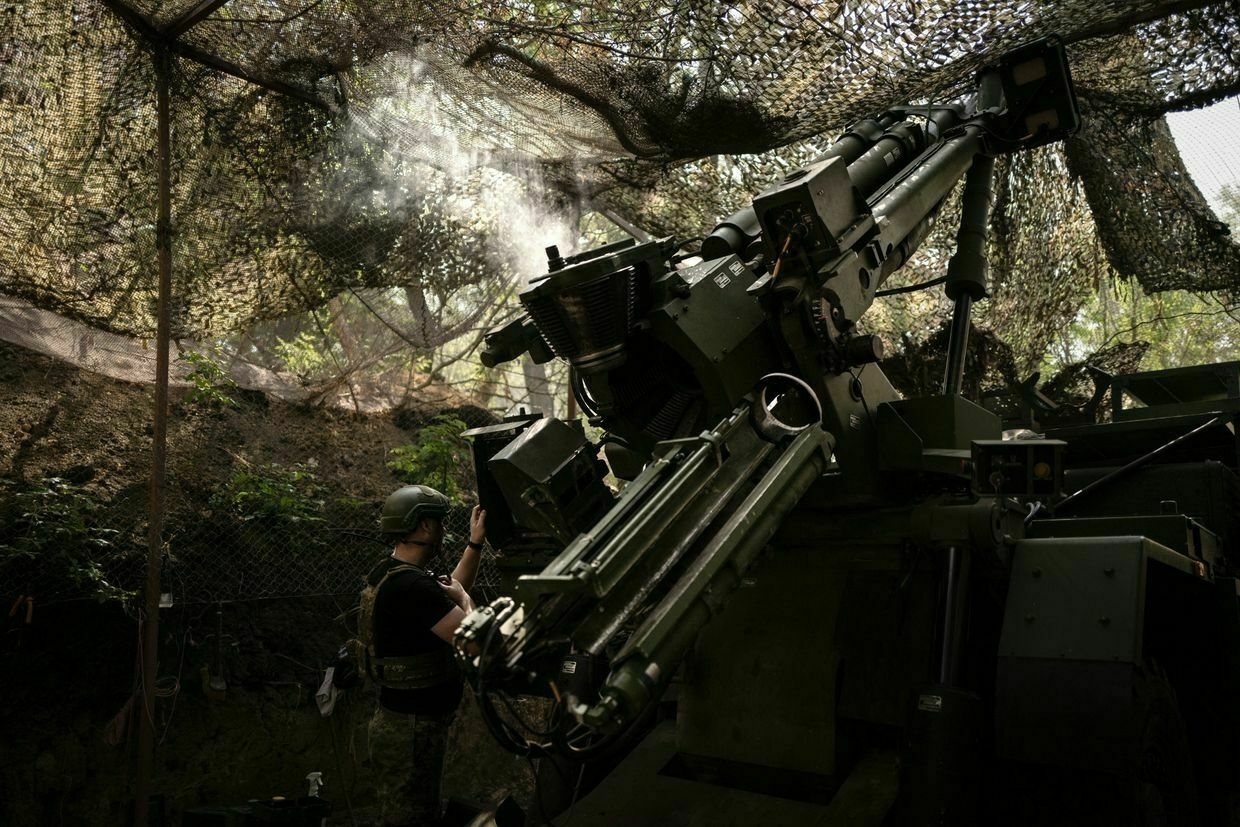
‘Russians lie about everything’ — Ukraine hits out at Kremlin claims after yet another drone strike on KyivUkraine has accused Russia of “lying about everything” after yet another drone attack on Kyiv injured two people overnight on June 16, saying the strike once again rubbished Kremlin claims that only military objects are being targeted.
The strike hit Rusanivka Gardens, a private neighborhood in the capital’s Dniprovskyi District, creating a crater near civilian homes, and injuring a 20-year-old man and a woman, Tymur Tkachenko, head of the Kyiv City Military Administration, said.
“The Russians lie about everything. When they claim to have hit military targets, they are actually targeting our homes and our people,” he wrote on Telegram.
“This is a deliberate tactic of terror."
“Miraculously, significant damage and casualties were avoided,” Tkachenko said.
Satellite images show expansion at 5 Russian nuclear sites near EuropeOne of the most notable developments is in Kaliningrad, where the suspected nuclear weapons storage site has undergone significant reconstruction.The Kyiv IndependentTim Zadorozhnyy
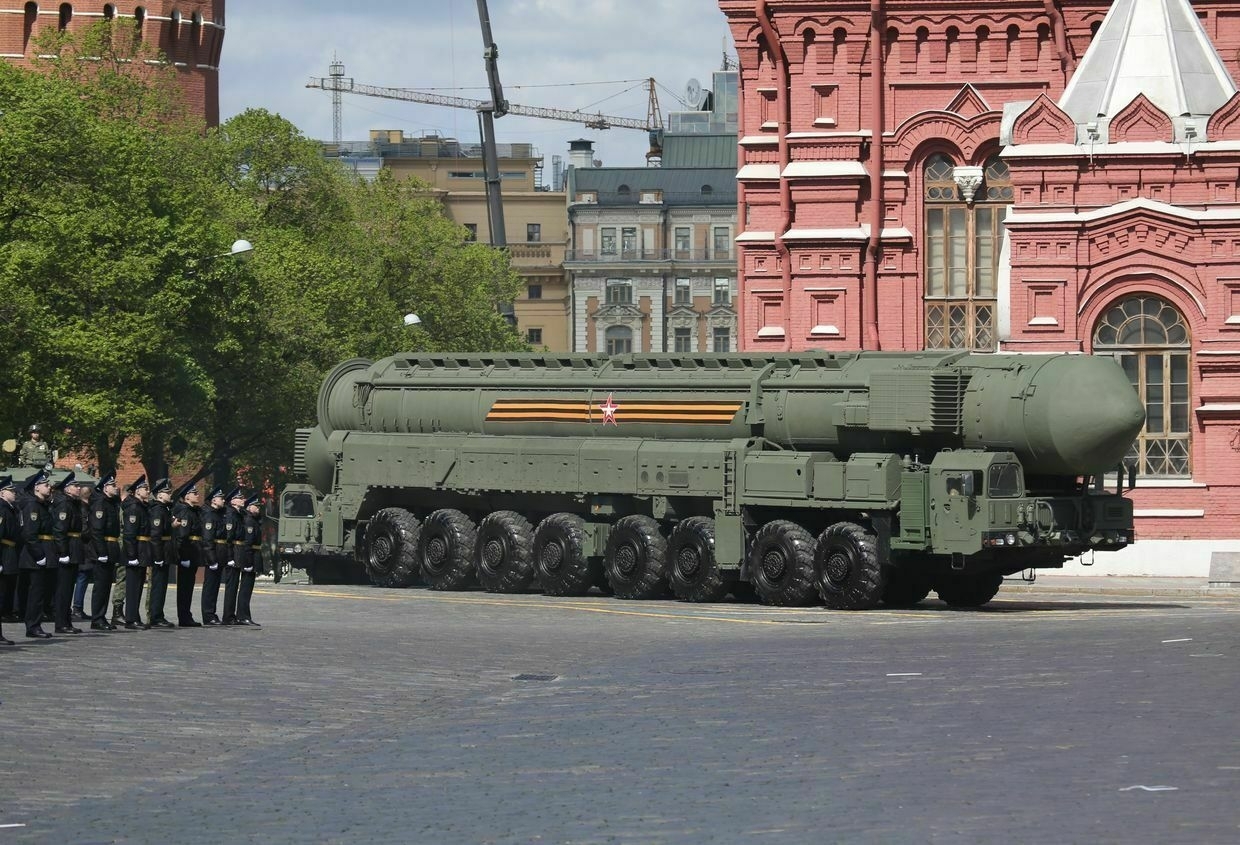
Russia to demand Ukraine destroy Western weapons to end war, senior Kremlin official saysMoscow will insist that Ukraine dismantle and destroy all Western-supplied weapons as part of any ceasefire deal, Russian Deputy Foreign Minister Alexander Grushko said in an interview with the state-run newspaper Izvestia published June 16.
“All these surpluses must be destroyed. All international algorithms are known. They must be reduced, disposed of, and guaranteed,” Grushko said, without offering specifics.
The remarks reflect Moscow’s growing list of maximalist demands presented in its so-called “peace memorandum” during recent negotiations with Ukraine in Istanbul on June 2.
The document calls for Ukraine to recognize Russia’s annexation of Crimea and four partially occupied regions — Kherson, Donetsk, Zaporizhzhia, and Luhansk — and demands full Ukrainian troop withdrawal and demobilization.
Grushko argued that Western weapons aid threatens not only Russia but also Europe, warning that arms could end up on black markets.
“It’s crazy how reckless some politicians are, still flooding the market with weapons,” he said.
There is no credible evidence that Kyiv has diverted Western weapons or fueled arms trafficking — a narrative promoted by Russian propaganda to undermine support for Kyiv.
Independent oversight by partner states and institutions has consistently found that Ukraine uses Western weapons to defend itself against Russia’s full-scale invasion.
Note from the author:
Ukraine War Latest is put together by the Kyiv Independent news desk team, who keep you informed 24 hours a day, seven days a week. If you value our work and want to ensure we have the resources to continue, join the Kyiv Independent community.
Hungary’s soft power meets Ukraine’s hard reality in ZakarpattiaBEREHOVE, Zakarpattia Oblast — Thin gray smoke drifts beyond the patchwork of Soviet-era apartment blocks, historical buildings, and hillside vineyards that make up Berehove — the heart of the Hungarian community in Ukraine’s westernmost Zakarpattia Oblast. “That’s Hungary, over there,” gestures Vitalii Antipov, a member of the local council, toward the not-so-distantThe Kyiv IndependentMartin Fornusek
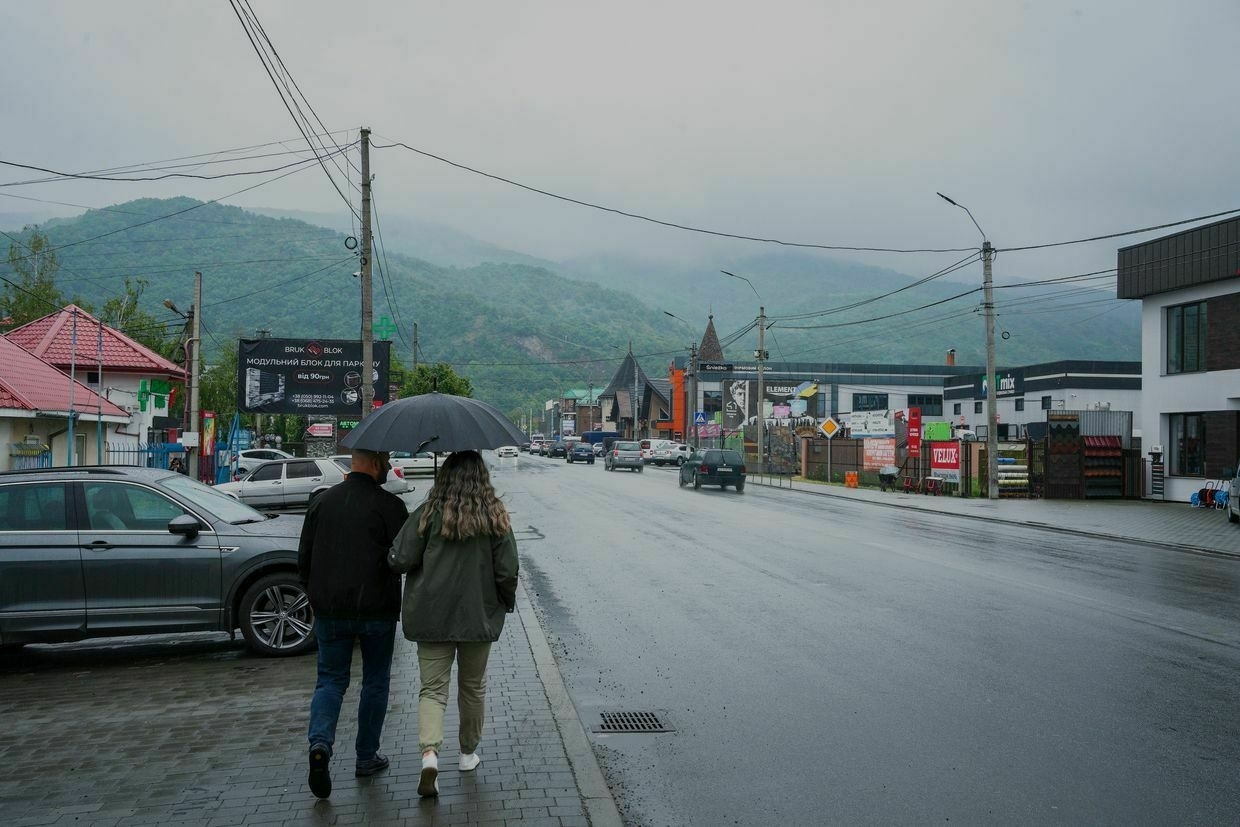
-
Russia ramps up its summer offensive in several directions, Ukraine's military says

Russian forces have intensified offensive operations across multiple front-line areas, said Victor Tregubov, a spokesperson for Ukraine’s Khortytsia group of forces, on June 16.
According to Tregubov, Russian troops have ramped up attacks, particularly in the Novopavlivka and Kharkiv sectors, which is an unusual development for these areas.
Ukraine’s General Staff reported that Russian forces launched attacks in 12 directions, resulting in 99 recorded clashes. Ukrainian soldiers repelled 17 attacks in the Novopavlivka sector alone, according to the latest update.
“This signals that we have the expected summer increase in activity,” Tregubov said.
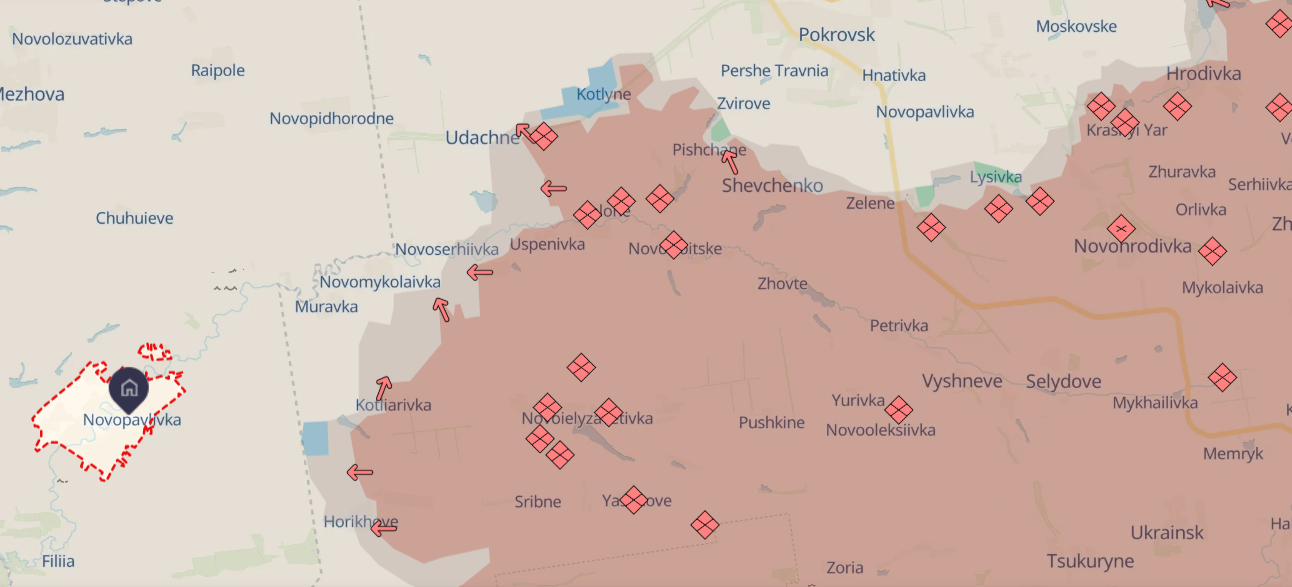
The estimated Russian advance in Donetsk Oblast as of June 16, 2025. (DeepState/OpenStreet Map) Speaking on national television, he said that the surge in activity near Novopavlivka suggests Russian forces are attempting to push into Dnipropetrovsk Oblast, which neighbors the embattled Donetsk Oblast.
“But they (Russia) have failed to succeed,” the spokesperson added.
Last week, on June 13, President Volodymyr Zelensky said that heavy fighting was ongoing along Ukraine’s northeastern border.
Russian forces have concentrated around 53,000 troops in the Sumy sector, pushing into multiple settlements. The president confirmed that small Russian reconnaissance groups had briefly crossed into Dnipropetrovsk Oblast — likely for propaganda purposes.
From buffer zone to new front: Russia pushes deeper into Sumy OblastIn March 2025, as Ukrainian forces made their final retreat from Sudzha in Russia’s Kursk Oblast, new grey spots began to appear on open-source maps on the other side of the state border, in Ukraine’s Sumy Oblast. For the first time since 2022, when Moscow’s forces retreatedThe Kyiv IndependentFrancis Farrell
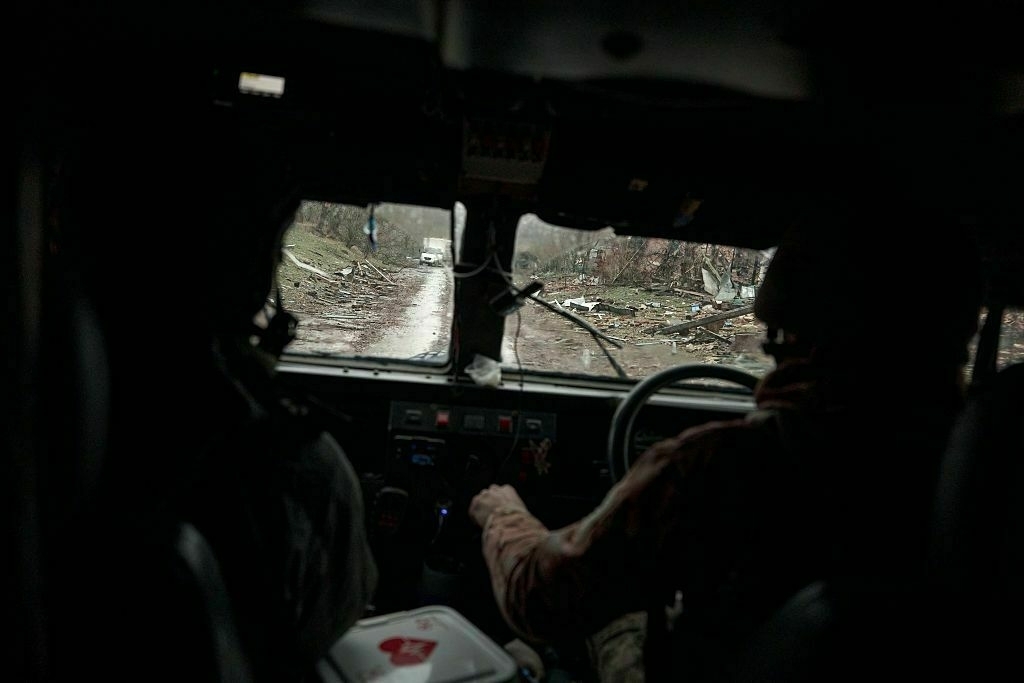
-
Hungary’s soft power meets Ukraine’s hard reality in Zakarpattia
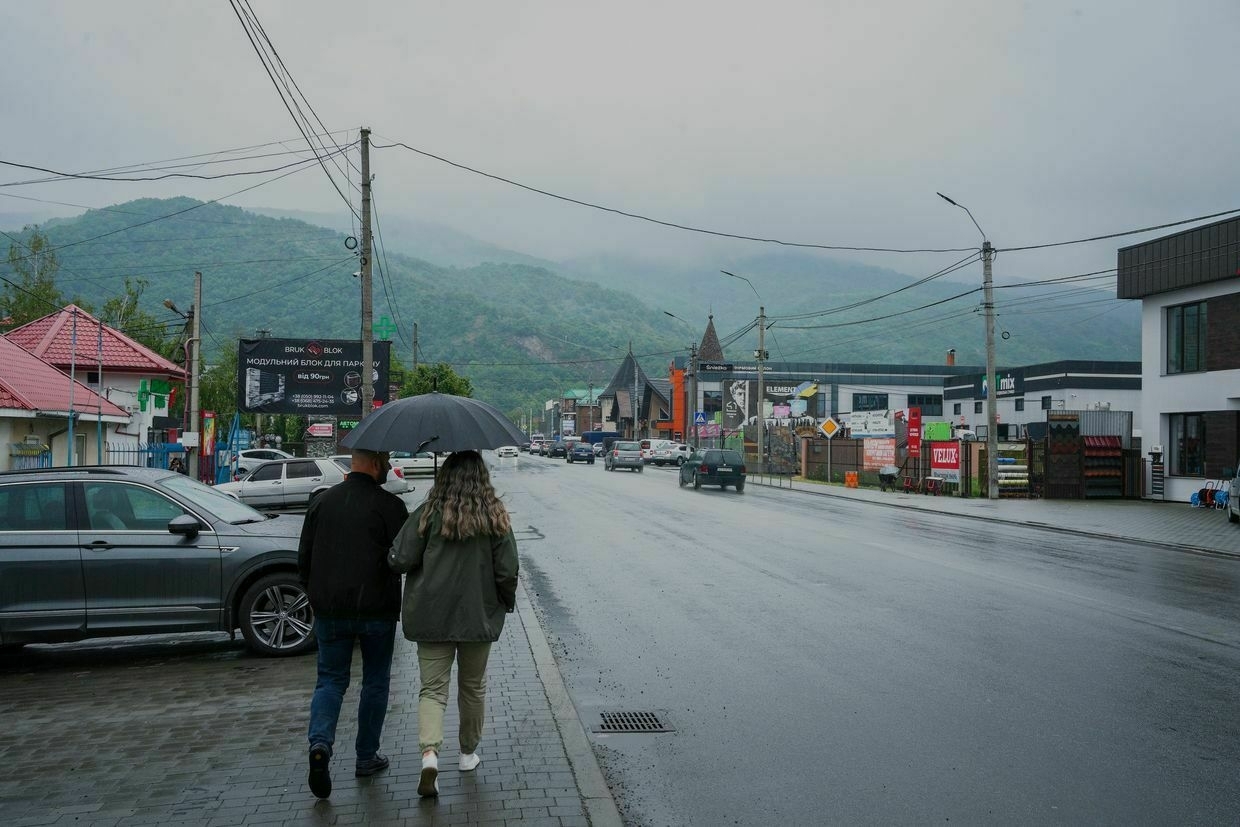
BEREHOVE, Zakarpattia Oblast — Thin gray smoke drifts beyond the patchwork of Soviet-era apartment blocks, historical buildings, and hillside vineyards that make up Berehove — the heart of the Hungarian community in Ukraine’s westernmost Zakarpattia Oblast.
“That’s Hungary, over there,” gestures Vitalii Antipov, a member of the local council, toward the not-so-distant horizon. He stands on top of a hill adorned by a massive white cross with a makeshift inscription thanking the Ukrainian Armed Forces.
A Ukrainian flag fluttering on a pole nearby is accompanied, as is common here, by a Hungarian tricolor.
Living on Ukraine’s western border, the Hungarians of Zakarpattia — a region also known as Transcarpathia — have shared this land for centuries with Ukrainians, Romanians, and others, forming a unique and multifaceted community.
In more recent years, they found themselves a key tool in Viktor Orban’s power play against Kyiv. Zakarpattia also took center stage in an unprecedented spying scandal, with Ukraine claiming to have uncovered a Hungarian espionage network in the region.
“Hungary’s influence (in Zakarpattia) is not anything new… and will likely remain,” Antipov acknowledges. He himself is of both Ukrainian and Hungarian descent, sharing a connection to the two groups that often overlap here.
"The war has changed a lot in the minds and hearts of the Hungarian community."
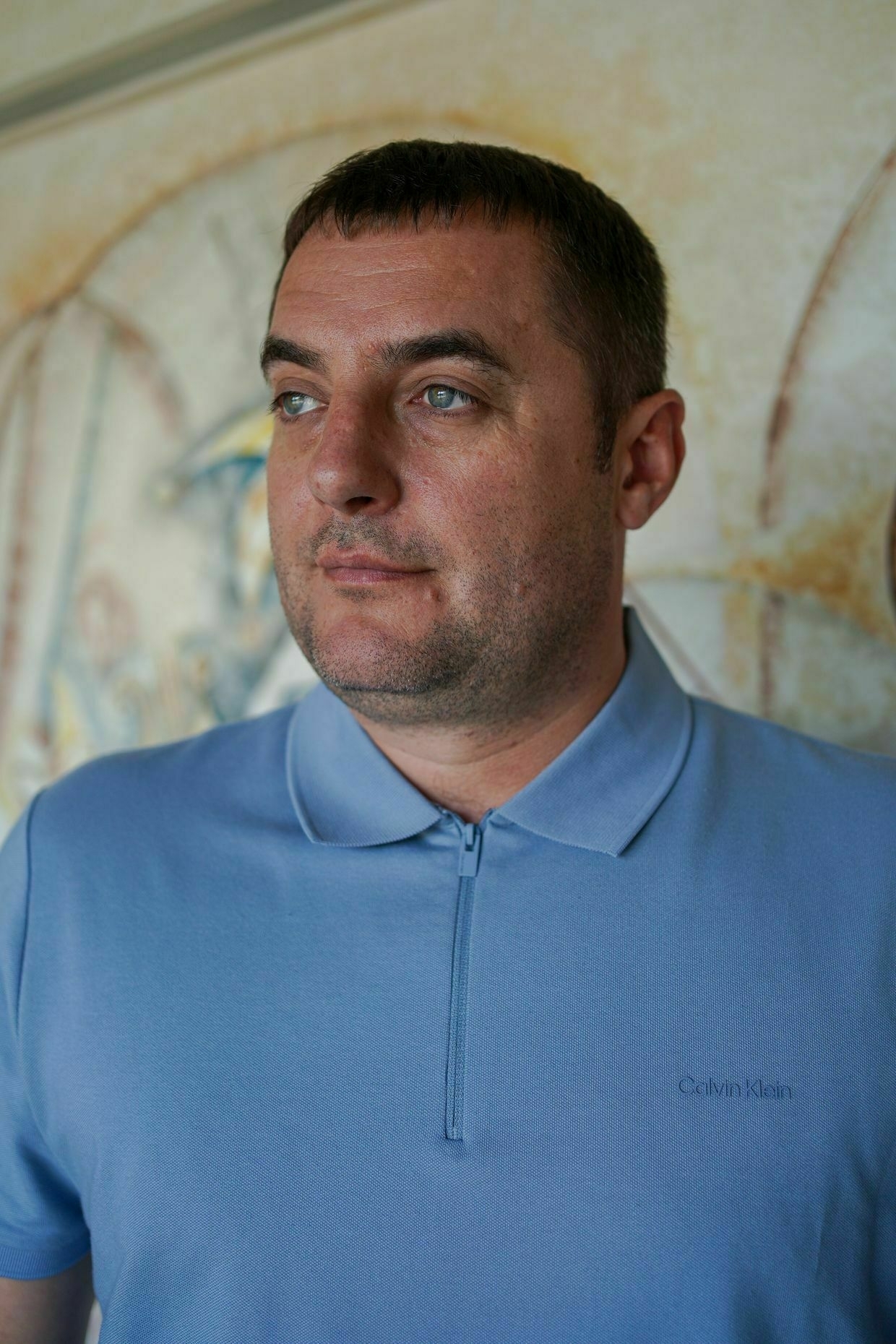
A portrait of Vitalii Antipov in Berehove, Zakarpattia Oblast, Ukraine on May 22, 2025. (Elena Kalinichenko/The Kyiv Independent)
But far from the simplistic image presented by Budapest, Ukraine's Hungarians have reacted differently to recent challenges, namely the war: while some have fled westward into Europe, seeking safety and stability, others have taken up arms, driven by a sense of duty and solidarity.
"The war has changed a lot in the minds and hearts of the Hungarian community," Antipov says.
"I felt it. In Berehove, Vynohradiv, in small villages, everywhere there are families whose sons are fighting, whose relatives have joined the Armed Forces of Ukraine or are helping as volunteers – even Hungarians."
Orban's influence in ZakarpattiaThe border, now only a few kilometers from the town, has been shifting through the ages.
Zakarpattia changed hands over the course of the 20th century: Austria-Hungary, Czechoslovakia, short-lived Carpathian Ukraine, and then Hungary, until it was annexed by the Soviet Union in 1945. Later, it became the westernmost frontier of the independent Ukrainian state.
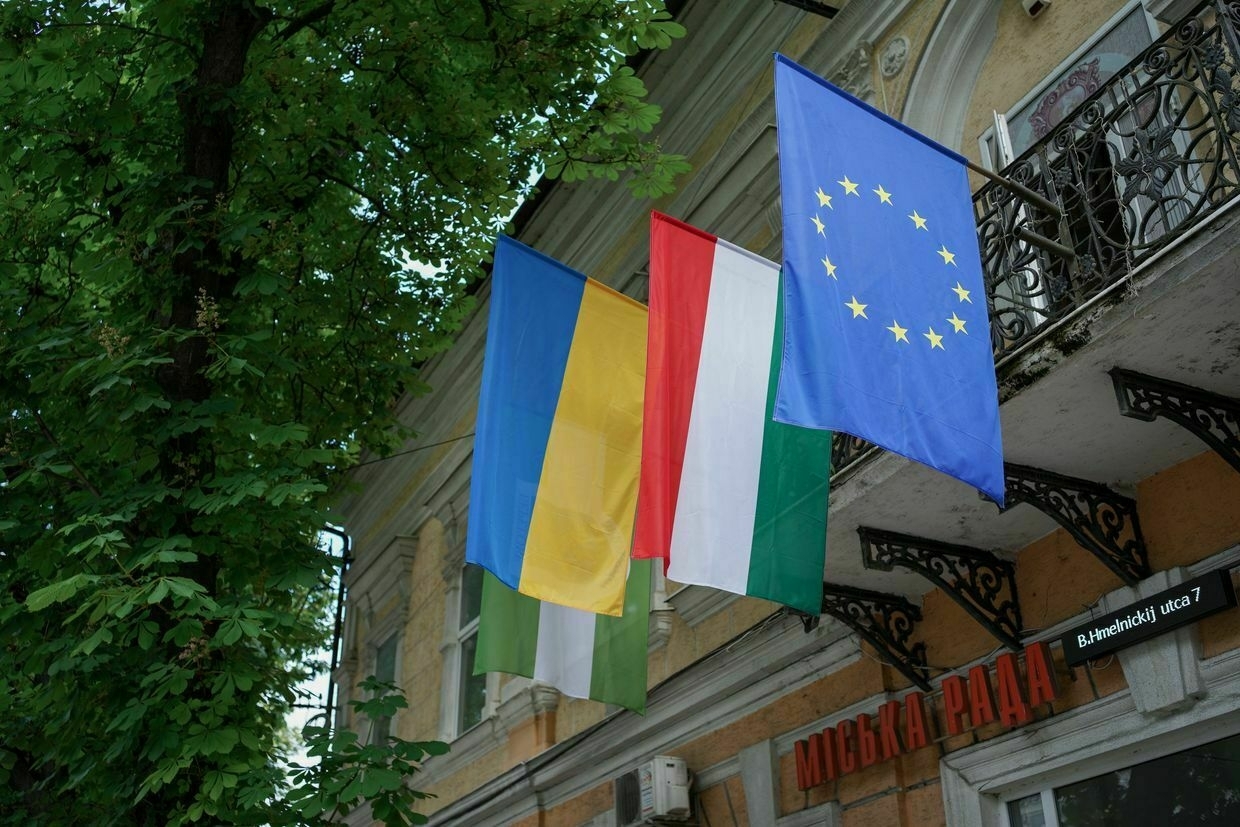
Ukrainian, Hungarian and EU flags on the town hall in Berehove, Zakarpattia Oblast, Ukraine on May 22, 2025. (Elena Kalinichenko/The Kyiv Independent) 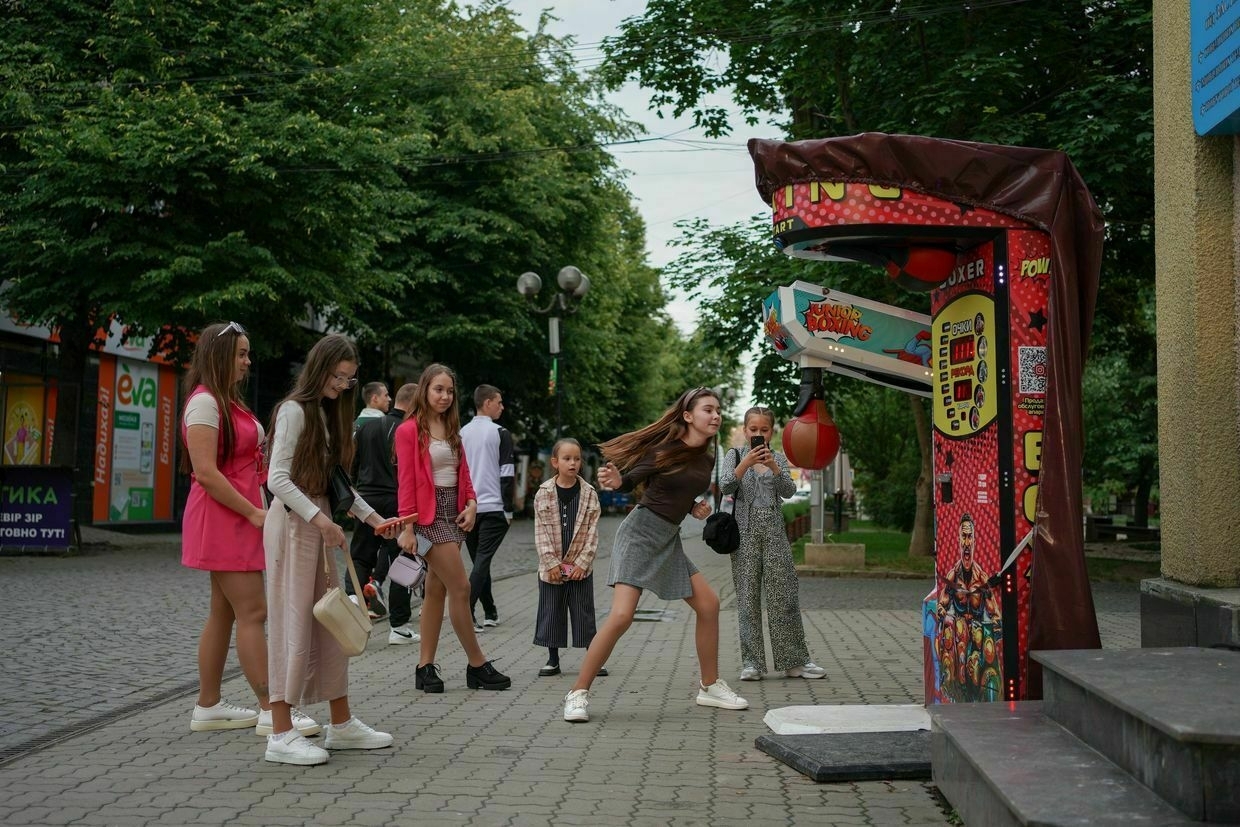
Girls playing boxing punch game on the street in Berehove, Zakarpattia Oblast, Ukraine on May 22, 2025. (Elena Kalinichenko/The Kyiv Independent) The geographical and historical proximity has forged a tight bond between Hungary and the region's Hungarians, and Budapest is making sure it remains so.
In the 2010s, Hungary sparked a diplomatic row with Kyiv by handing out its passports to local Hungarians. Many have accepted, enticed by the vision of better-paid employment in the EU. Some used double citizenship — which is not recognized by Ukrainian law — to receive higher pensions from Hungary while residing in Ukraine, locals say.
Through local civil society organizations, Hungary has been funding schools that teach in the Hungarian language, cultural events, and more, says Csilla Fedinec, senior research fellow at HUN-REN Center for Social Sciences in Budapest.
Zakarpattia's Hungarians "have their own newspapers, they have their own television in Hungarian," Andrii Liubka, researcher at the Institute for Central European Strategy (ICES) in Uzhhorod, tells the Kyiv Independent.
"Even when all media outlets are dying, and publishing is very costly, they continue to publish newspapers in Hungarian… to spread their agenda here, among the local community."
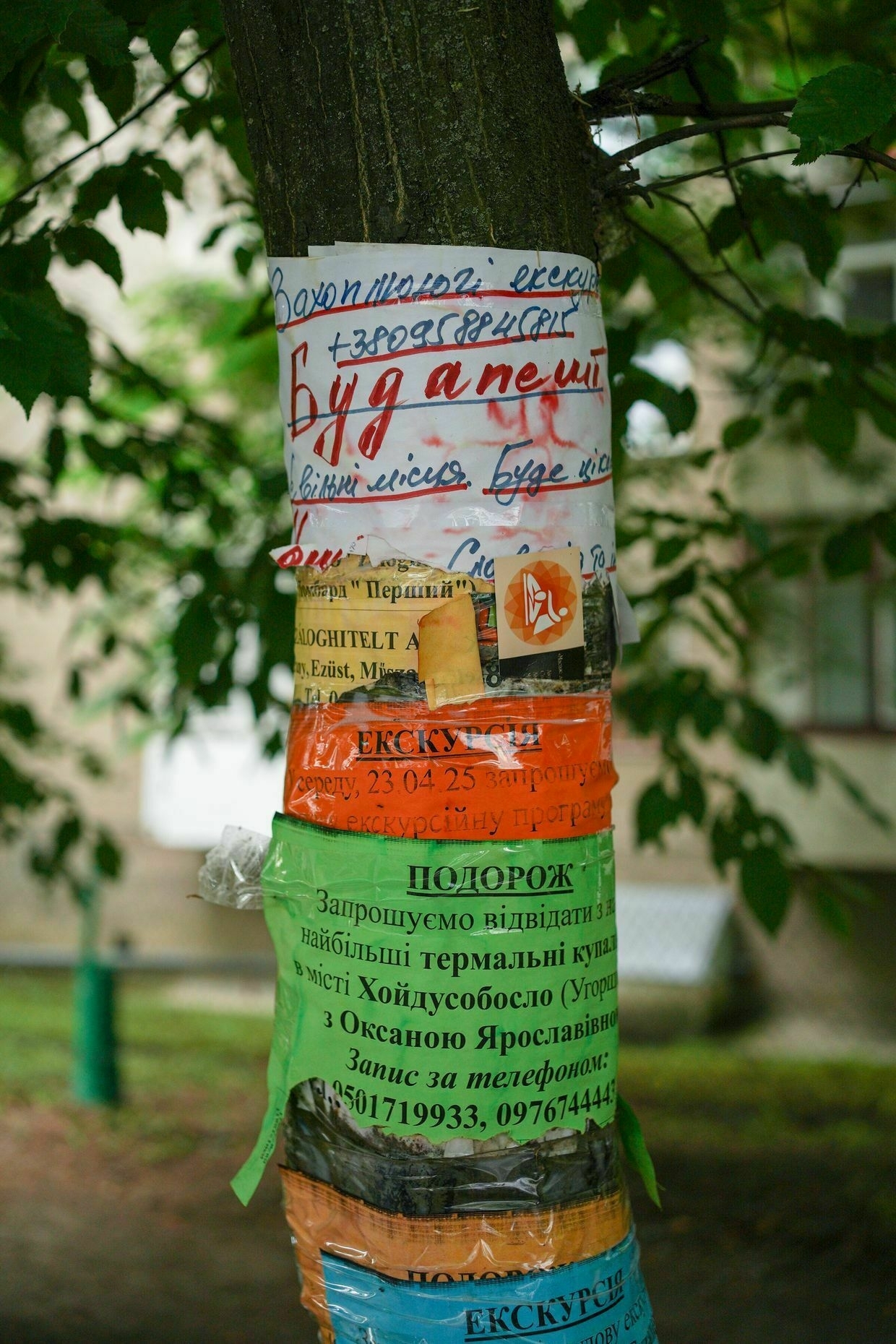
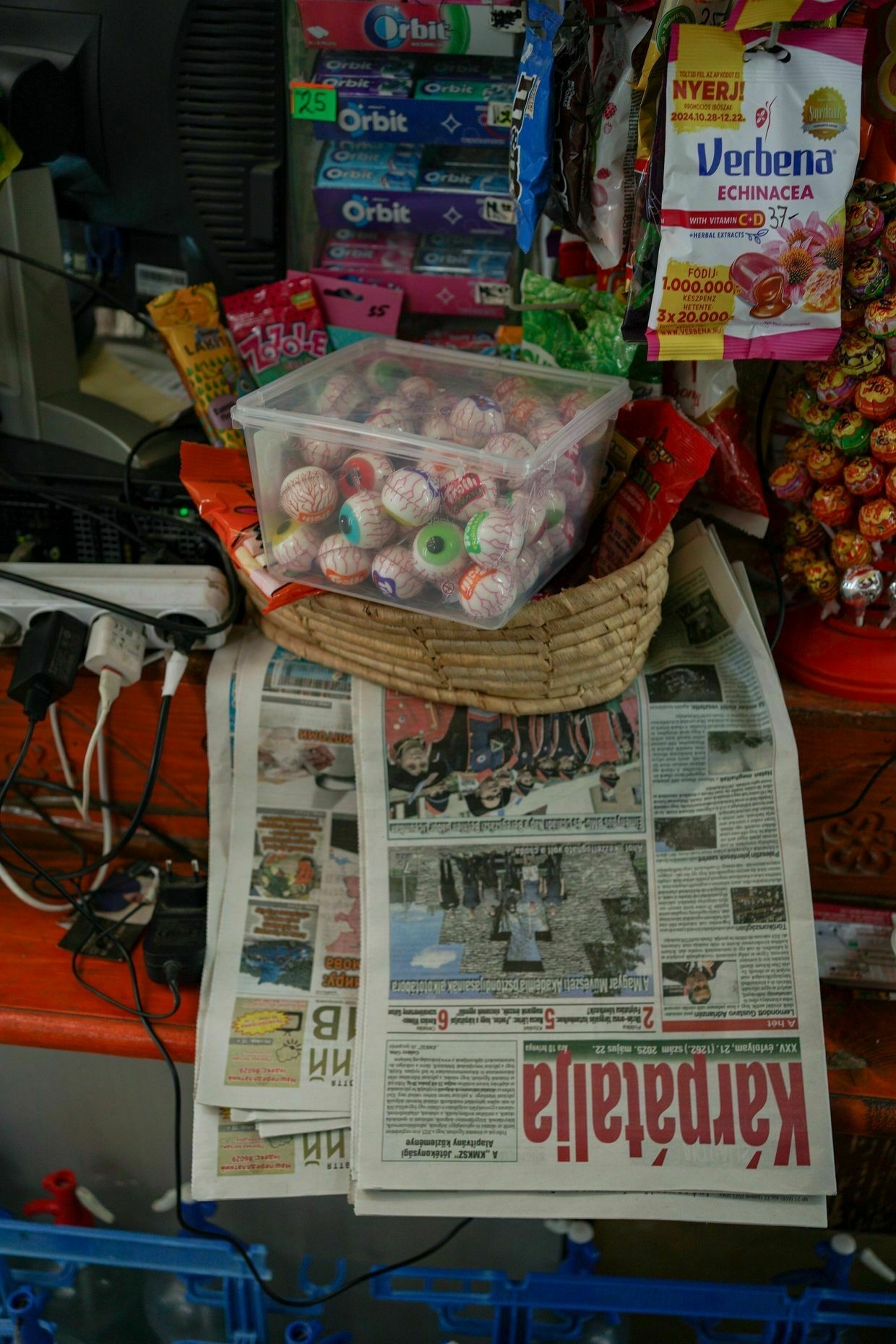
L: Advertisement on a tree in Berehove, Zakarpattia Oblast, Ukraine on May 22, 2025. R: A Hungarian-language newspaper in a store in Berehove, Zakarpattia Oblast, Ukraine on May 22, 2025. (Elena Kalinichenko/The Kyiv Independent) Surveys show that most of the Hungarian-language outlets in Zakarpattia are effectively controlled by Orban's media empire.
According to Liubka, the issue isn't Hungary's financial aid itself but that it's being used to build parallel social structures, making the community reliant on Orban's power network.
This has fostered an atmosphere of self-censorship, where political opinions are rarely expressed for fear of risking financial loss or attracting public backlash.
Fedinec notes that while "Hungary provides special support for Hungarians living in neighboring countries," this "also seems to require political allegiance with the Hungarian governing parties."
But there have been cases where the Hungarian community spoke out against Orban. In 2023, as Hungary was threatening to derail the launch of EU accession talks with Ukraine over the supposed curtailment of minority rights, Hungarian community leaders published an open letter to Orban not to block Ukraine's accession.
"Hungarians living in Zakarpattia — those who have not left — understand that they are connected to this country," says Vitalii Diachuk, researcher at ICES.
"By restricting Ukraine's right to join the EU, the Hungarian government is… closing some new opportunities for the Hungarian community. And the community understands this."
'We are no spies' — Fragile harmony of BerehovePolitics is no topic for the streets of Berehove. Questions about Orban are brushed aside — sometimes with suspicion, sometimes with amusement. "I don't listen to Orban," says Oksana Savula, a Ukrainian flower lady, with a smile.
"Politics is politics," comments Dmytro Kosmeda, a Ukrainian resident. His companion, Yurii Buzhak, adds: "Let's say that what is reported in the media does not reflect reality at all."
Asked about the relationship between the local Hungarian and Ukrainian communities, Yurii responds confidently: "There are absolutely no problems… There is no kind of prejudice against any nation."
"We have always lived here peacefully — that is, we have no political problems."
Dmytro's wife is Hungarian, and they use both languages at home. Though bilingualism seems common here, some of the local Hungarians shy away from answering, explaining that they cannot speak Ukrainian.
"I am Ukrainian, but we have been speaking Hungarian since birth," says Mykhailo Popovych, a man selling strawberries and homemade wine not far from the town's center. "We have always lived here peacefully — that is, we have no political problems."
Overhearing the discussion, a man at a neighboring stall quips, "We are no spies," subtly revealing what is on people's minds in the past weeks.
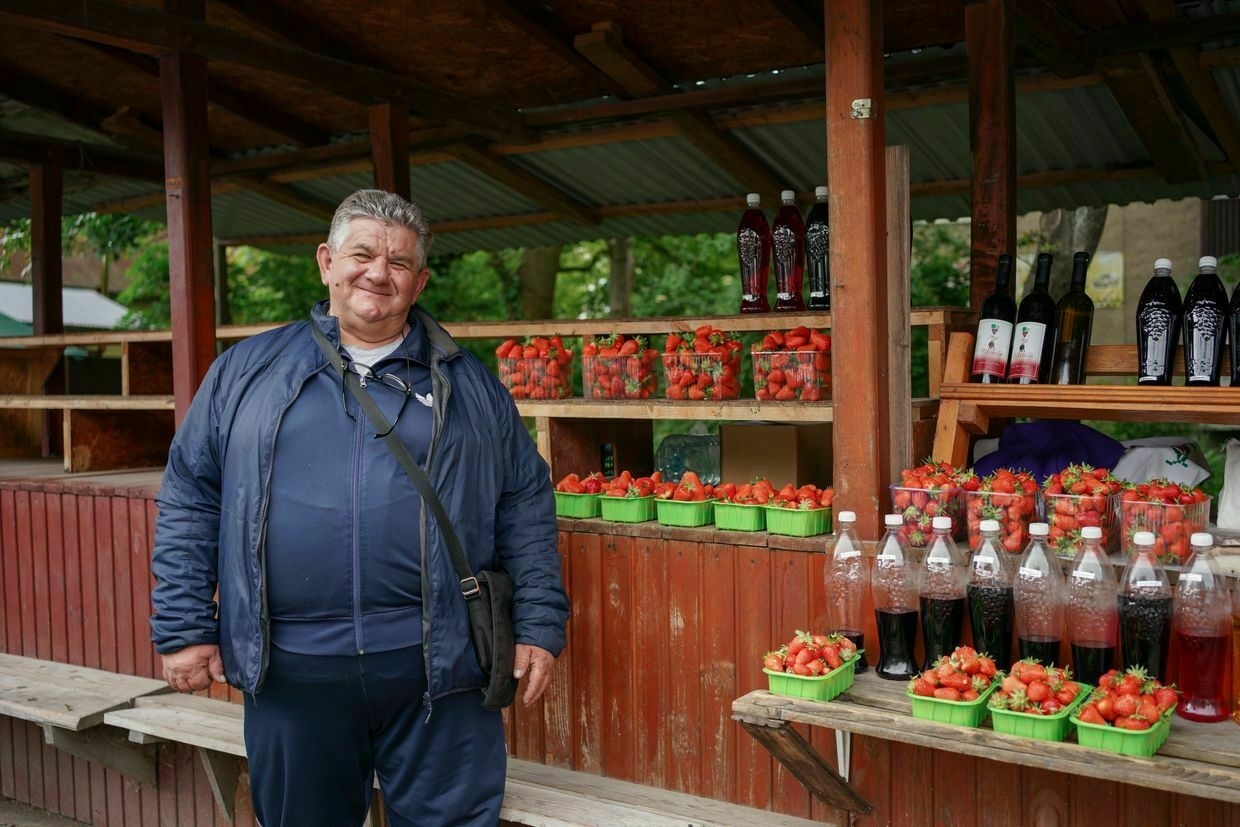
Mykhailo Popovych in Berehove, Zakarpattia Oblast, Ukraine on May 22, 2025. (Elena Kalinichenko/The Kyiv Independent) Most locals echo these sentiments, describing a harmonious cohabitation between Ukrainian and Hungarian speakers that coalesced into what some talk about as almost a separate identity: "Transcarpathian."
Encapsulating the town's nature, Berehove's central market is abuzz with Ukrainian, Hungarian, and Russian. Streets are lined with both Hungarian and Ukrainian flags, and shops bear signs in either or both languages.
"It doesn't bother me; it never has," says Viktoriia Skoropadska, a domestic products vendor at the bazaar, when asked about the different languages spoken in her hometown. She is ethnically Hungarian but answers in Ukrainian.
Only a "stupid, unintelligent person" can start a conflict because of language differences, she adds.
In western Ukraine, ethnic Romanians grapple with war, identity, and displacementWhile Romania debated its future in its recent presidential election, Romanians in Ukraine’s Chernivtsi Oblast just across the border continued to wrestle with war, mobilization, and the loss of their pre-war lives. Romania’s tight election race at the end of May kept many in Europe on the edgeThe Kyiv IndependentNatalia Yermak
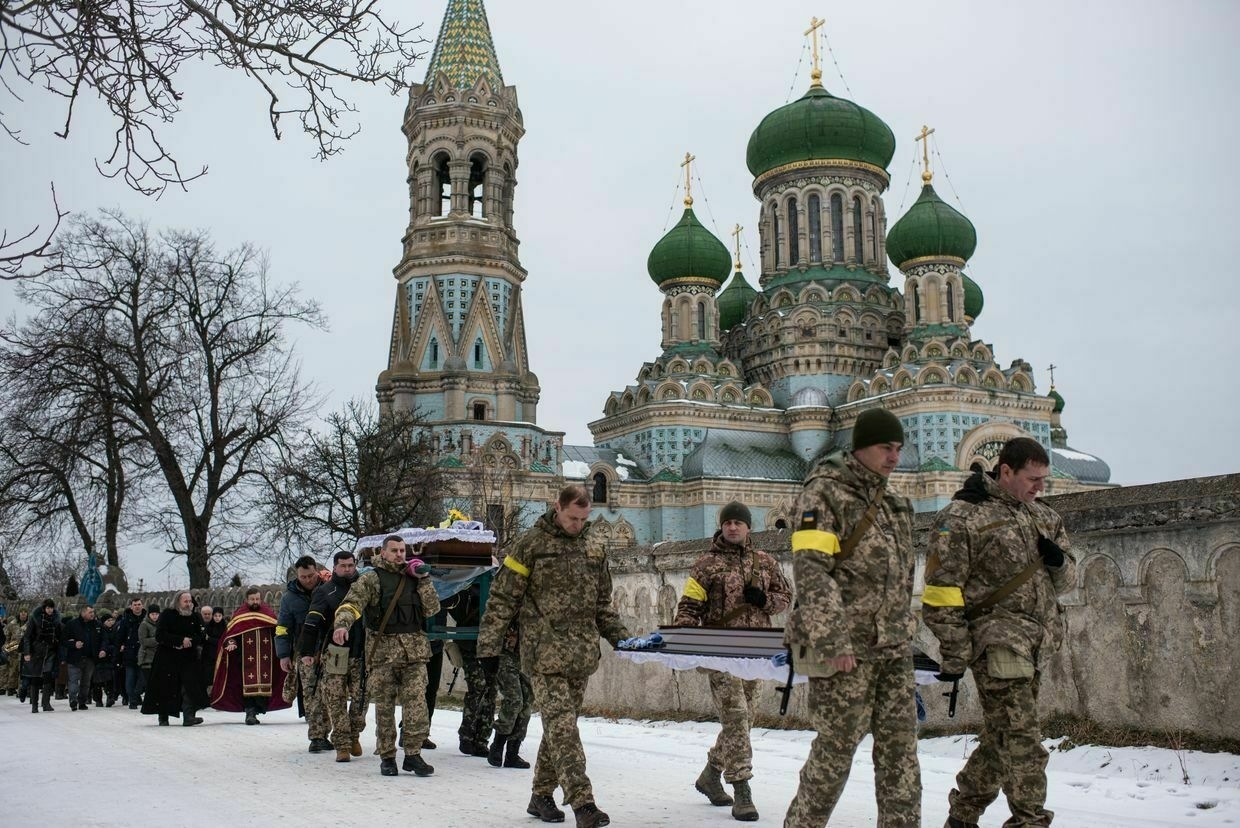
Migration, language, and Zakarpattia in fluxBut no matter how cautious locals are in discussing politics, world events have had a major impact on the community.
Orban has consistently accused Ukraine of infringing on the rights of the Hungarian minority, focusing his criticism on the 2017 laws expanding the use of Ukrainian in education. The legislation — which is yet to enter into force — was designed to counter decades of Russification, but Budapest has cast it as discrimination against the Hungarian minority.
"People are afraid that these changes may cause their children to lose the opportunity to learn freely in their native language," Antipov says. "The Hungarian minority is worried about losing its linguistic identity and is afraid of assimilation."
It's not the language laws that are the threat to the Hungarian community: "it's depopulation."

A portrait of Andrii Liubka in the office of the Institute for Central European Strategy in Uzhhorod, Zakarpattia Oblast, Ukraine on May 22, 2025. (Elena Kalinichenko/The Kyiv Independent)
However, Liubka comments that it's not the language laws that are the threat to the Hungarian community: "it's depopulation."
While 150,000 residents declared themselves ethnic Hungarians in the 2001 census data, this number is believed to have dropped — as Liubka and Diatchuk say — to around 70,000-80,000. Many residents, especially the youth, have left for Hungary, with the migration only accelerated by the invasion.
For many, efforts to start a new life in Hungary have been challenging, suggesting some might return once the war is over, locals say.
"We, ethnic Hungarians from Zakarpattia, will always be foreigners in Hungary. We will be Ukránok (the Hungarian word for a Ukrainian)," Antipov says.
The war is also simultaneously bringing people from Ukraine's war-torn eastern regions, changing the societal fabric and causing tensions.
"Our Transcarpathians are practically gone now, everyone is newcomers, displaced persons, all strangers," says Andzhelika, a Ukrainian resident of Vynohradiv, a town 30 kilometers east of Berehove.
"Our people (Hungarians) have left Ukraine… Many families have been separated. Women are here, men over there," laments Andrea Grita, a Hungarian shopkeeper from Berehove.
Andrea says that her eldest daughter has lived in Hungary for six years. Her son, who will soon turn 18 — the age at which male citizens of Ukraine cannot leave the country during martial law — is studying there.
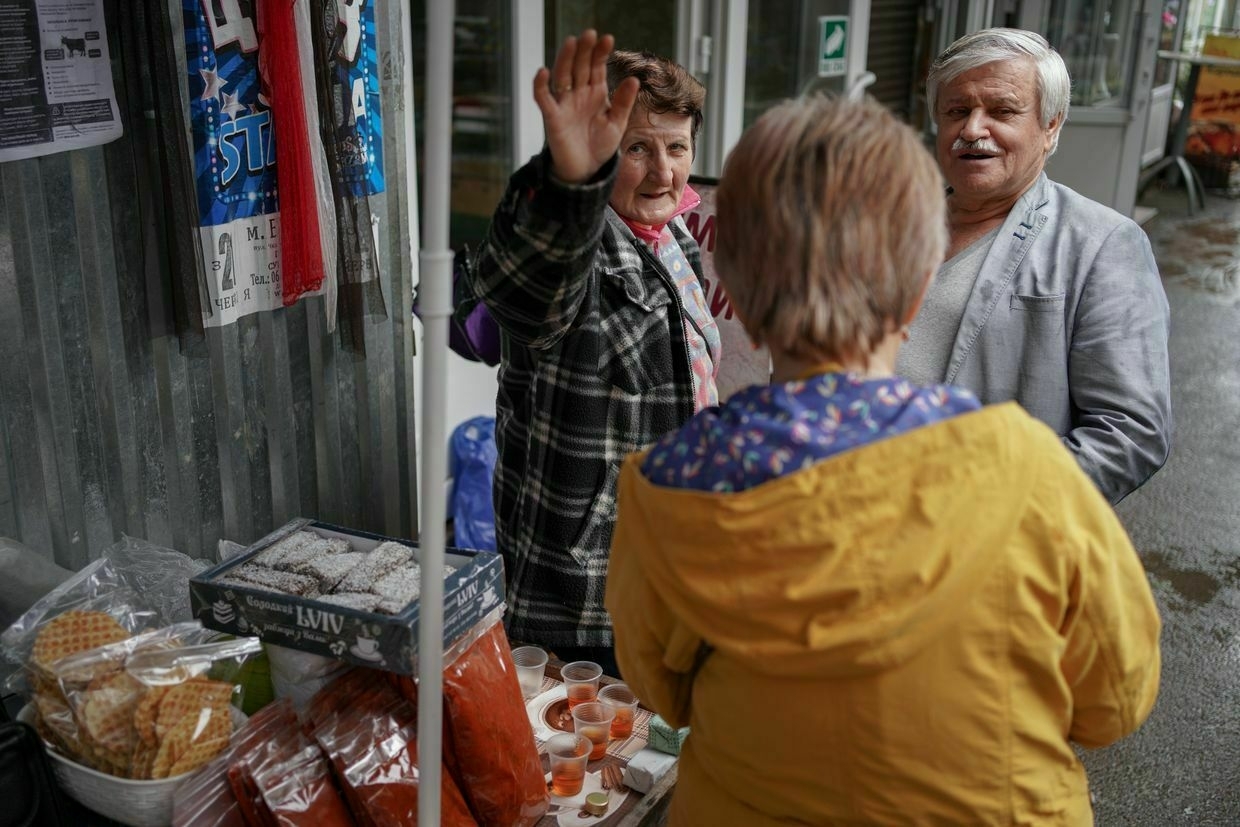
A local market in Vynohradiv, Zakarpattia Oblast, Ukraine on May 22, 2025. (Elena Kalinichenko/The Kyiv Independent) Some of the impacts are not unique to Zakarpattia. Many locals complain about rising prices and the economic downturn, or see newcomers with distrust.
"Since the war began, people don't help each other anymore. And everyone keeps quiet," says Zhanna Kokosh, a stallkeeper at the Berehove market. Holding both Hungarian and Ukrainian citizenship, she finds it difficult to classify her identity.
For Zhanna, the fighting itself feels distant. Her main concern is the hardship facing Berehove's elderly, the poor, and abandoned animals. A stray dog lies under her stall as she speaks.
"Nobody wants to fight. What for? Why should the boys be taken?" she asks. Zhanna expresses frustration that the town's poor are being overlooked while newcomers enjoy greater material security.
"They (newcomers) don't like it when we speak Russian or Hungarian," she adds. "But that's just how we speak... War or no war."
Anxieties of warThe Russian invasion has fueled anxieties among local Ukrainians, further fanned by disinformation.
Andzhelika mentions that only a few months after the start of the full-scale war, an unspecified Ukrainian media publication spread claims that Hungarian forces were massing near the border for an invasion.
In response, the locals organized regular patrols with dozens of cars, which — as the publication asserted — made "Orban afraid to send in troops here," Andzhelika adds. She herself voices uncertainty about the story, recalling she saw no Hungarian troops at the border at the time.
"They understand their connection to the state, the place they grew up, they live in… there are units with many Hungarians that are supported by Hungarian civil society organizations."
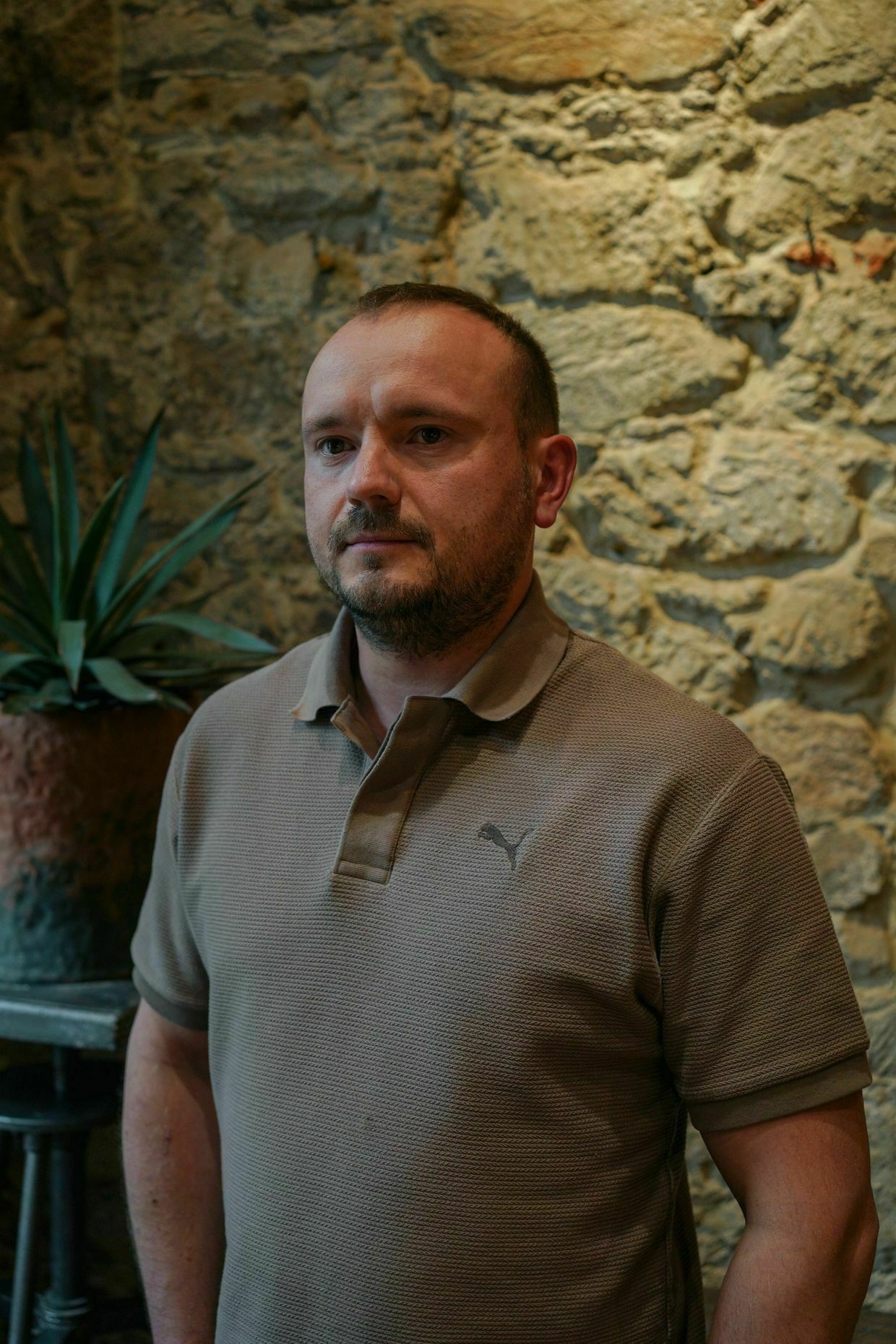
A portrait of Vitalii Diachuk in the office of the Institute for Central European Strategy in Uzhhorod, Zakarpattia Oblast, Ukraine on May 22, 2025. (Elena Kalinichenko/The Kyiv Independent)
The fears surged again after the detention of the suspected spy, who, as Andzhelika offhandedly mentions, worked at a stall not far from her and was known around Vynohradiv.
But the war has also impacted the community in a different way. While some may feel it distant, others are more personally involved — Viktoriia Skoropadska notes that her 54-year-old brother fought in the Zaporizhzhia sector for seven months.
Around 400 ethnic Hungarians have served in the ranks of Ukraine's Armed Forces during the full-scale war.
"They understand their connection to the state, the place they grew up, they live in… there are units with many Hungarians that are supported by Hungarian civil society organizations," Diatchuk says.

A sign with the name of the street in Ukrainian and Hungarian in Berehove, Zakarpattia Oblast, Ukraine on May 22, 2025. (Elena Kalinichenko/The Kyiv Independent) Others contribute to the struggle financially. Local initiatives and communities "allocate their budgets to support either specific units, or to purchase drones, or as one-time payments to mobilized community members," Liubka adds.
As before the war, the picture of the Hungarian community is one of many faces. In some cases, the Russian invasion and Orban's rhetoric stoked anxieties and division. For others, it was an incentive to take up arms to join what Antipov calls a "common struggle."
Whether fractured or galvanized, Zakarpattia's Hungarians must find their place in a region that is being deeply transformed by the war, migration, and the fallout of grand politics.
The Hungary-Ukraine spy scandal and Russia’s possible role, explainedUkraine’s rocky relationship with Hungary reached new lows this month with the uncovering of an alleged spy ring run from Budapest. Arrests, tit-for-tat expulsions, and a stream of accusations from Hungarian Prime Minister Viktor Orban soon followed in a diplomatic scandal with potentially massive ramifications for both countries. “This isThe Kyiv IndependentYuliia Taradiuk
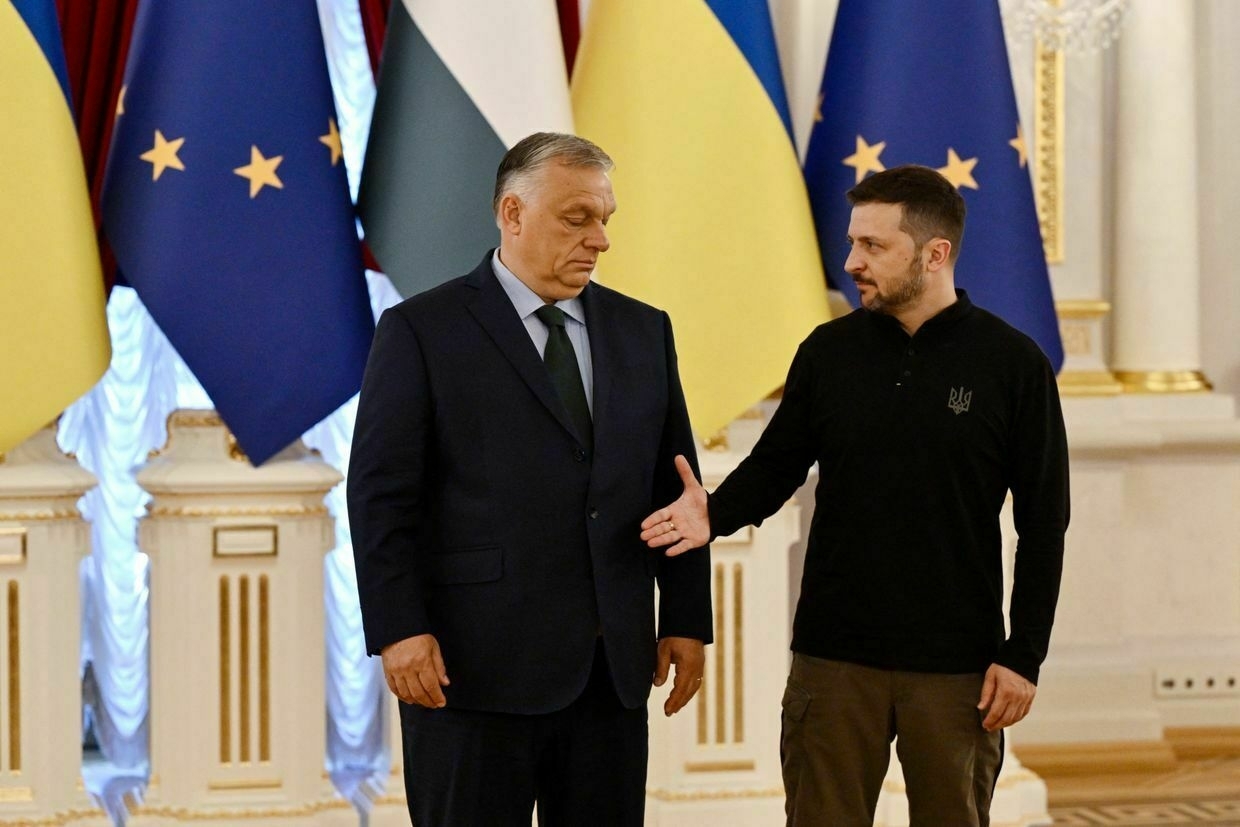
-
Russia hands over bodies of its own soldiers in recent exchange, Kyiv says
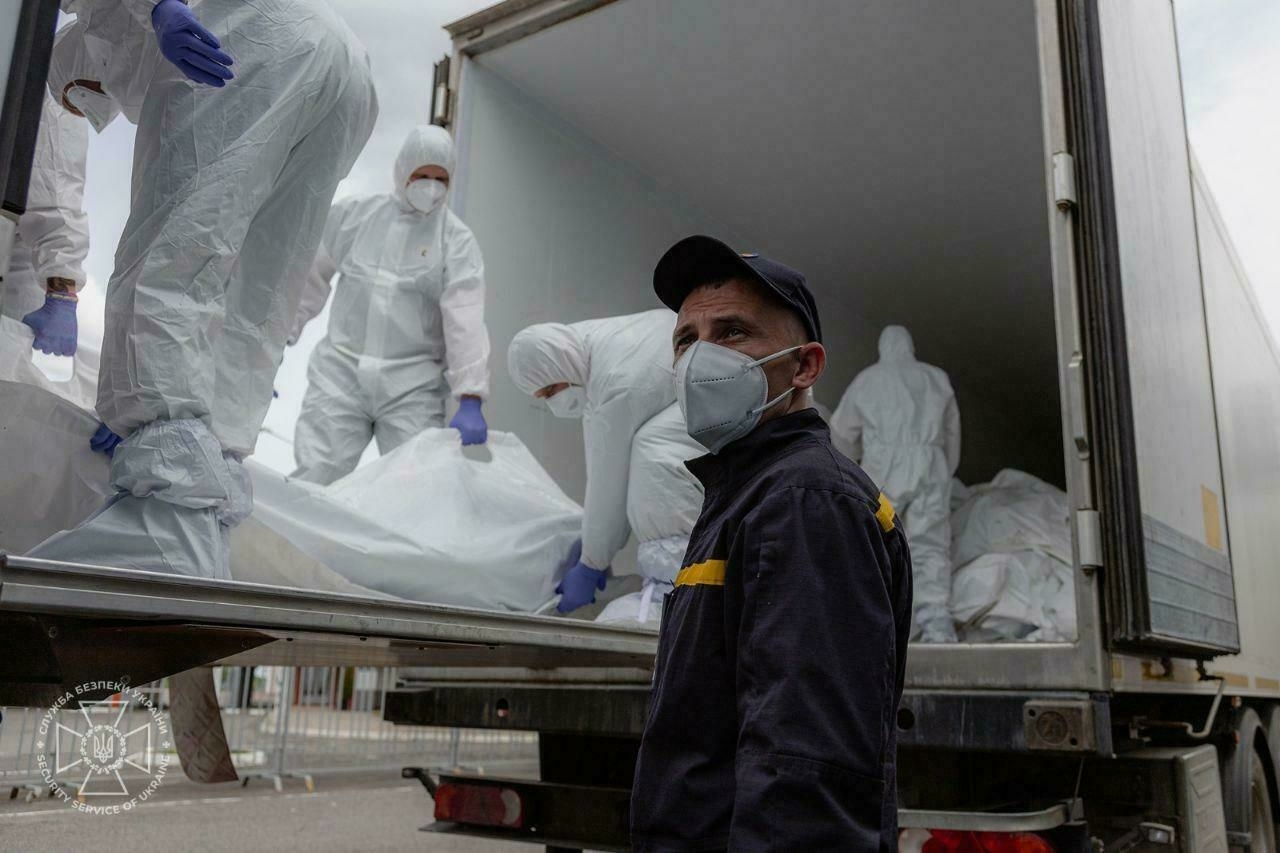
Russia has handed Kyiv the bodies of its own soldiers mixed in with those of Ukrainian soldiers during recent repatriation of the fallen, Interior Minister Ihor Klymenko said on June 16.
Klymenko’s statement follows the completion of an exchange between Ukraine and Russia of the remains of soldiers killed in action earlier the same day, under agreements reached during recent peace talks in Istanbul.
Kyiv returned a total of 6,057 bodies. Vladimir Medinsky, an aide to Russian President Vladimir Putin and member of the Russian delegation at the Istanbul talks, claimed that Russia received the bodies of 78 deceased servicemen.
According to Klymenko, the identification process has been significantly complicated by the condition in which Russia returned the bodies.
“Parts of the bodies (of fallen soldiers) are in different bags. There are cases when the remains of one person are returned even during different stages of repatriation,” the minister said.
Klymenko said that Russia may have included the bodies of its own soldiers in the transfer to Ukraine either on purpose or by accident.
“This could have been done by the Russians on purpose to increase the number of bodies transferred and to load our (forensic) experts with work, adding to all this cynical information pressure. Or it could be their usual negligent attitude toward their own people. In any case, we also identify these bodies,” Klymenko said.
The June 2 negotiations in Istanbul resulted in the most expansive prisoner and body exchange agreement of the full-scale war, although no ceasefire was reached.
The deal followed the largest-ever POW swap in late May, when 1,000 prisoners were exchanged on each side. Additional exchanges last week included severely wounded and sick soldiers.
Russia accused Ukraine on June 7 of rejecting a proposed body return, publishing footage allegedly showing Ukrainian corpses stored in refrigeration units. Kyiv dismissed the claims, saying the footage was filmed inside Russia and not at a designated exchange location.
Ukraine’s Foreign Intelligence Service reported on June 16 that Russia is preparing to escalate a disinformation campaign related to ongoing POW exchanges next week, aiming to provoke public outrage in Ukrainian society.
From buffer zone to new front: Russia pushes deeper into Sumy OblastIn March 2025, as Ukrainian forces made their final retreat from Sudzha in Russia’s Kursk Oblast, new grey spots began to appear on open-source maps on the other side of the state border, in Ukraine’s Sumy Oblast. For the first time since 2022, when Moscow’s forces retreatedThe Kyiv IndependentFrancis Farrell
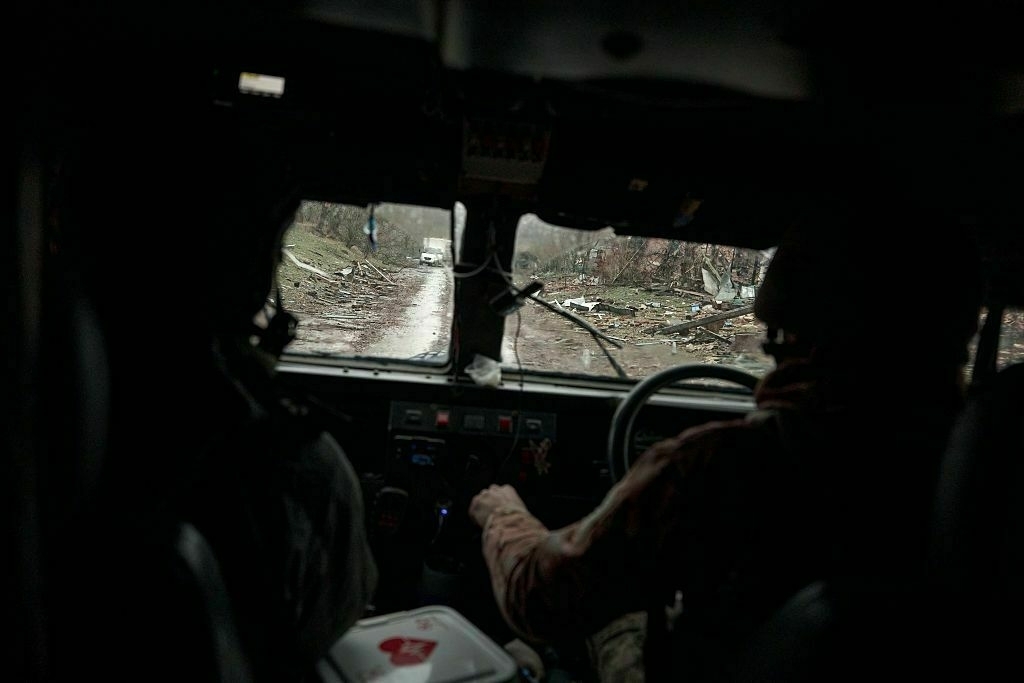
-
US cancels talks with Russia on restoring diplomatic relations, Moscow claims
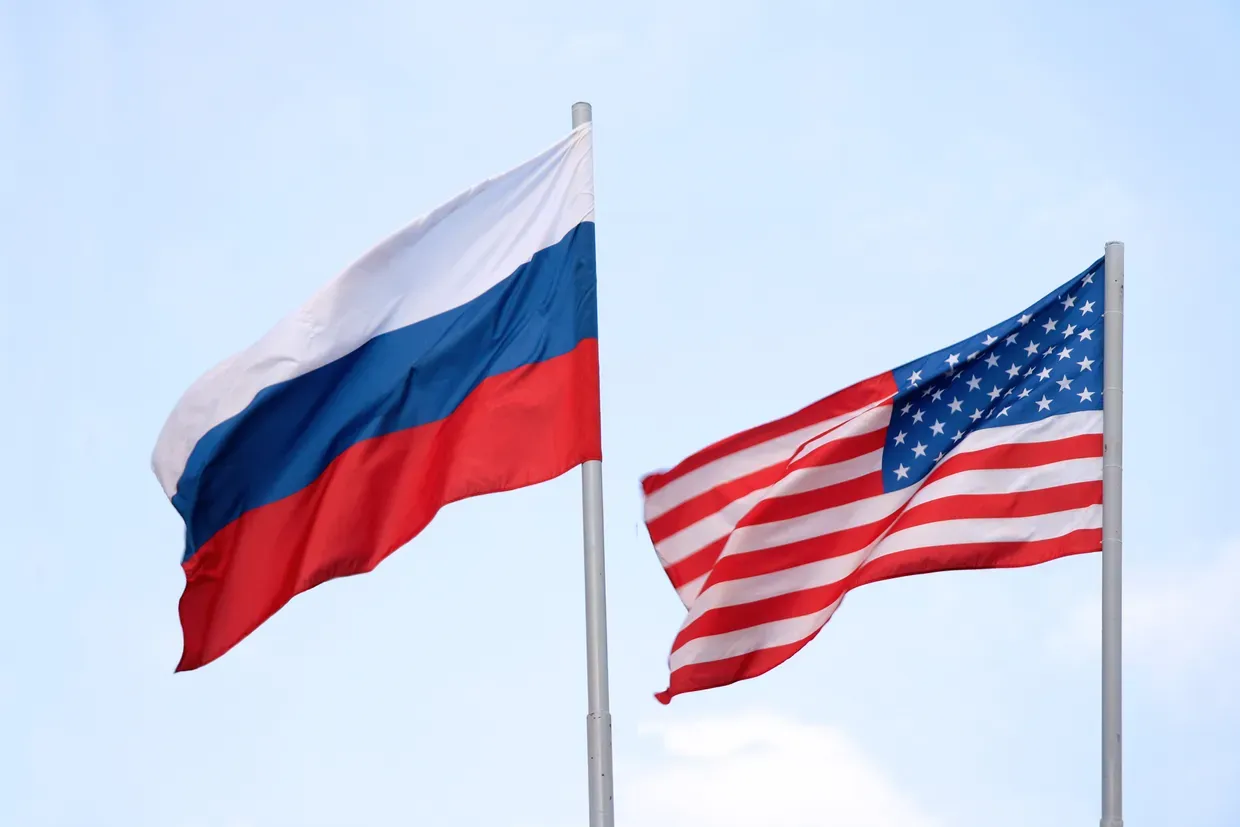
The U.S. has canceled the next round of talks with Russia on restoring diplomatic relations, Russian Foreign Ministry spokesperson Maria Zakharova claimed on June 16.
Zakharova’s statement came days after Russian Ambassador to the U.S. Alexander Darchiev announced that delegations from both countries were expected to meet in Moscow in the near future.
The planned talks were supposed to be part of discussions between the U.S. and Russia that focused on peace efforts in Ukraine and the resumption of bilateral ties.
According to Zakharova, the upcoming round was intended to “eliminate irritants” and help normalize the operations of both nations' diplomatic missions.
“We hope that the pause taken by them (the U.S.) will not become too long,” the Russian spokesperson said.
Washington is yet to comment on Zakharova’s claims.
The first talks since the start of Russia’s full-scale war against Ukraine took place on Feb. 18 in Riyadh, where the two sides discussed bilateral relations, a potential presidential meeting, and ways on ending Russia’s war against Ukraine.
Darchiev said that during the recent round of talks on April 10 in Istanbul, the two sides agreed to move future consultations to their respective capitals.
The U.S. State Department described the April 10 talks in Istanbul as having a “constructive approach.” The closed-door consultations lasted about six hours and focused on ensuring stable banking services for diplomatic missions. Both delegations exchanged notes on the issue and agreed to continue discussions.
The diplomatic push continues amid efforts by U.S. President Donald Trump to broker a ceasefire and peace agreement in Ukraine. Trump suggested on June 5 that it may be better to let the conflict continue for now, likening the war to a fight between children that should not be interrupted too quickly.
Kyiv and its allies remain skeptical of Trump’s approach toward peace efforts.
President Volodymyr Zelensky has repeatedly called for stronger U.S. action and warned that “America’s silence, and the silence of others around the world, only encourages (Russian President Vladimir) Putin."
Russia to demand Ukraine destroy Western weapons to end war, senior Kremlin official saysThe remarks reflect Moscow’s growing list of maximalist demands presented in its so-called “peace memorandum.”The Kyiv IndependentTim Zadorozhnyy
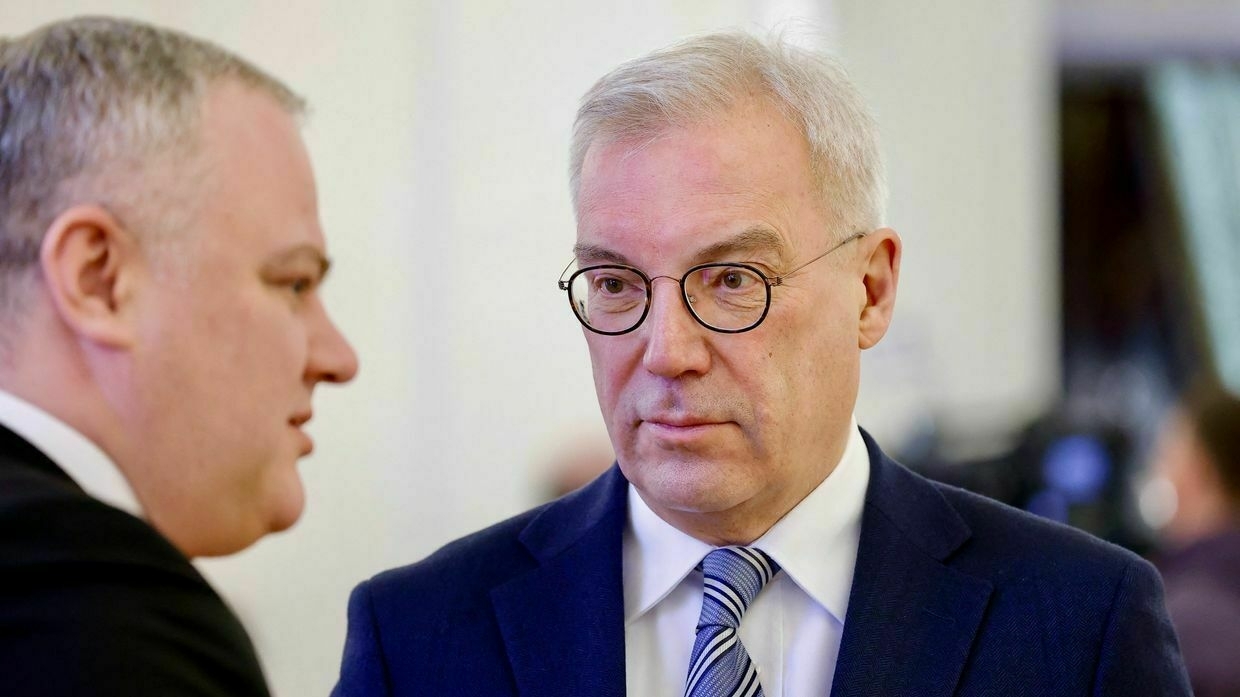
-
Investing in wartime Ukraine requires ‘nuanced understanding of risk’ but is worth it, says head of world’s largest business organization
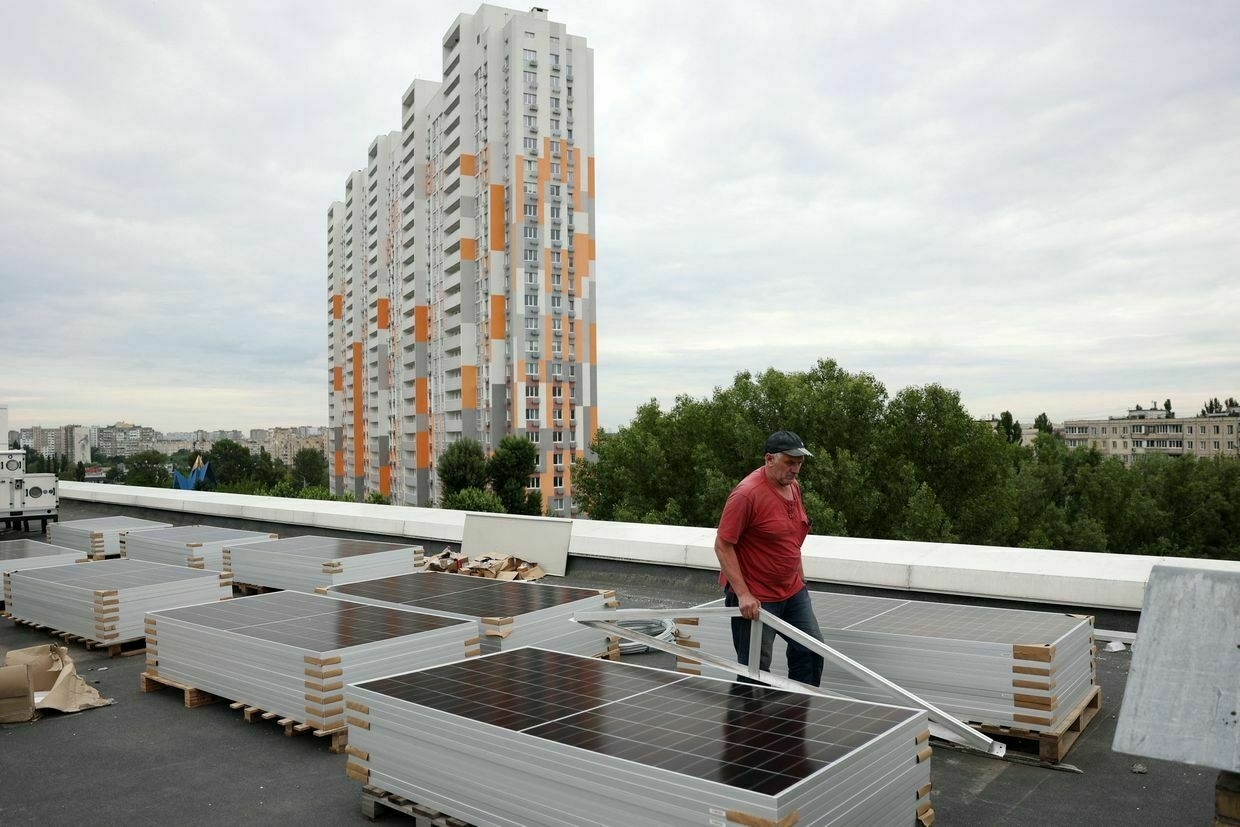
When John Denton first visited Ukraine weeks into Russia’s full-scale invasion, he knew that for the country to survive, businesses needed to stay alive.
Denton is the secretary general of the world’s largest business organization, the International Chamber of Commerce. Active in 170 countries, the organization enables $17.5 trillion worth of economic activity every year, accounting for 22% of the world’s gross domestic product (GDP).
Denton has been a vocal supporter of Ukraine’s businesses and the country’s economic recovery, which is crawling back from the massive 29.1% fall in 2022. The International Chamber of Commerce will attend the upcoming Ukraine Recovery Conference (URC) in Rome on July 10-11, alongside governments and major players in the global private sector.
In a sit-down interview at the Kyiv School of Economics (KSE) on June 12, Denton told the Kyiv Independent how the International Chamber of Commerce has supported businesses in Ukraine, how investors can mitigate risks, and why doing business in Ukraine is worth it despite the wartime challenges.
“There needs to be a more nuanced understanding of risk in Ukraine. It’s not one risk quota for the whole of the country. It helps people understand that there are investable opportunities,” Denton said.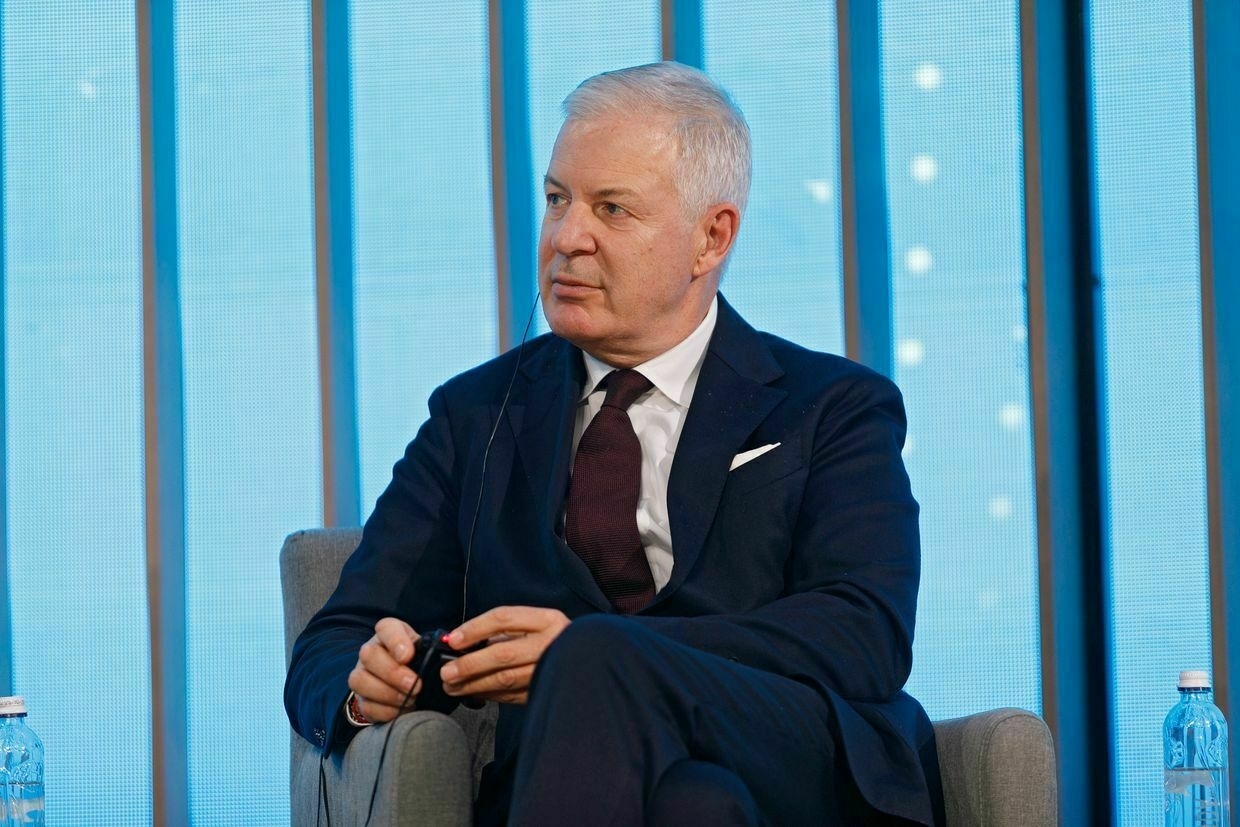
Secretary General of the International Chamber of Commerce (ICC) John Denton attends the “Ukraine and Europe: Toward a Common Future” panel at the Kyiv International Economic Forum in Kyiv, Ukraine, on Nov. 7, 2024. (Ukrinform / NurPhoto via Getty Images) The International Chamber of Commerce has been active in supporting Ukraine’s economic front in partnership with the Ukrainian Chambers of Commerce. This includes the Center of Entrepreneurship, which supports small and medium-sized businesses (SMEs) as well as refugees.
Denton believes Ukraine’s recovery needs a strong private sector and access to global markets. To help build up trust and encourage foreign investors, he announced that the International Chamber of Commerce will cut arbitration costs for foreign investors involved in reconstruction-related disputes in Ukraine during his last trip to Ukraine in November 2024.
This interview has been edited for length and clarity.
Kyiv Independent: This is your fourth trip to Ukraine. What is your current assessment of Ukraine’s business climate?John Denton: The reality is challenging, but Ukraine is not a monolith. There are different opportunities. I drove from Warsaw through western Ukraine, and you can sense that there’s a level of vibrancy in the economy there.
The more challenged regions need focus. It’s hard to attract opportunities and to keep people. At the same time, people are there, paying taxes, keeping businesses running, even in complex places. They need support and want visibility.
It’s going to be much harder to rebuild Ukraine if the economy is not functioning. We’ve always seen the private sector and the functioning of the economy here as the economic front. One dimension is just keeping tax flows moving and businesses running. The other is morale. It’s devastating if you have a collapsed economy plus military challenges.
Subscribe to the NewsletterUkraine Business Roundup<span data-sanitized-id="ukraine-business-roundup-info" data-sanitized-class="ukraineBusinessRoundup__info"></span> <button data-sanitized-id="ukraine-business-roundup-subscribe-btn" data-sanitized-class="ukraineBusinessRoundup__form_button"> <span data-sanitized-class="ukraineBusinessRoundup__form_label">Subscribe</span> </button> </div>The Kyiv Independent: What would you say to investors who are standing by on the sidelines, waiting for the war to end before putting their money into Ukraine?
John Denton: They've got to make commercial decisions in the best interests. You have to make certain your risk appetite matches the risk that's available.
There's a different level of risk for the allocation of capital in this place. Existing businesses here tend to understand that a little better. The investment you're seeing in Ukraine is coming from existing businesses that understand the terrain. They're reinvesting in the economy, and those investments are often very successful.
You can't completely de-risk, but you can take away some of the extraordinary risks.
The danger with waiting too long is do you then have the relationships in place to participate in the rebuild? That's going to be one of the challenges.
There's a lot more that can be done to facilitate de-risking. You can't completely de-risk, but you can take away some of the extraordinary risks.
We can help export agencies understand that their participation is really important to allow companies to close deals here. Some of them can only provide coverage up to 97%. That (missing) 3% matters. At the URC, we're helping export agencies understand this and problem solve risk coverage.
Ukraine’s long-awaited weapons tech investment boom is finally kicking offUkrainian weapons startups are finally seeing an inflow of funds from Western investors who have long been intrigued by the Ukraine’s defense tech sector but have so far kept their money out of the war-torn country. Financial analysis firm Pitchbook provided the Kyiv Independent with data showing a four-fold riseThe Kyiv IndependentKollen Post
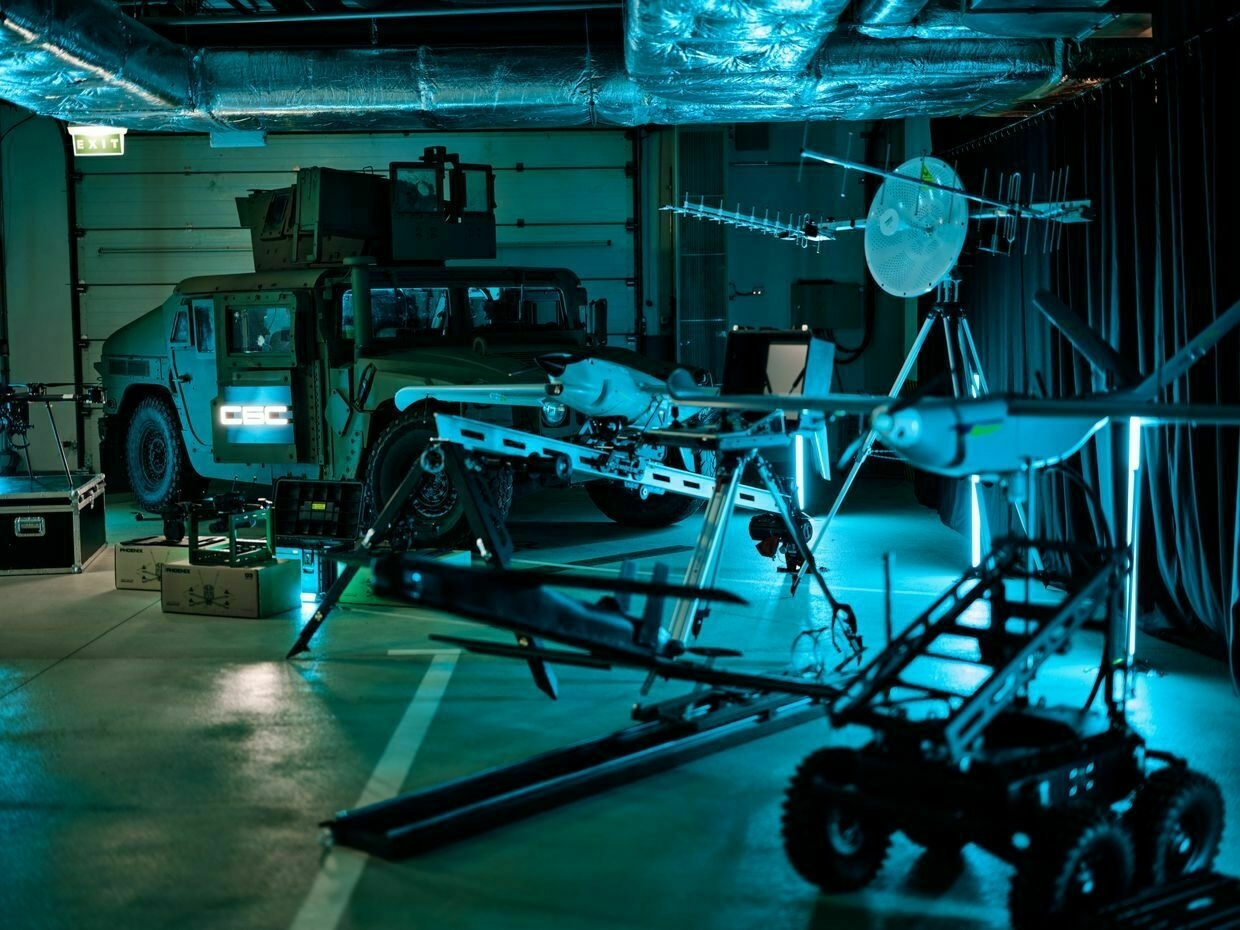
Kyiv Independent: What are the barriers to foreign and domestic investment in Ukraine, and how are you helping break those down?
John Denton: There's just the reality that there's a war going on. It inhibits one's decision-making, but it doesn't mean you don't make the decision.
The other is that there are issues with the application of the rule of law here. We've come up with a solution which I know the Ukrainian government is very happy with – if people are worried that that's an inhibitor, we will use the International Chamber of Commerce Court of Arbitration. You can be 100% sure of the independence.There's still a perception of corruption. Many say the country is different than five years ago or before the war. That's true. But sentiment clouds upfront decision-making.
The other thing is, do we actually have clear investment frameworks? Has the government articulated key priorities? Do you want to attract investment only into the most complex areas of Ukraine, or are you neutral as to where it is? There is a risk of mixed messages.
I think the government and the private sector here are working on all those areas. We're seeing better presentation and understanding of projects capable of attracting capital.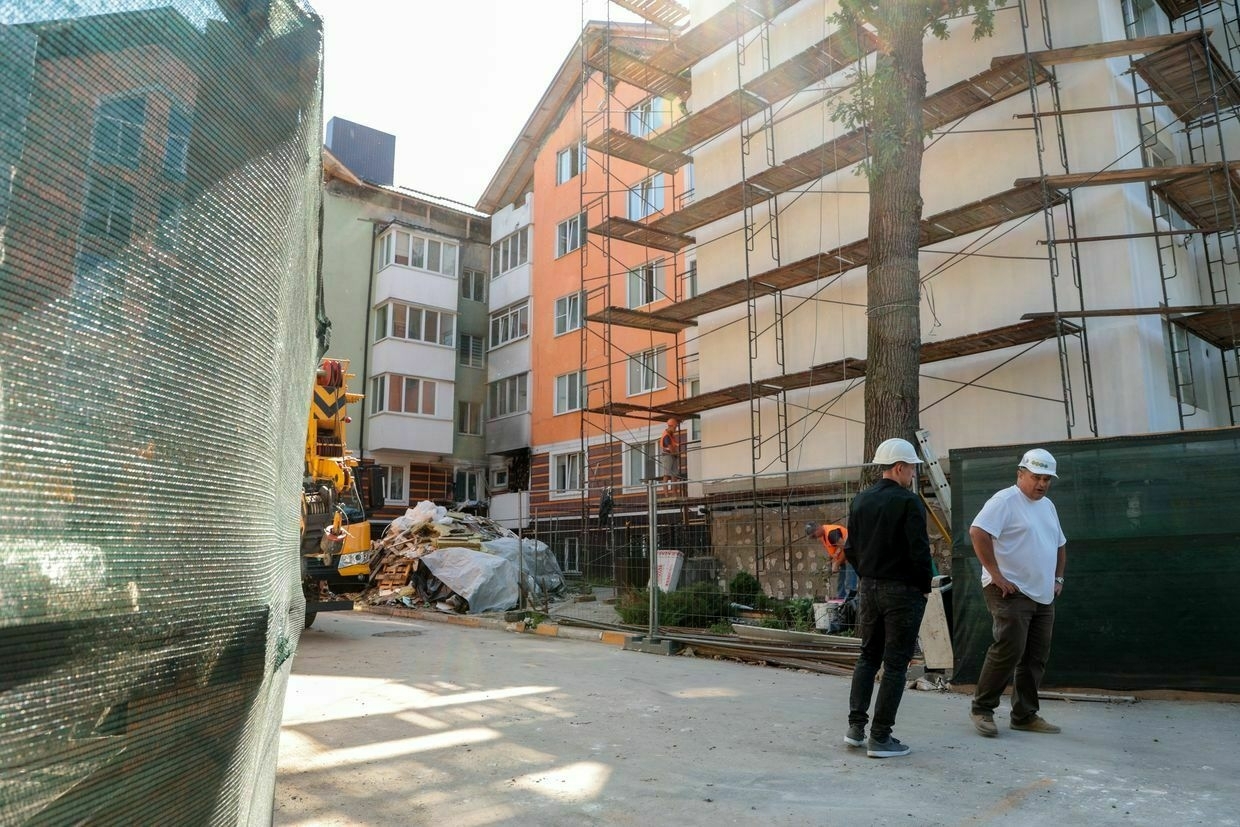
Ukrainian authorities restore residential buildings destroyed by Russian forces in the suburbs of Kyiv, Ukraine, on Aug. 1, 2023. (Sergii Kharchenko / NurPhoto via Getty Images) Kyiv Independent: Have we seen any results yet from the decreased arbitration costs?
John Denton: It’s too early to tell. There's certainly a lot of interest in it. It's creating an ecosystem of confidence around settling disputes.
Kyiv Independent: The Ukraine Recovery Conference is taking place in Rome next month. Is reconstruction being taken seriously despite there being no end to the war in sight? What can we expect from the International Chamber of Commerce at the conference?
John Denton: There is increasing interest from the private sector about how to manage the risks that will be involved in the reconstruction of Ukraine. And that's why we're involved.
There is a particular challenge with export finance that needs to be thought through. We will be using the URC as a great convening space to do that. The other is more broadly around identifying the inhibitors to private sector engagement in this process and coming up with a roadmap to actually remove those barriers.
The URC creates space for these discussions. We hope this starts more aggressively, not just on future reconstruction, but reconstruction now. To rebuild on a broken system is much harder than if we have a functioning private sector and economy now.Note from the author:
Hi, it’s Dominic, thank you for reading this story. Investment and the role of the private sector in rebuilding Ukraine is going to be a hot topic at the upcoming Ukraine Recovery Conference in Rome this July. For now, many investors are holding back their money, but John Denton makes a good point that it's important to invest now to keep the economy alive. To help us keep you up to date with all the latest news from Ukraine, please consider becoming a member.
Ukraine must look beyond the EU for its agricultural futureThe end of the European Union’s tariff-free trade preferences for Ukrainian agricultural products is more than just a policy change, it’s a wake-up call. For years, the EU has served as the largest and most reliable market for Ukraine’s agricultural exports. But as Brussels rolls back preferentialThe Kyiv IndependentMark Iwashko
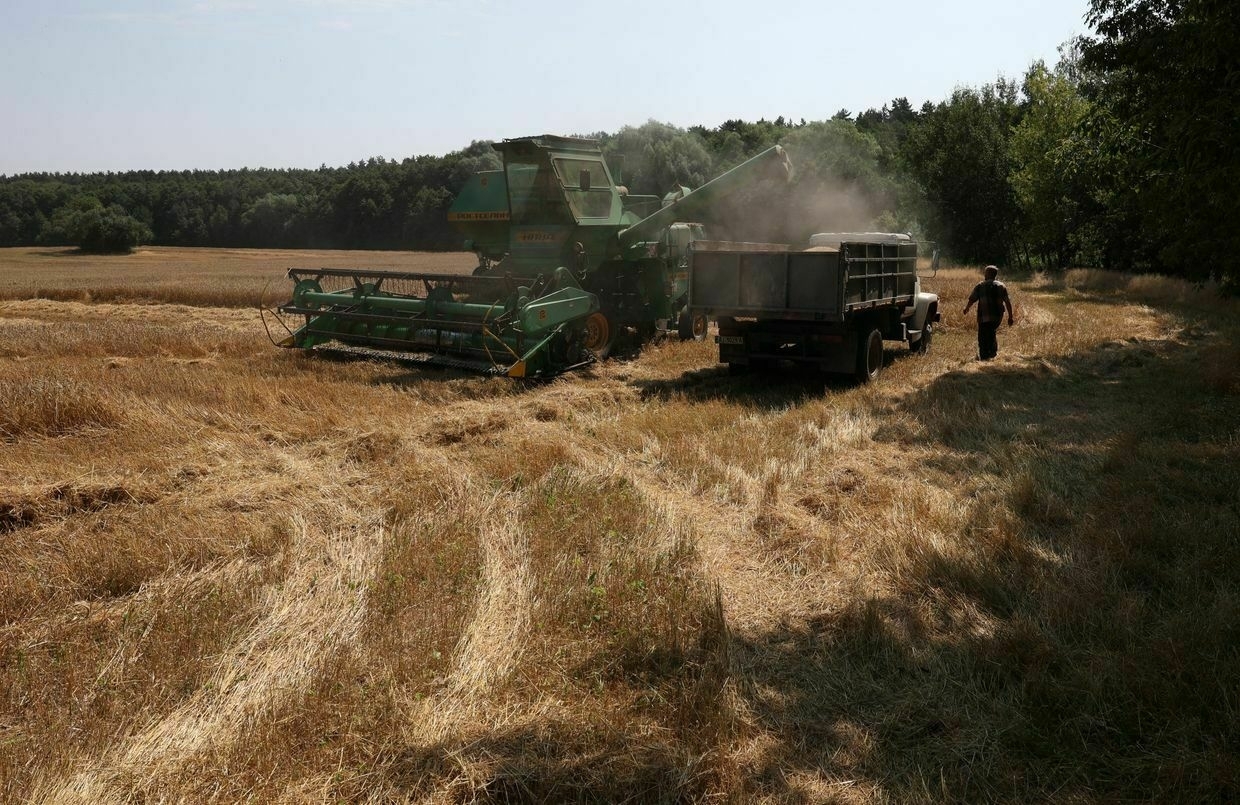
Zelensky in Austria talks about reconstruction, return of abducted children, punishing oligarchs
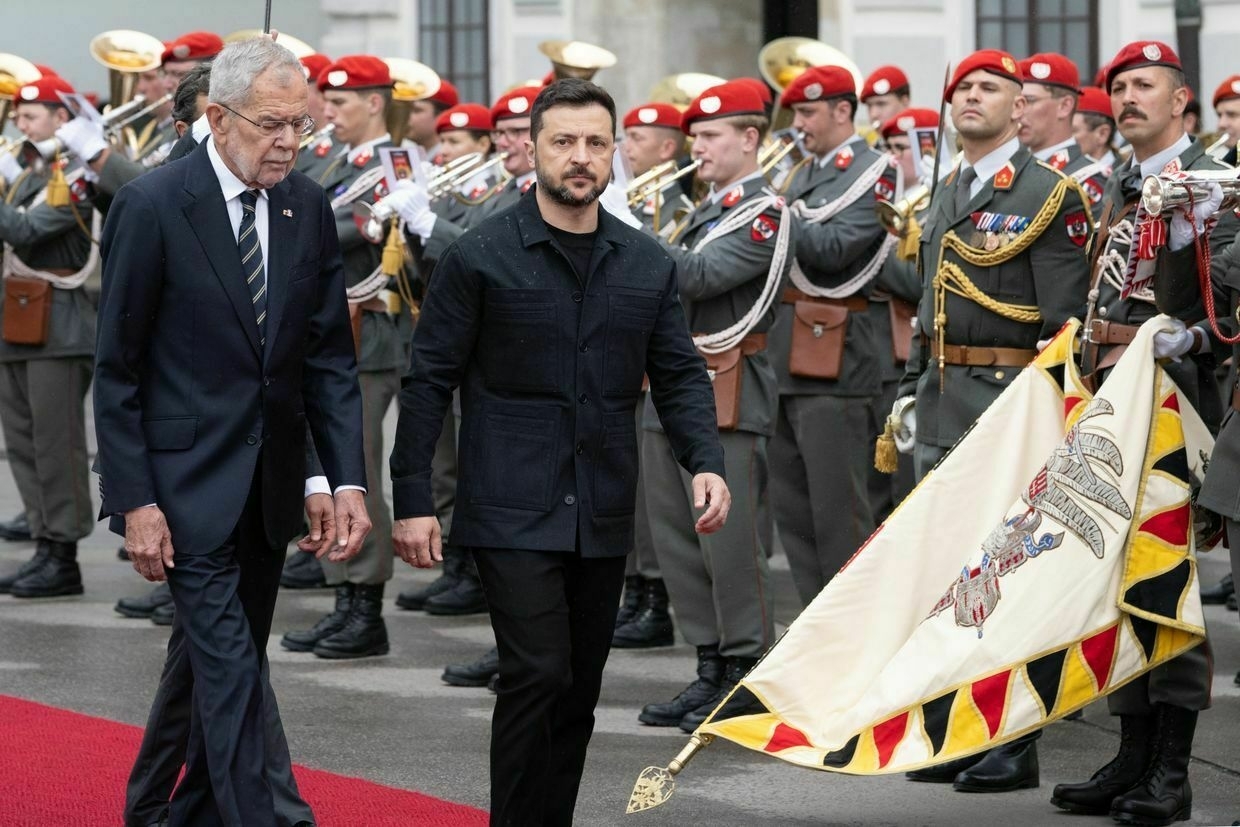
President Volodymyr Zelensky and his Austrian counterpart Alexander Van der Bellen signed documents on bilateral cooperation between the two countries during Zelensky’s visit to Vienna on June 16.
Speaking at a joint press conference, Zelensky said that the agreements cover key areas including agriculture, reconstruction, and return of abducted Ukrainian children from Russia.
Zelensky’s visit to Austria comes a day before his scheduled trip to Canada, where he will attend the Group of Seven (G7) summit on June 17.
While at the summit, he is expected to meet with U.S. President Donald Trump to discuss, among other topics, a potential purchase of a U.S. military aid package.
According to Zelensky, discussions at the G7 summit will include the fate of Moscow’s frozen assets and the imposition of further sanctions on Russian energy exports.
Before leaving Vienna, Zelensky is expected to meet with Austrian Chancellor Christian Stocker to push for stronger sanctions against Russia.
“We are counting on Austria’s support, both at the state and societal levels, on a sensitive issue for Ukraine: the presence of former Ukrainian officials and oligarchs who are evading justice by hiding in Europe, including Austria, and concealing stolen assets,” Zelensky added.
In 2014, U.S. prosecutors charged Ukrainian oligarch Dmytro Firtash with racketeering and bribery, and he was briefly arrested in Austria before posting bail. The Ukrainian tycoon has so far avoided extradition from Austria’s capital, where he resides.
Other wanted Ukrainian top officials in Austria include ex-chairman of Constitutional Court Oleksandr Tupytskyi. He was charged with unlawfully influencing and bribing a witness to induce false testimony, and giving false testimony himself.
High stakes, low resolve: What Ukraine can expect from the upcoming G7 summitAs world leaders prepare to gather in the remote community of Kananaskis in Alberta, Canada for the Group of Seven (G7) Leaders’ Summit on June 15-17, Russia’s war in Ukraine once again holds center stage — but views on how to address the three-year conflict diverge sharply. In the five monthsThe Kyiv IndependentDmytro Basmat
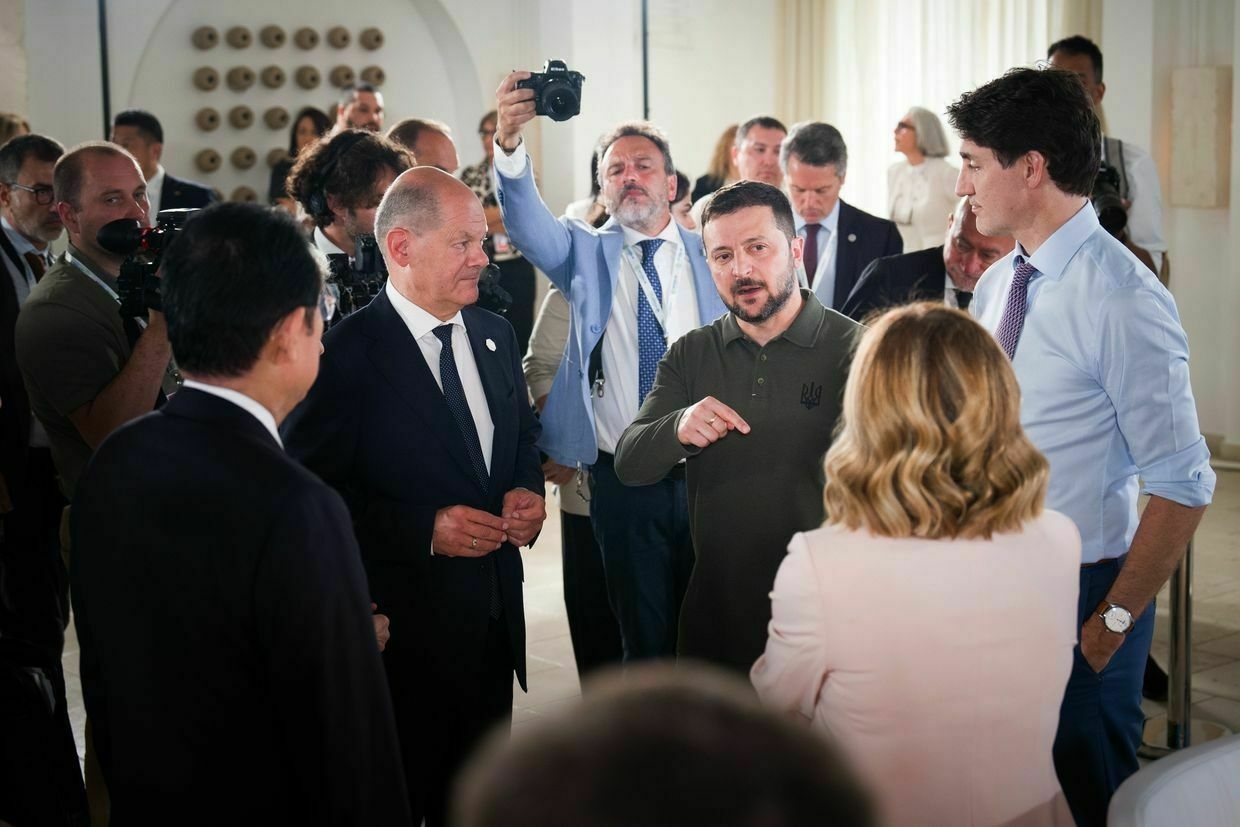
Iran claims new ballistic missile tactic allowed breach of Israeli air defenses
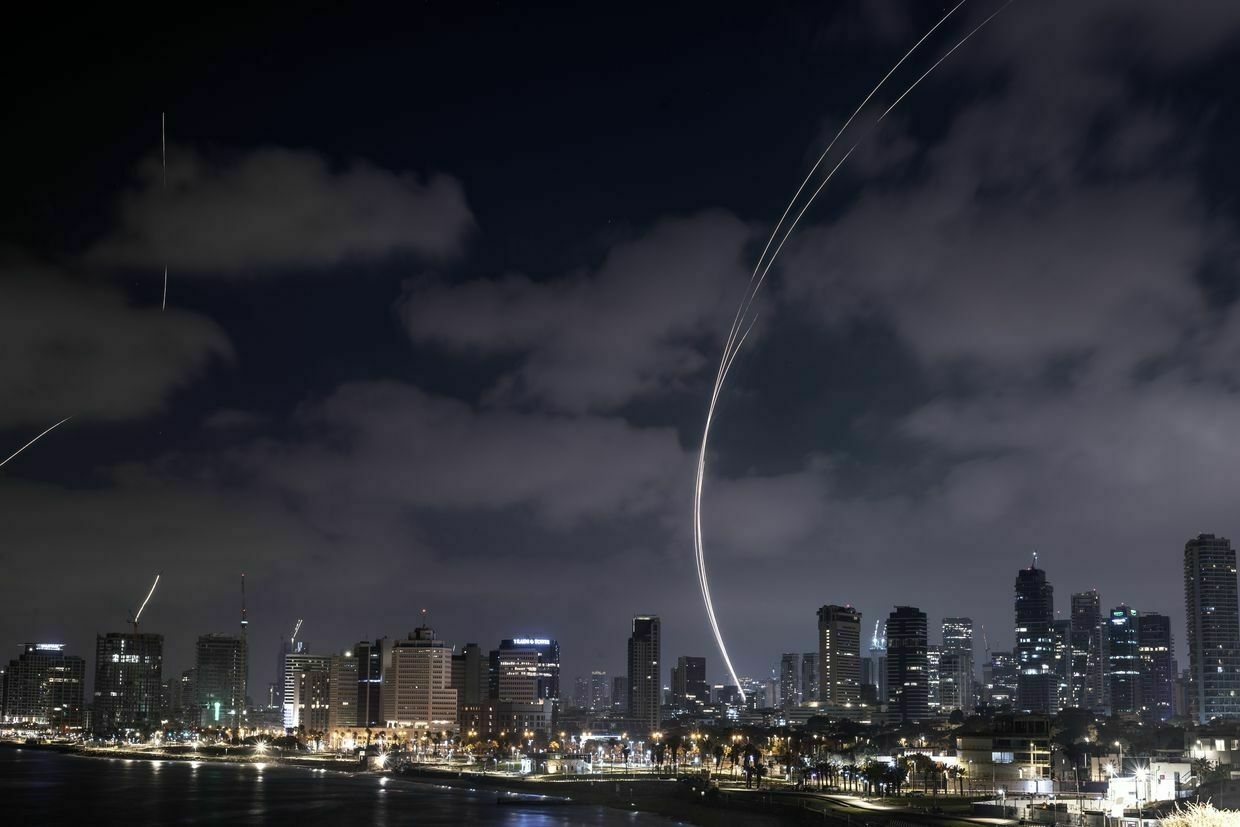
Iran’s Islamic Revolutionary Guard Corps (IRGC) said it used a new method to breach Israel’s air defenses during a missile attack early on June 16, that killed at least eight people, Reuters reports.
According to the IRGC, Iranian missiles were guided in a way that caused Israeli interceptor missiles to target each other, confusing Israel’s integrated defense system, which includes Iron Dome, David’s Sling, and Arrow platforms.
It did not provide any further details.
Ballistic missiles are rocket-powered and are launched high into the atmosphere before arcing back down onto their target.
They’re only guided during the initial stages of launch, so they can be less accurate than cruise missiles, but have the advantage of reaching incredibly high speeds – sometimes more than 3,200 kilometers per hour – as they approach their targets.
Israel’s Defense Forces (IDF) reported for the first time that its systems had an 80-90% success rate intercepting Iran’s ballistic missiles, while roughly 5-10% penetrated the shield and struck populated areas, according to the Jerusalem Post.
The strike came three days after Israel launched a sweeping aerial campaign against Iranian nuclear and military facilities, killing several high-ranking officials, including IRGC aerospace commander Amir Ali Hajizadeh.
Kyiv has expressed support for Israel, describing Iran as a “source of instability in the region and beyond,” citing Tehran’s extensive military cooperation with Russia.
Since 2022, Iran has supplied Moscow with thousands of Shahed kamikaze drones and short-range ballistic missiles for use against Ukraine. Russia, for its part, has condemned the Israeli air strikes on Iran as “unprovoked aggression” and backed calls for restraint.
Israel is home to one of the largest Russian-speaking populations outside the former Soviet Union, with approximately 1 million people — or 15% of the total population — identifying as Russian-speaking. Israel has historically maintained relatively friendly ties with Russia.
U.S. President Donald Trump said on June 15 that he is considering Russian President Vladimir Putin as a possible mediator between Israel and Iran.
As of June 16, Iran’s Health Ministry claims 224 people have been killed since the Israeli air campaign began on June 13 — 90% of them civilians, according to Tehran. Israel has not confirmed the civilian casualty figure, and independent verification remains difficult.
Russia to demand Ukraine destroy Western weapons to end war, senior Kremlin official saysThe remarks reflect Moscow’s growing list of maximalist demands presented in its so-called “peace memorandum.”The Kyiv IndependentTim Zadorozhnyy
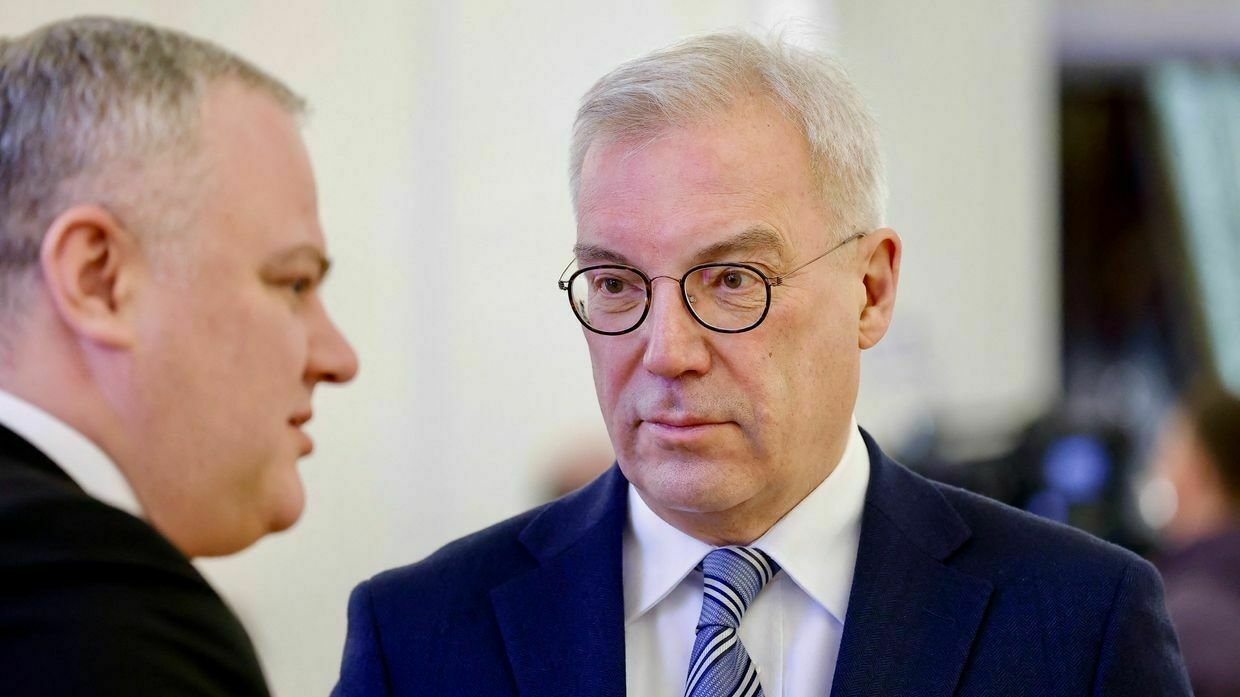
Zelensky's trust rating drops 11 points to 65%, poll shows
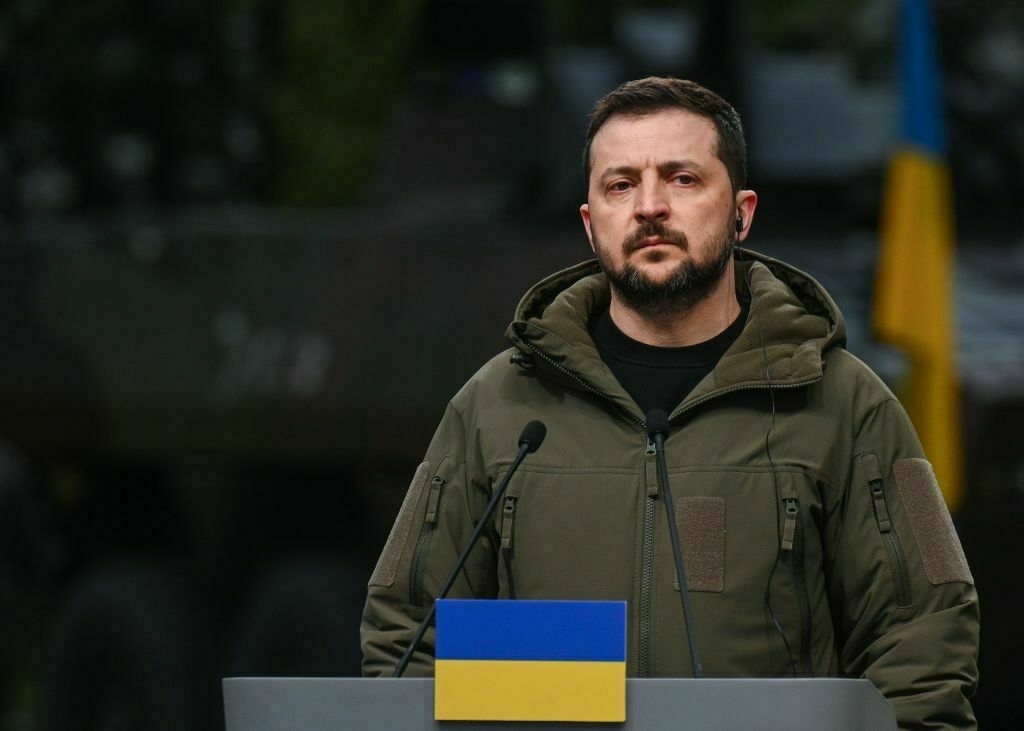
Public trust in President Volodymyr Zelensky has dropped by 11 percentage points since May, according to a poll published by the Kyiv International Institute of Sociology (KIIS) on June 16.
The survey found that 65% of Ukrainians currently trust the president, while 30% do not, yielding a trust balance of +35%, the lowest recorded since March.
Zelensky’s still rating remains above the February 2025 low of 57%.
Sociologists can’t pinpoint a specific cause for the short-term decline but highlight factors such as increasing pressure for a ceasefire and the weakening of the surge of popular support seen earlier this year during tense relations with U.S. President Donald Trump.
Zelensky’s approval had spiked briefly in early May to 74% following the signing of a minerals agreement with the U.S., seen as a diplomatic and economic win. That boost proved short-lived.
The poll shows a stark regional divide. Trust is highest in western Ukraine at 73%, while in the country’s south and east, areas more frequently targeted by Russian strikes, only 61% express confidence in the president.
The data also shows a sharp contrast in attitudes toward territorial concessions. Among those who trust Zelensky, 55% are strongly opposed to any such compromise. Among those who distrust him, 46% are willing to cede territory, while only 43% are firmly against concessions.
The survey was conducted between May 15 and June 3, using a random sample of 1,011 adult residents across Ukraine, excluding occupied territories. Respondents were interviewed by phone.
Russia to demand Ukraine destroy Western weapons to end war, senior Kremlin official saysThe remarks reflect Moscow’s growing list of maximalist demands presented in its so-called “peace memorandum.”The Kyiv IndependentTim Zadorozhnyy
